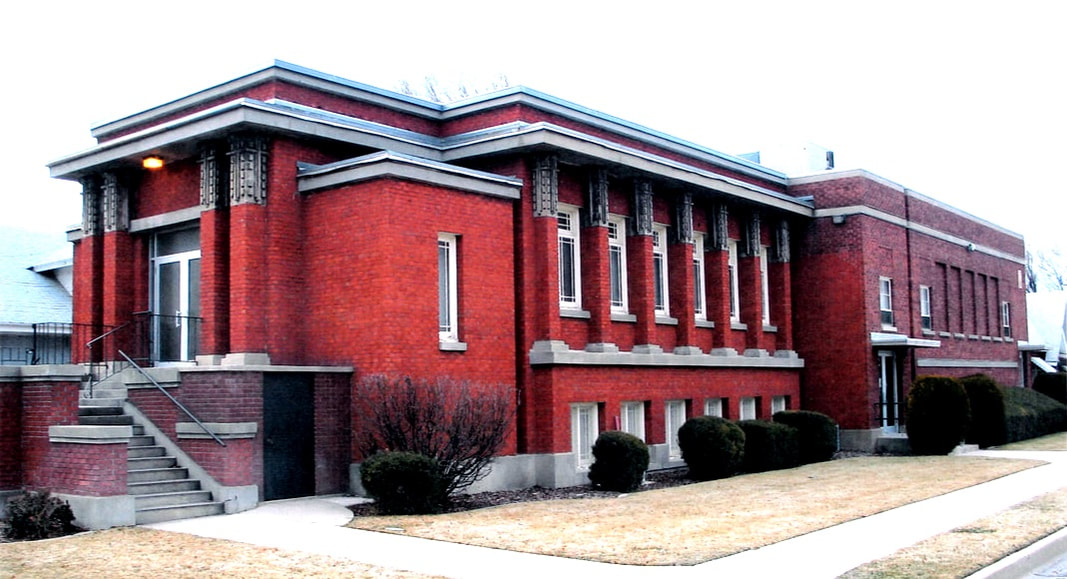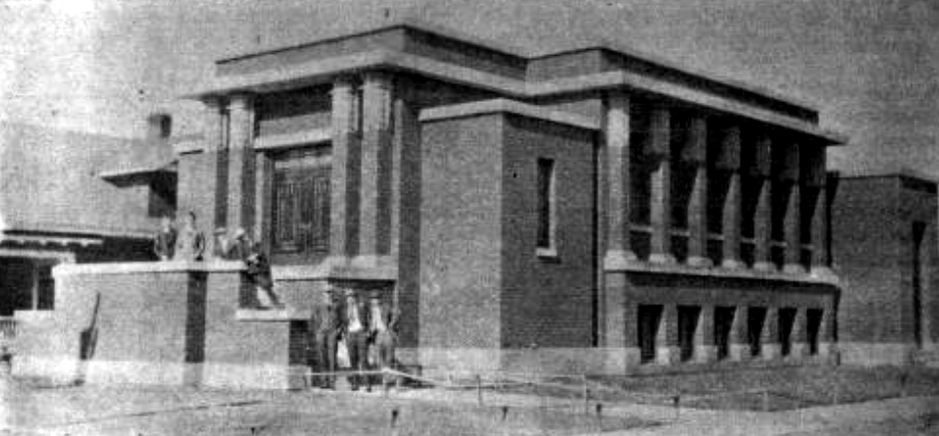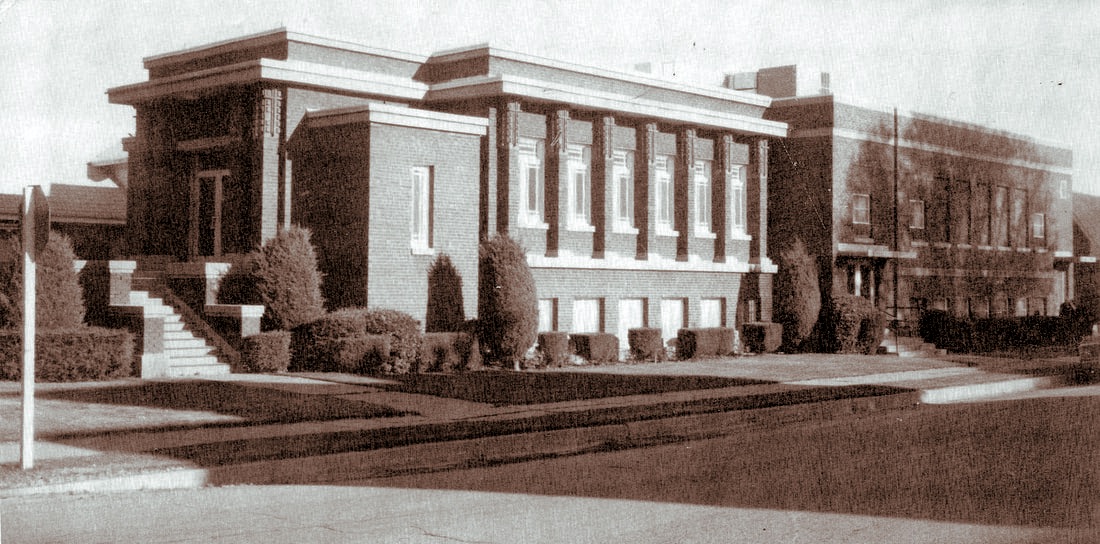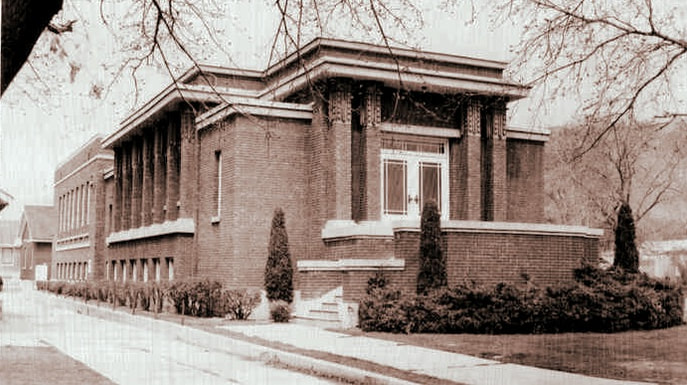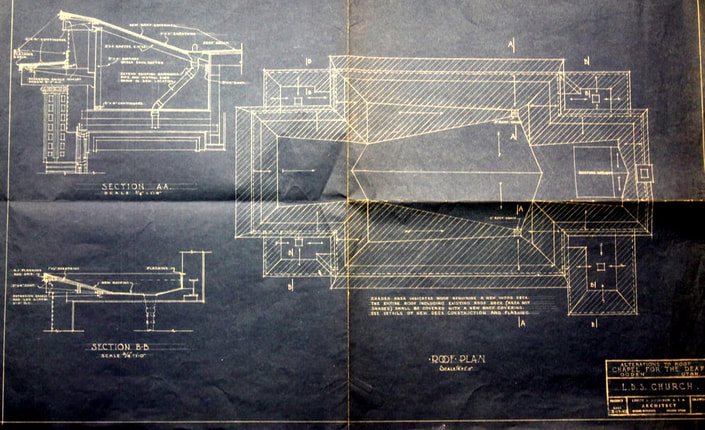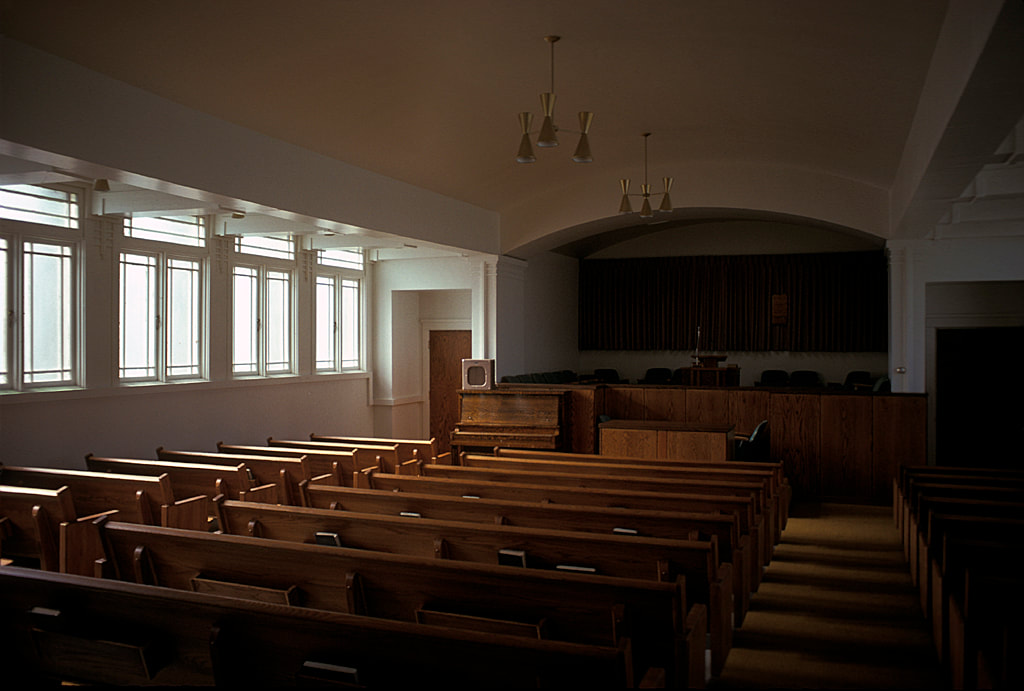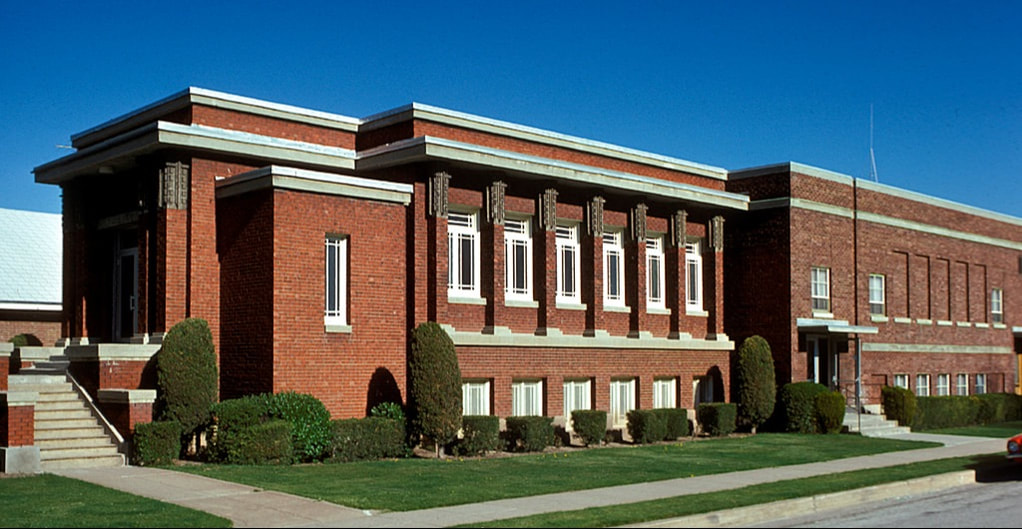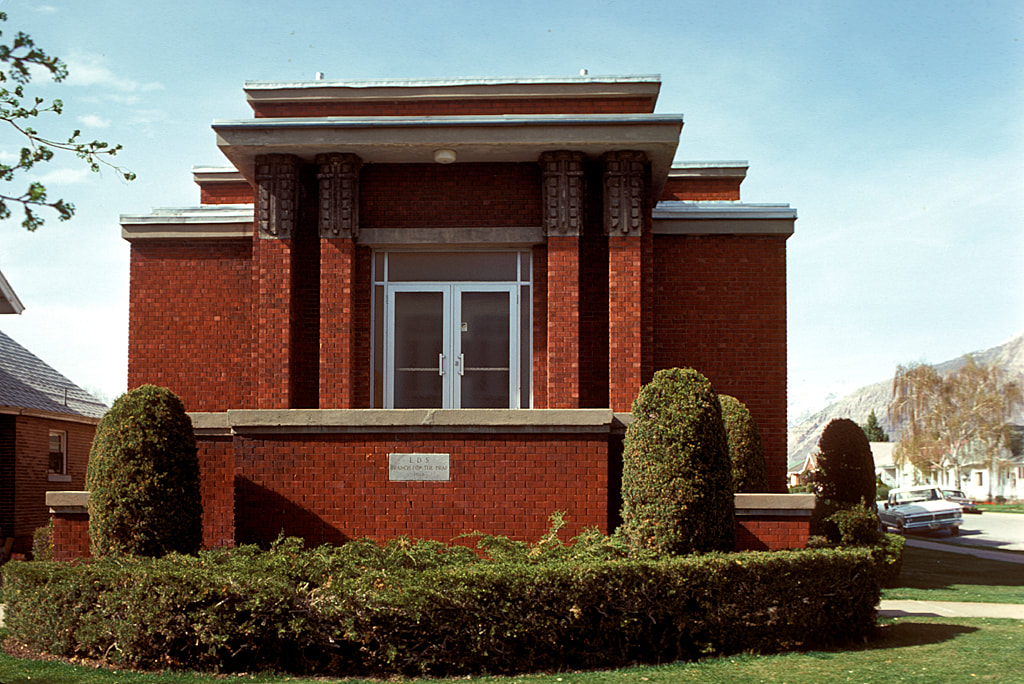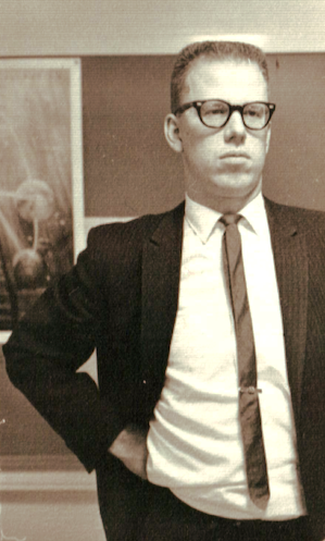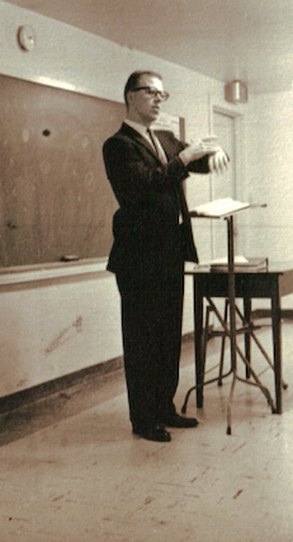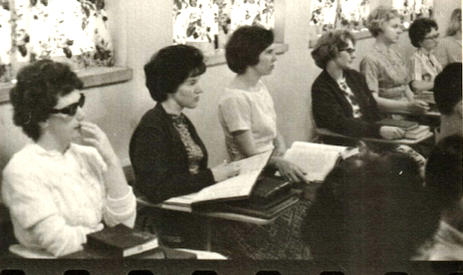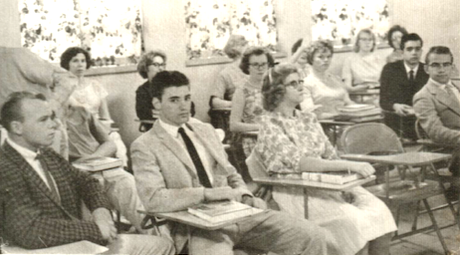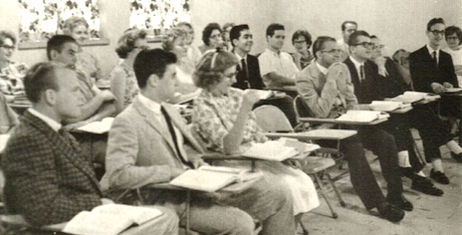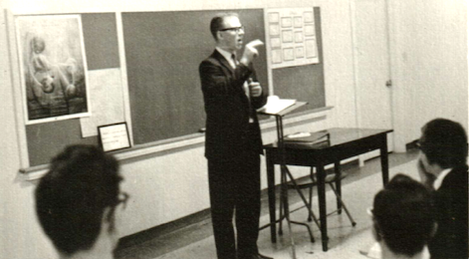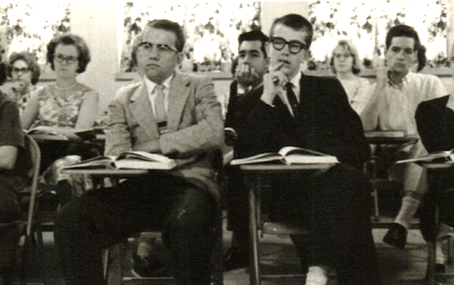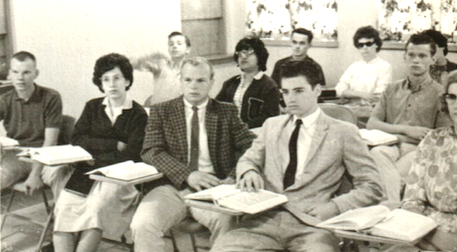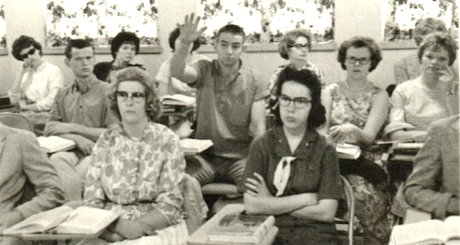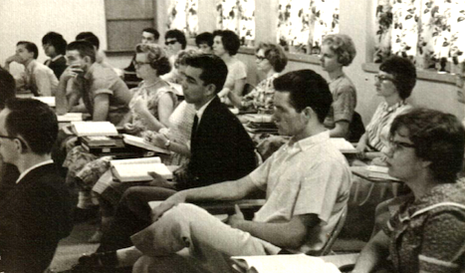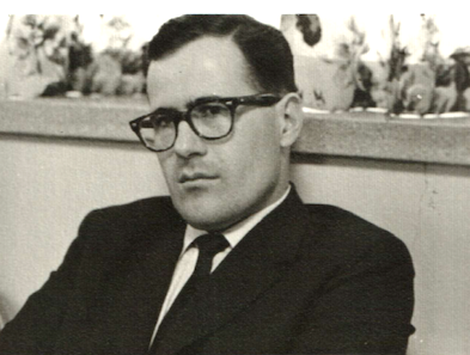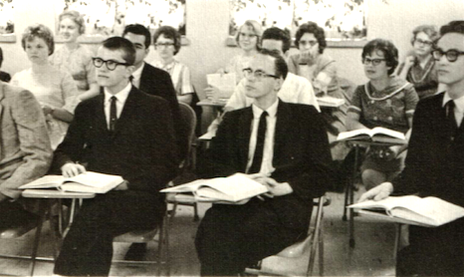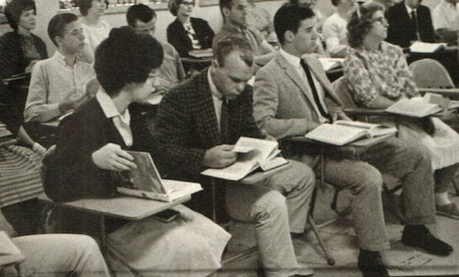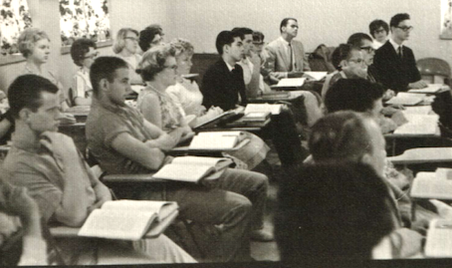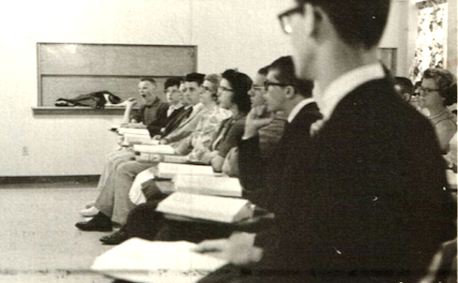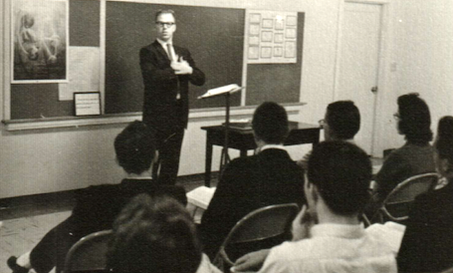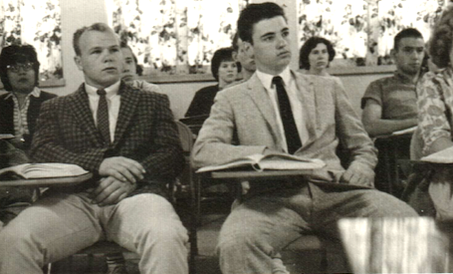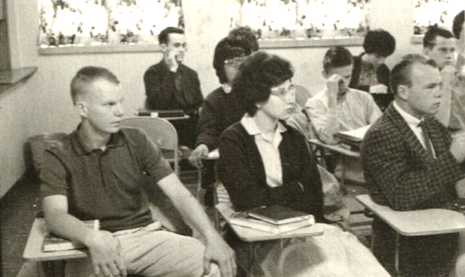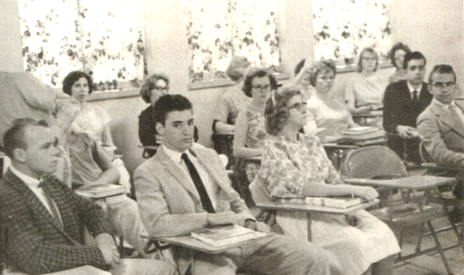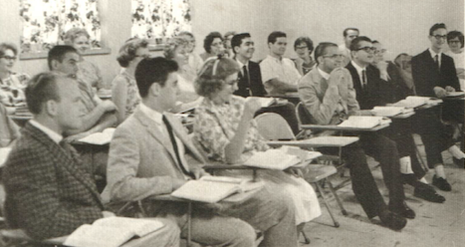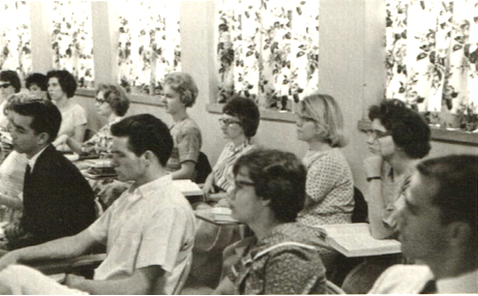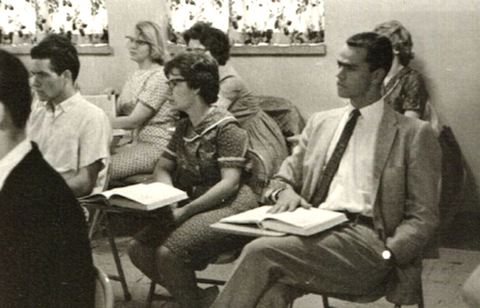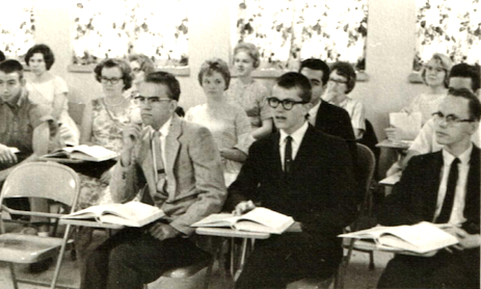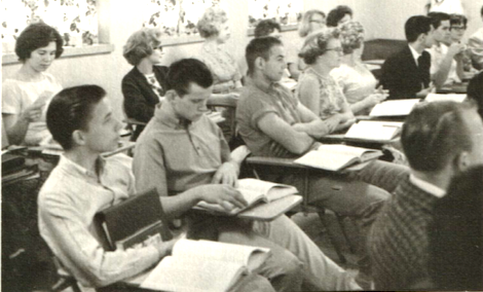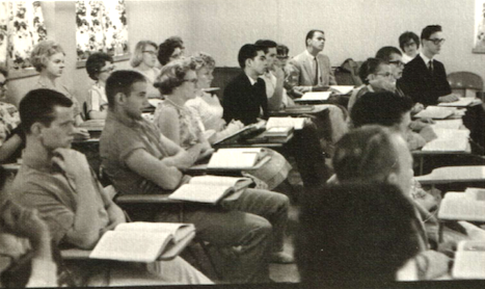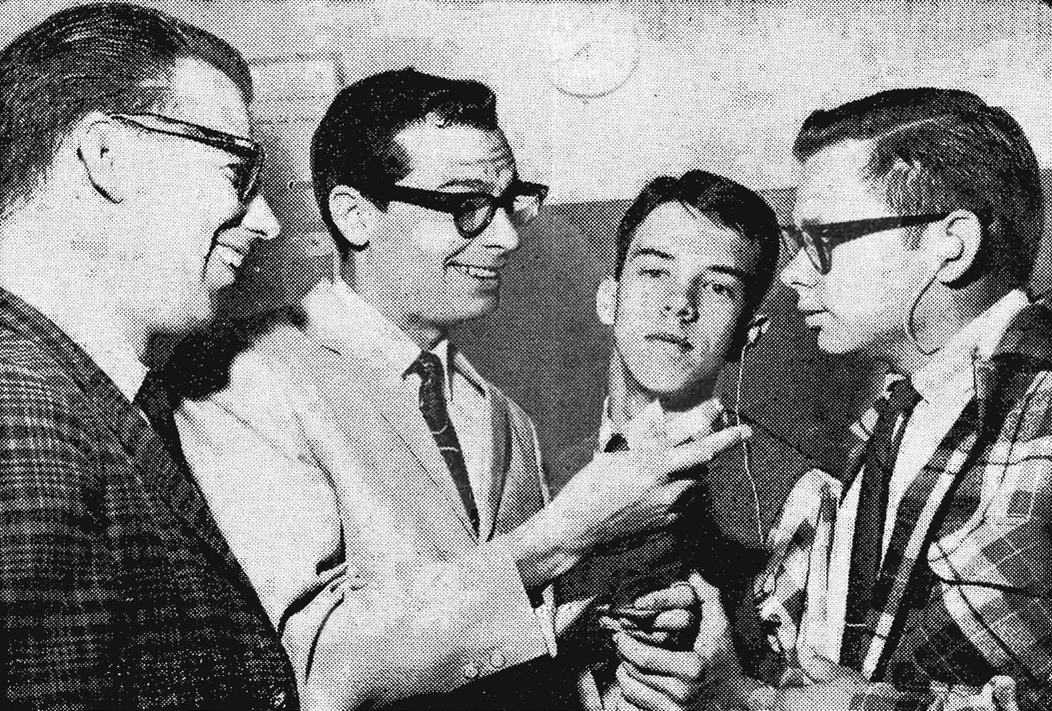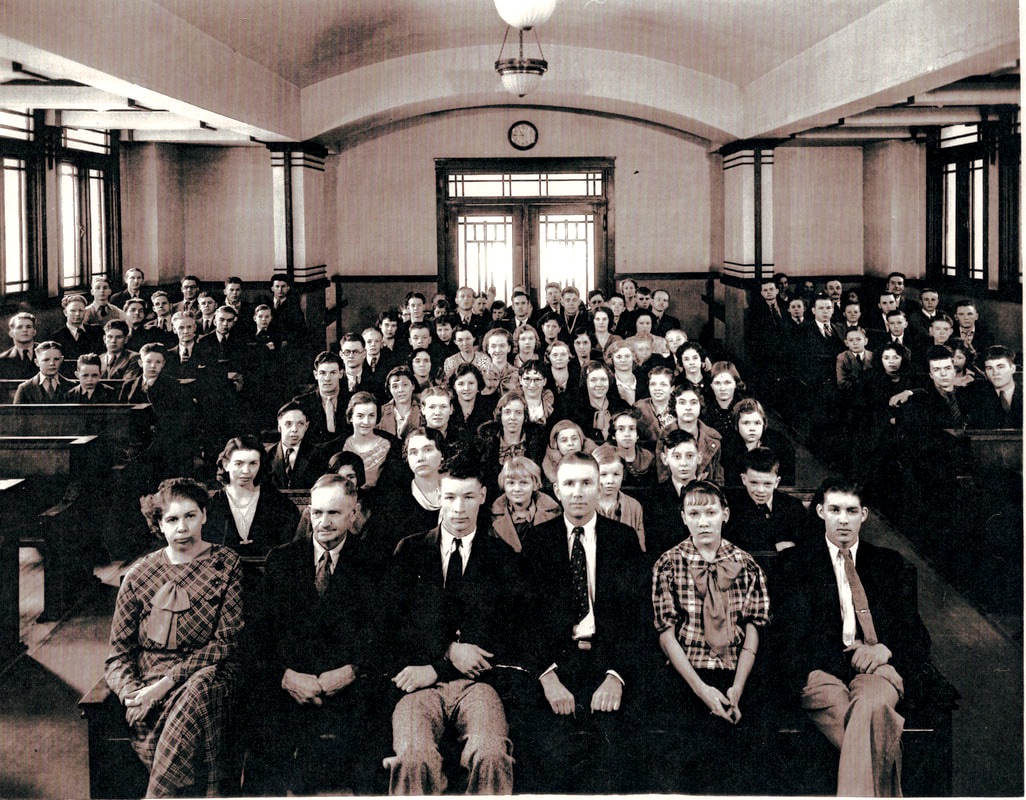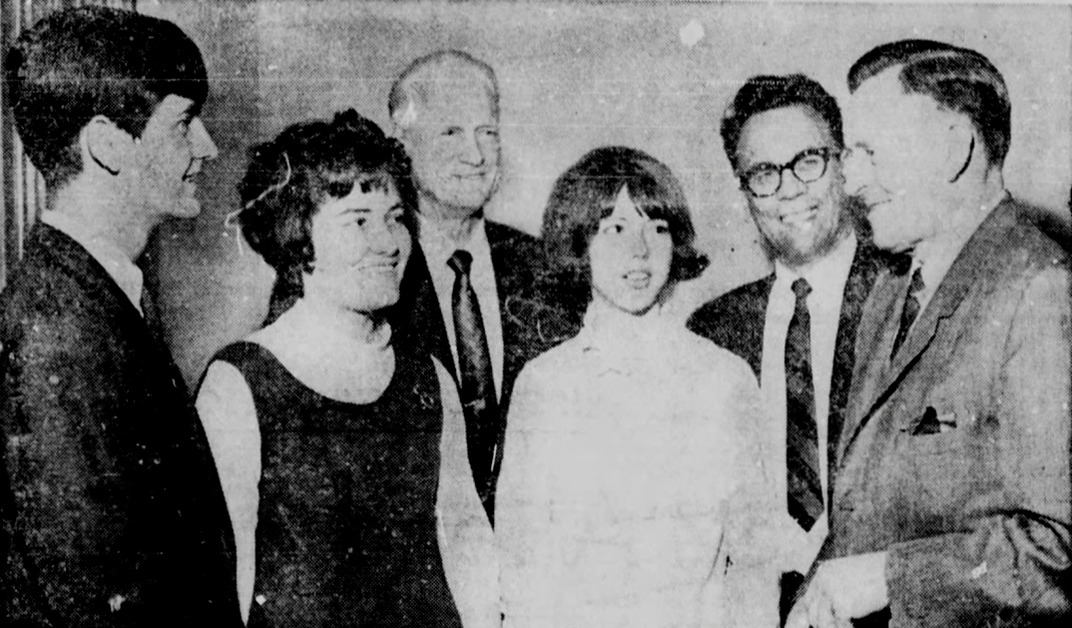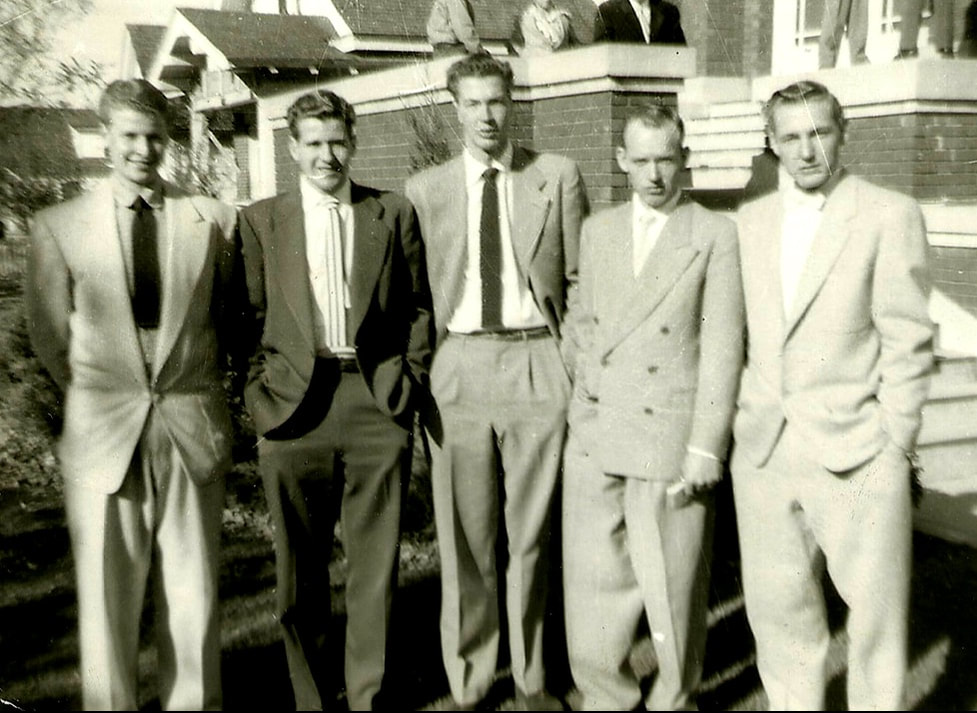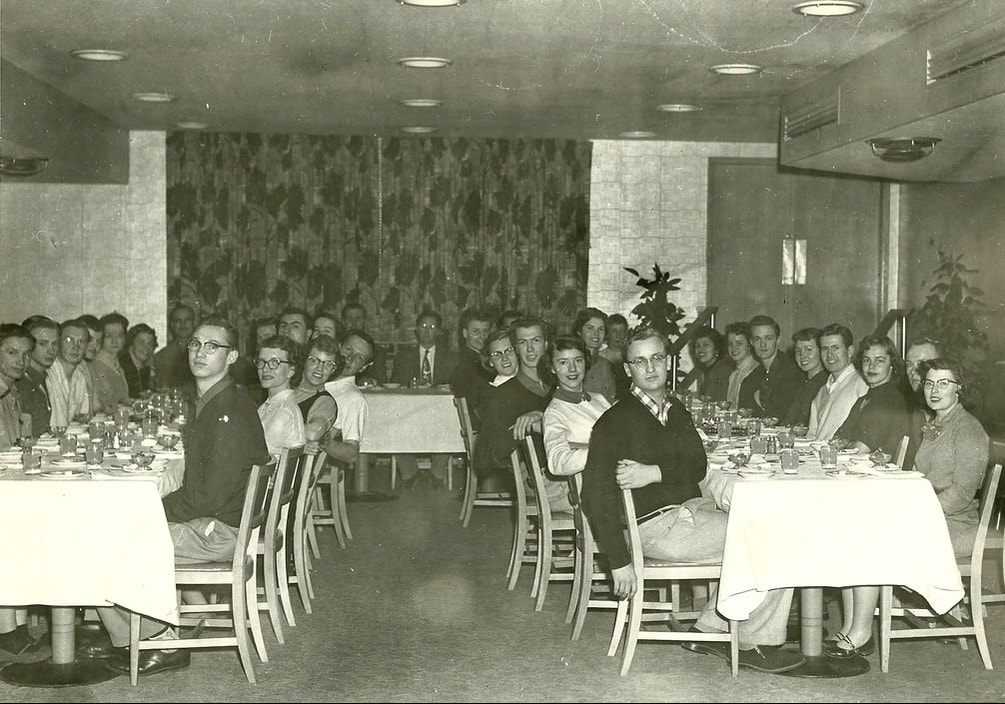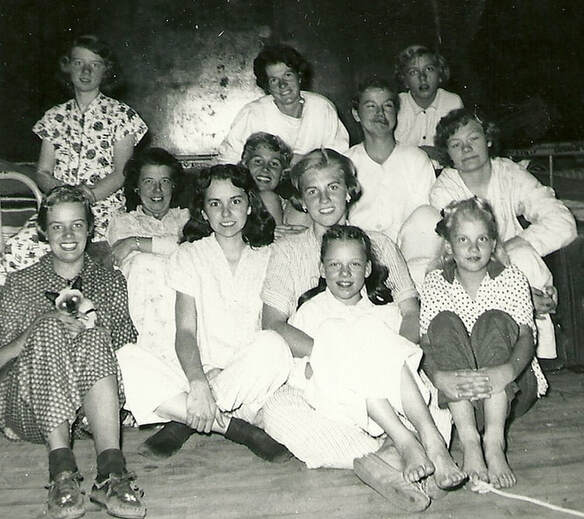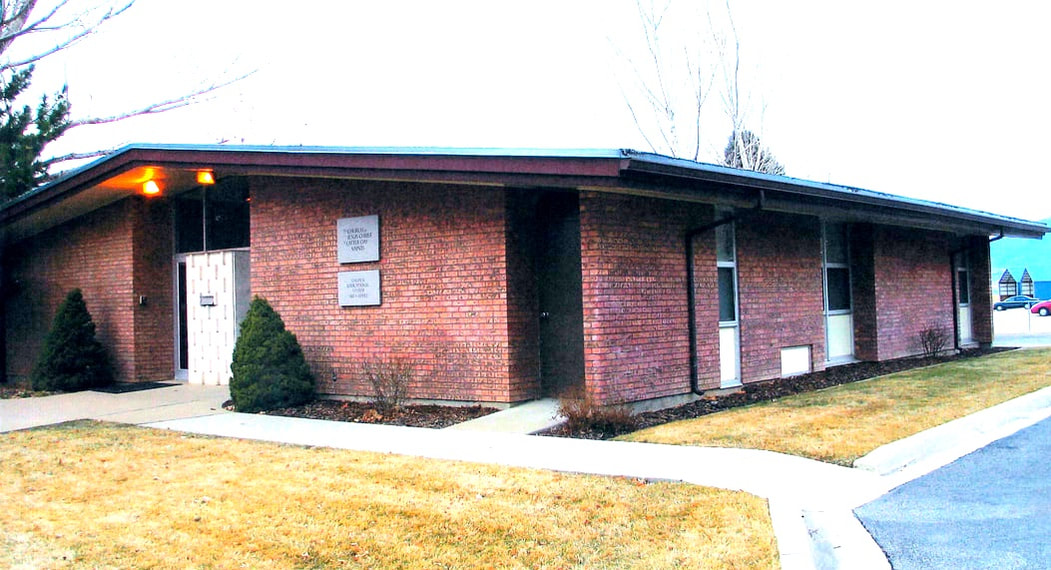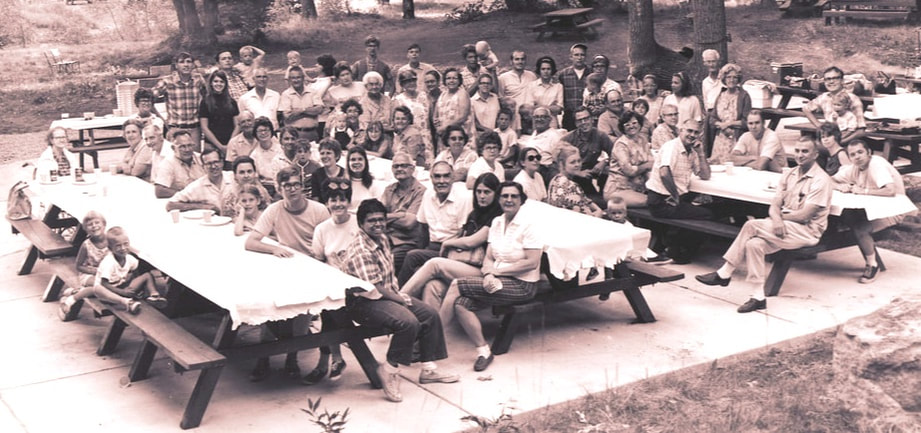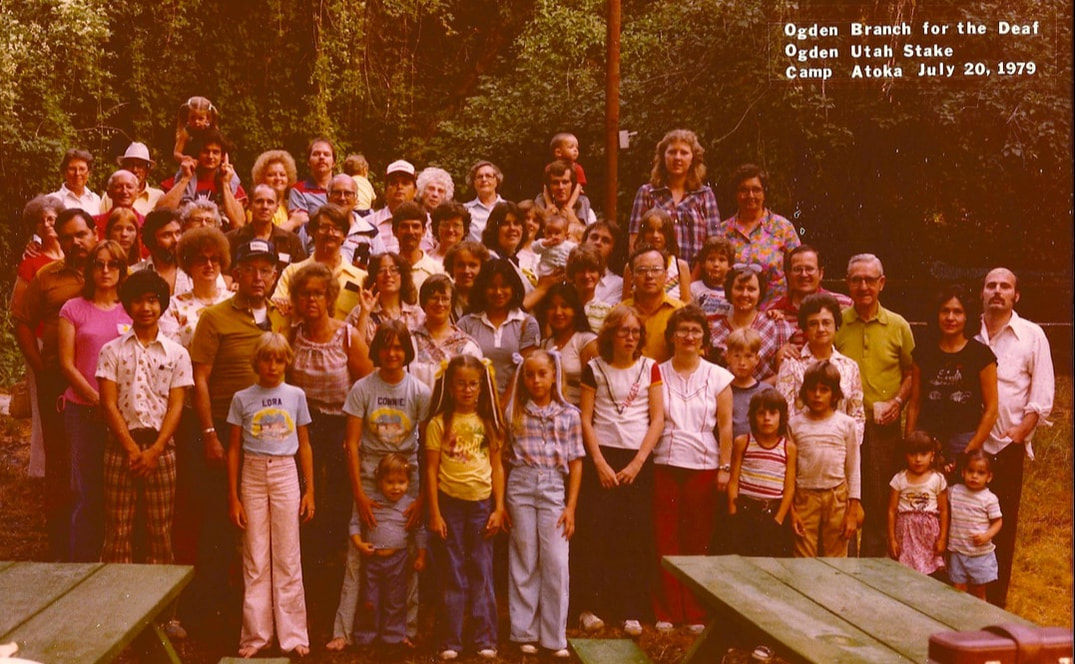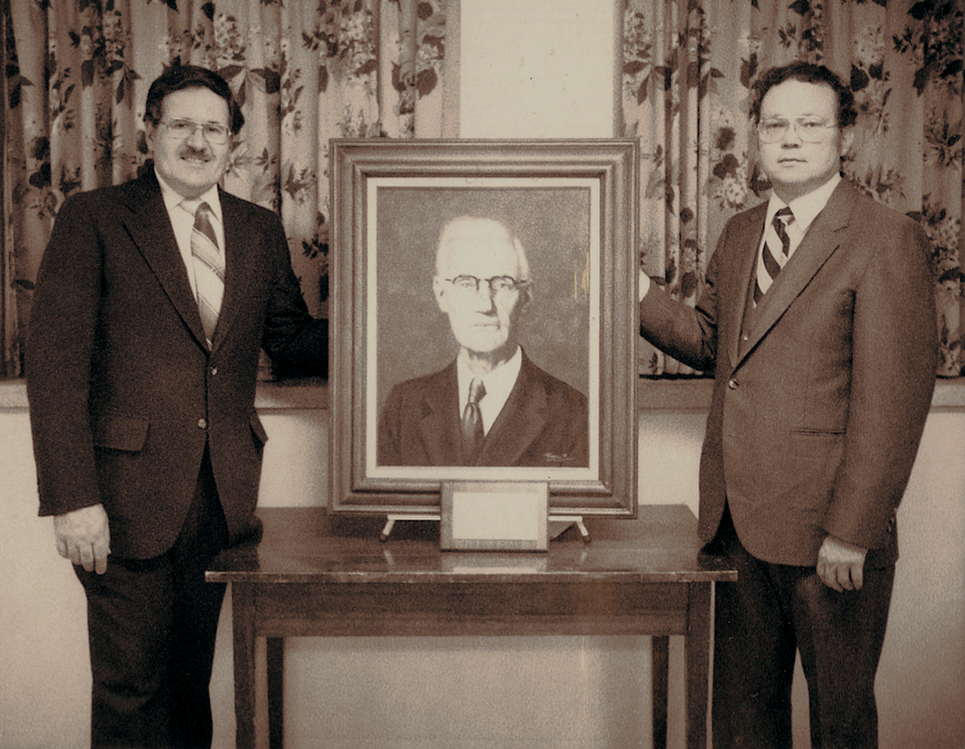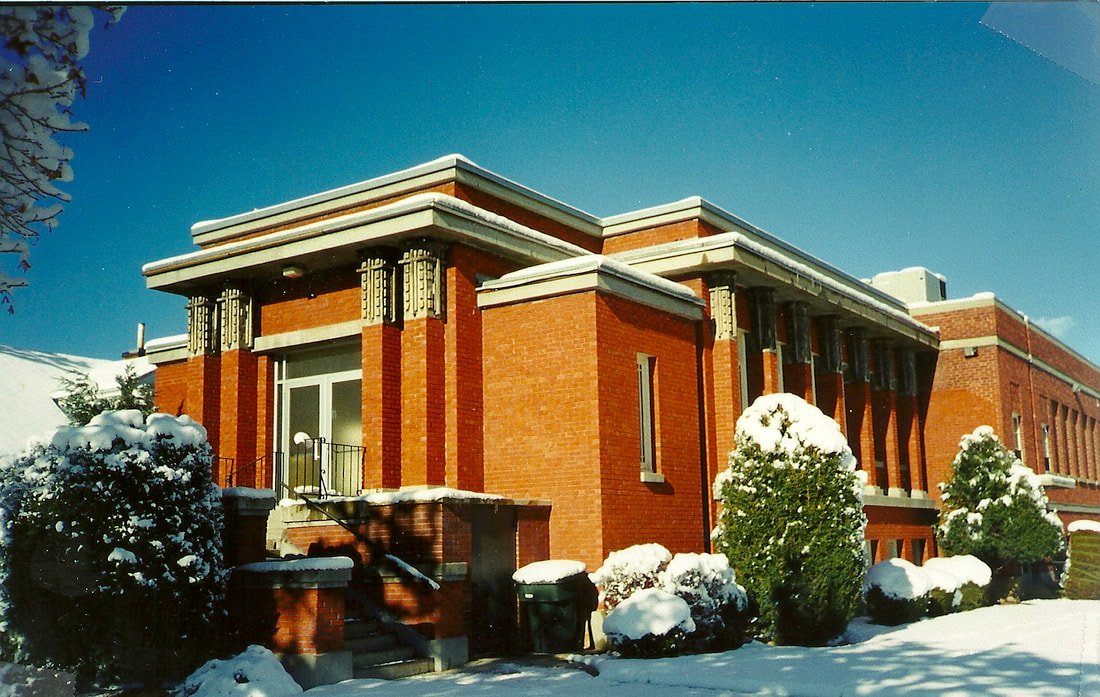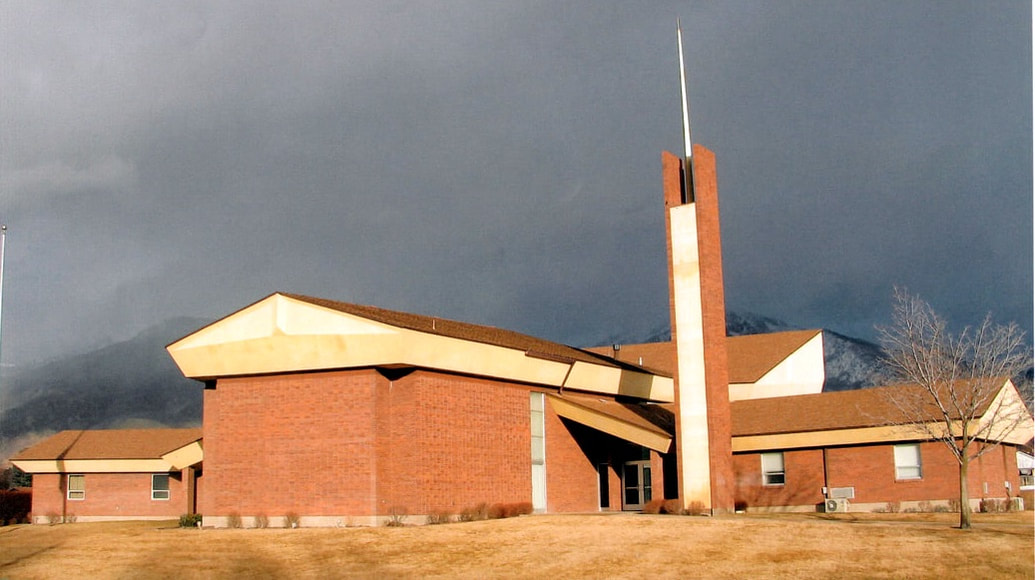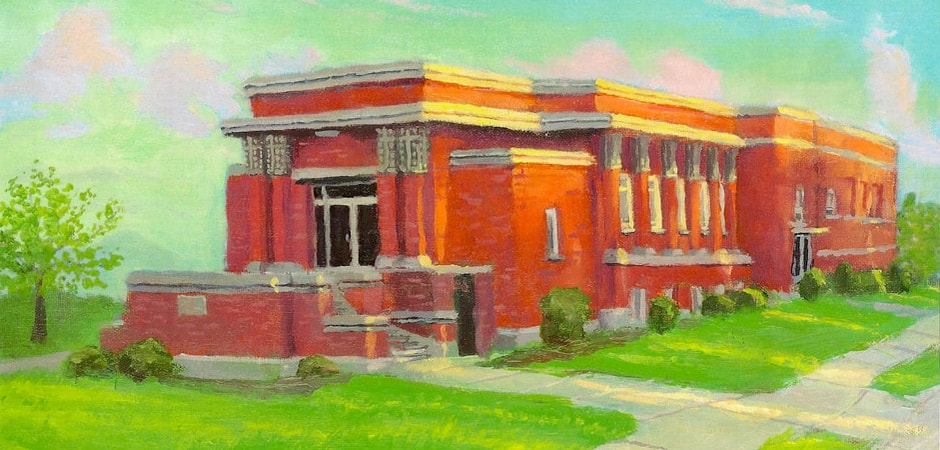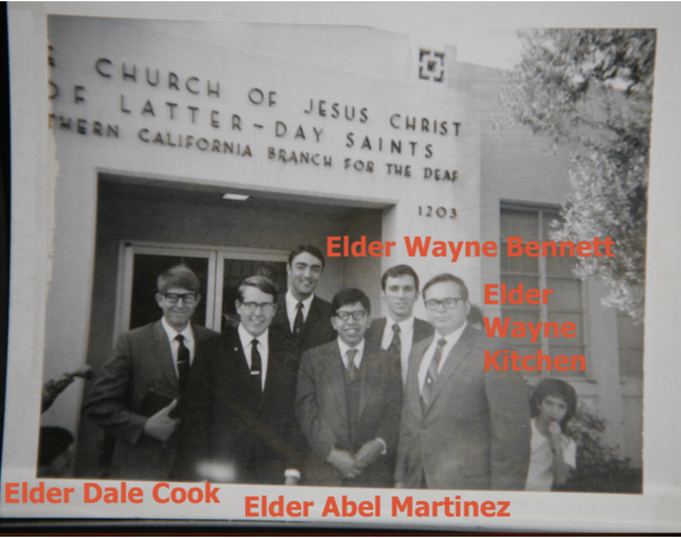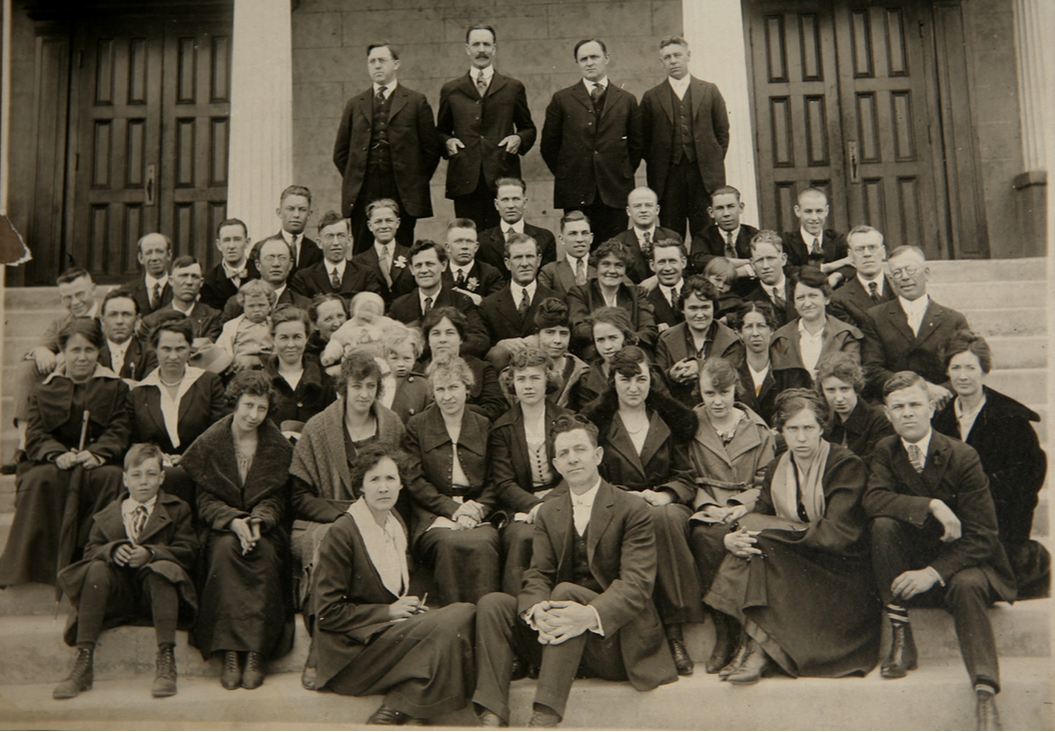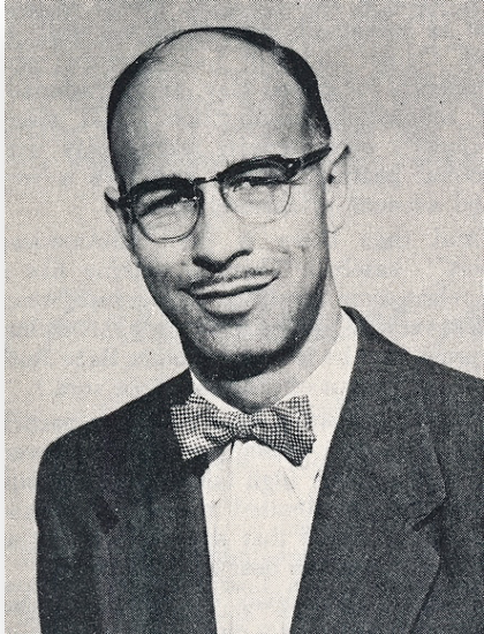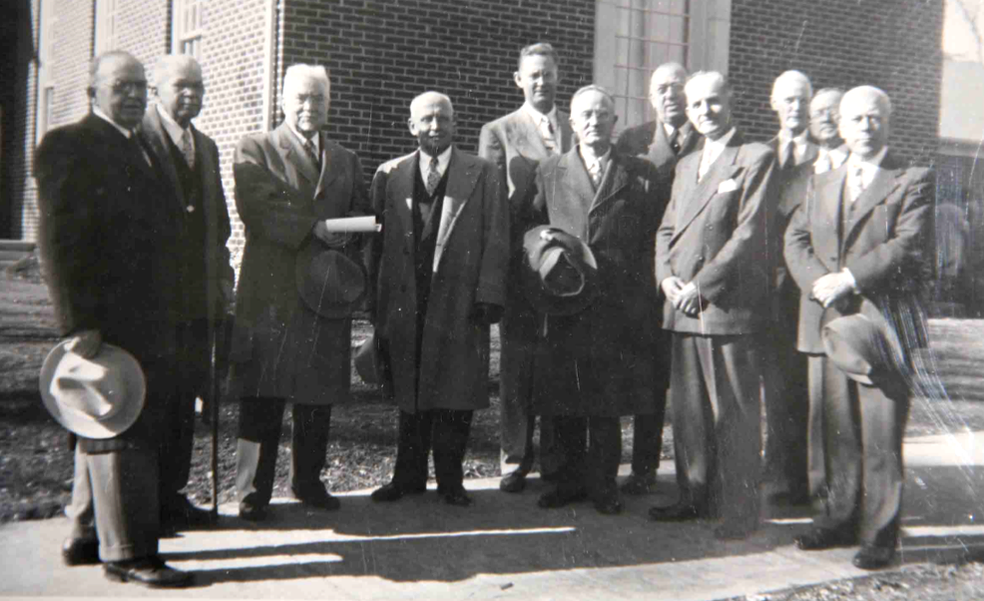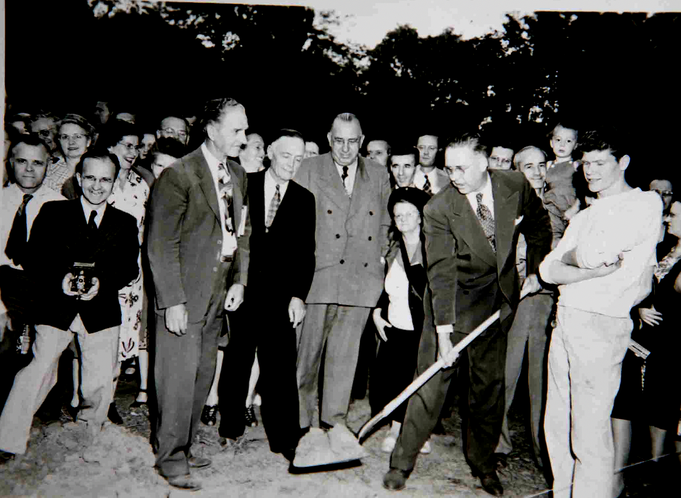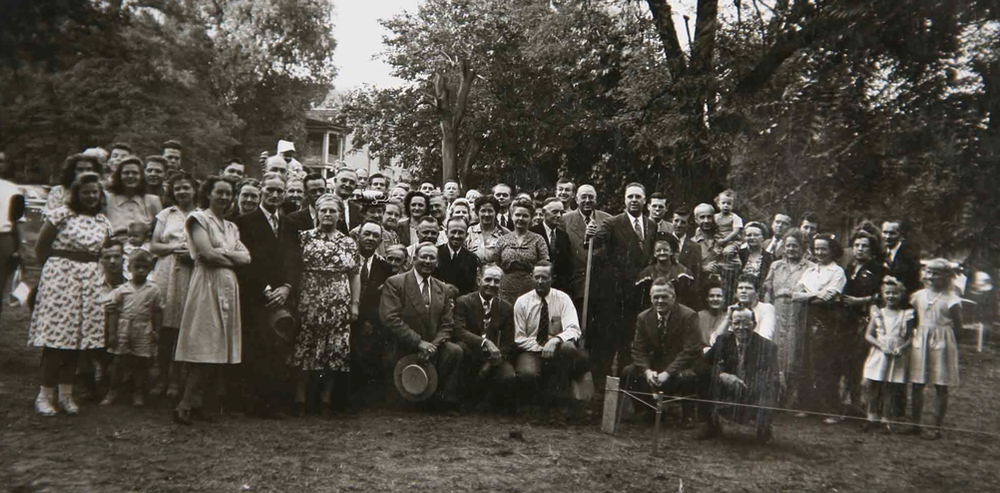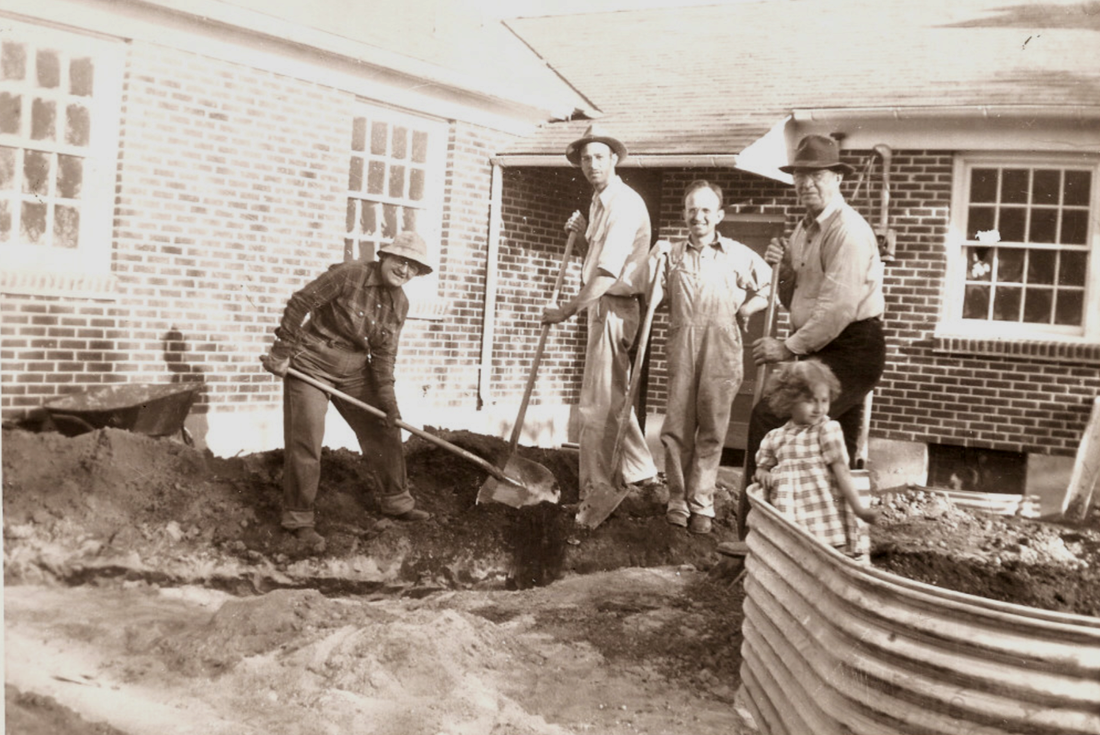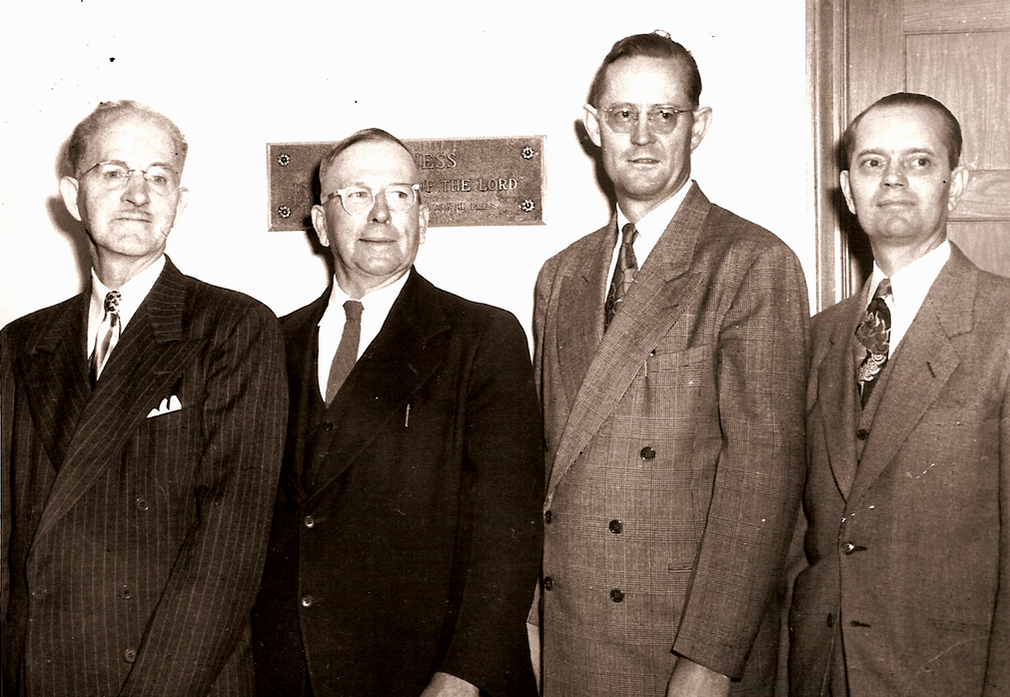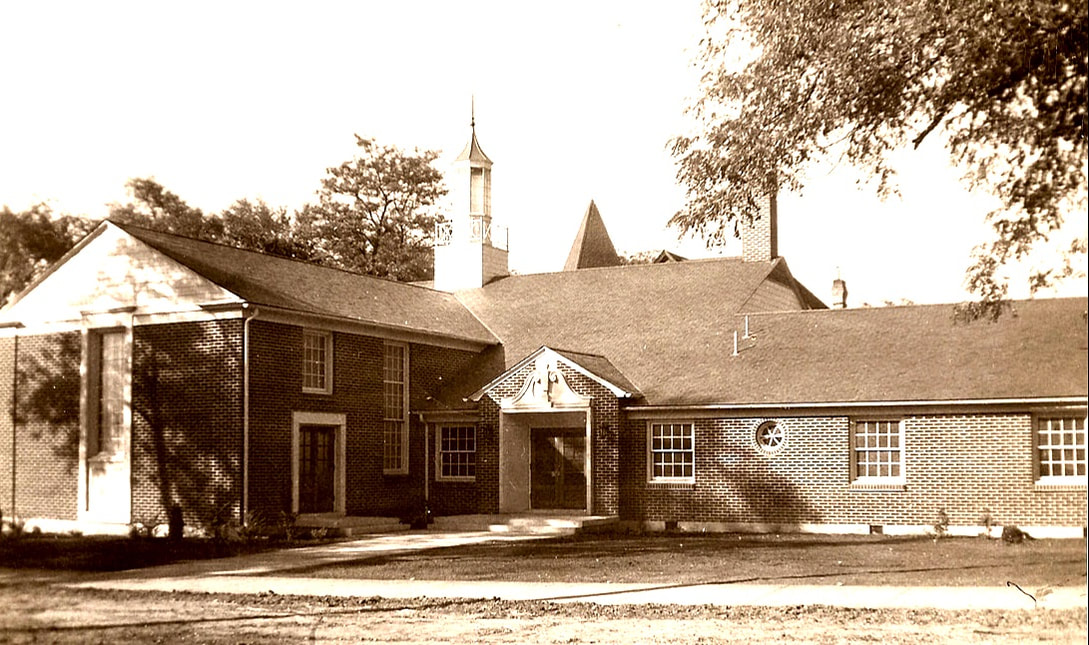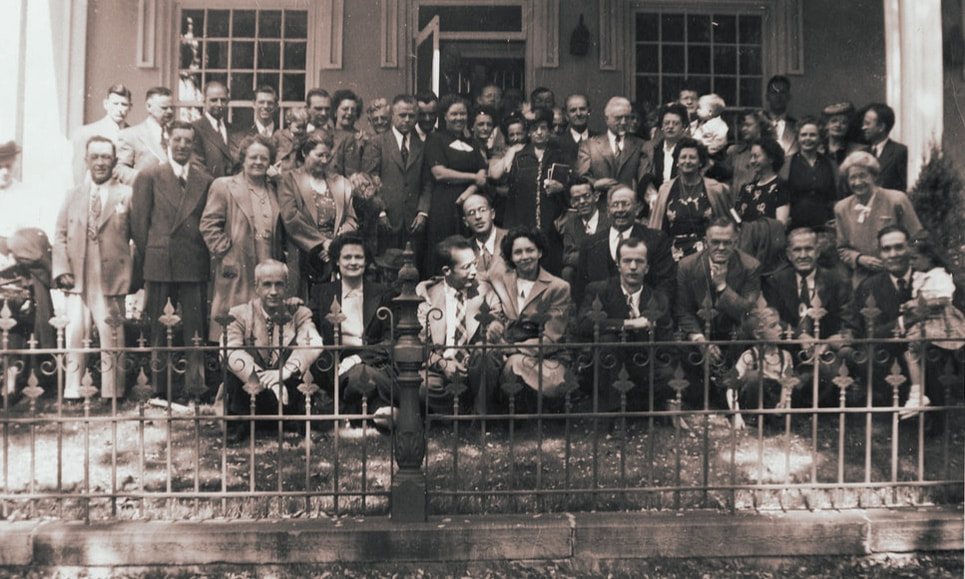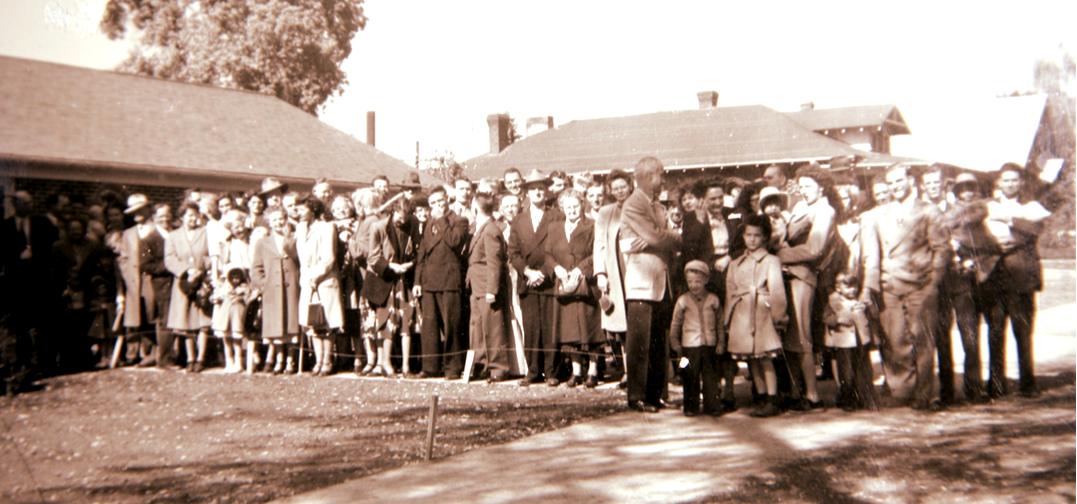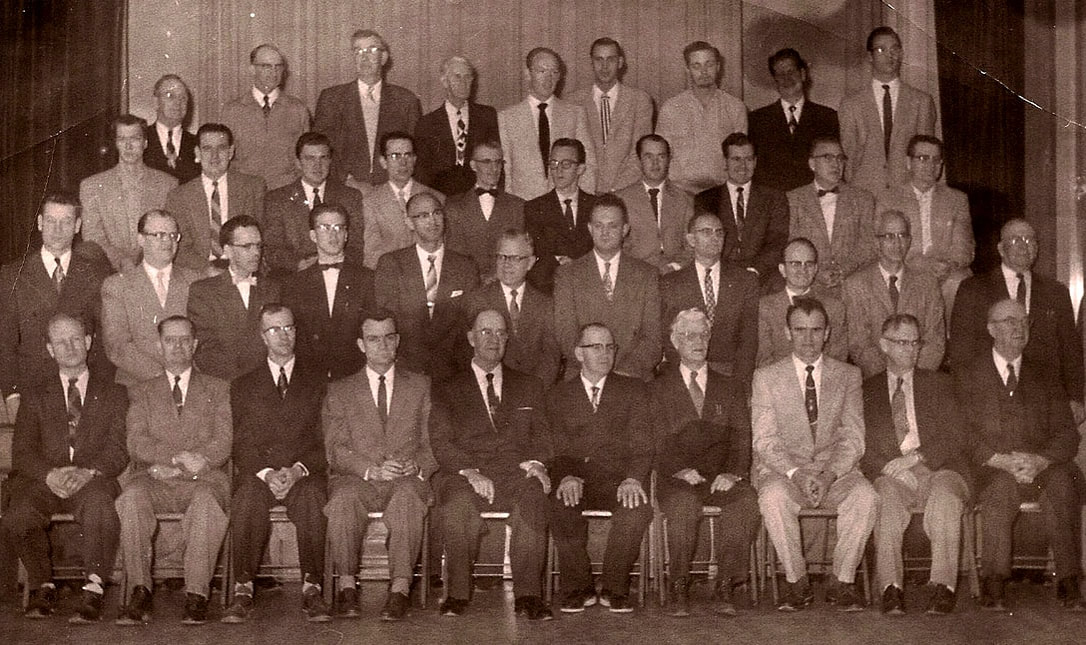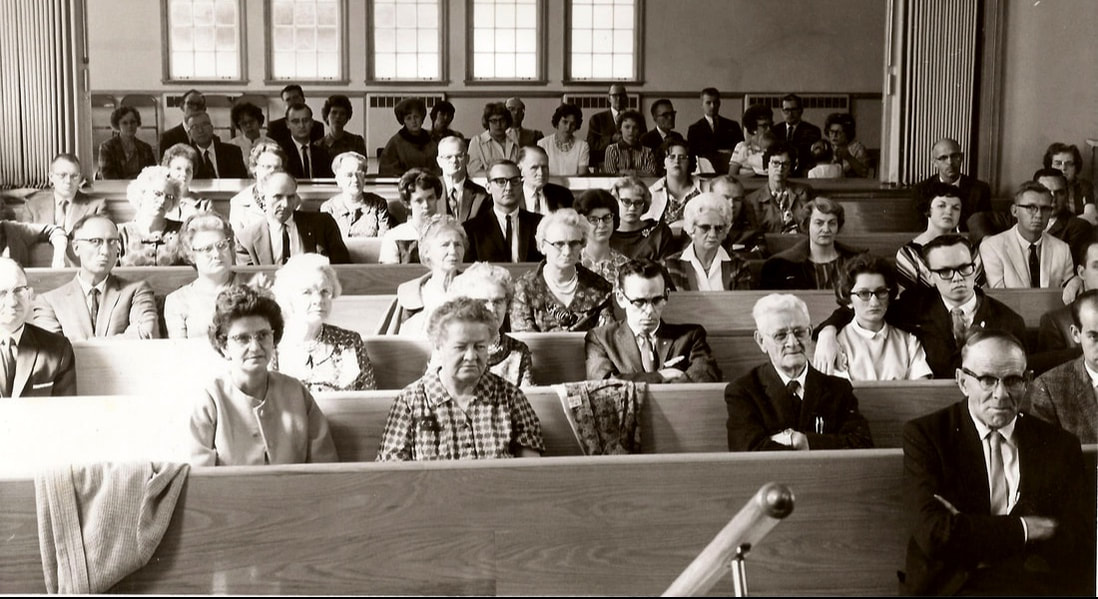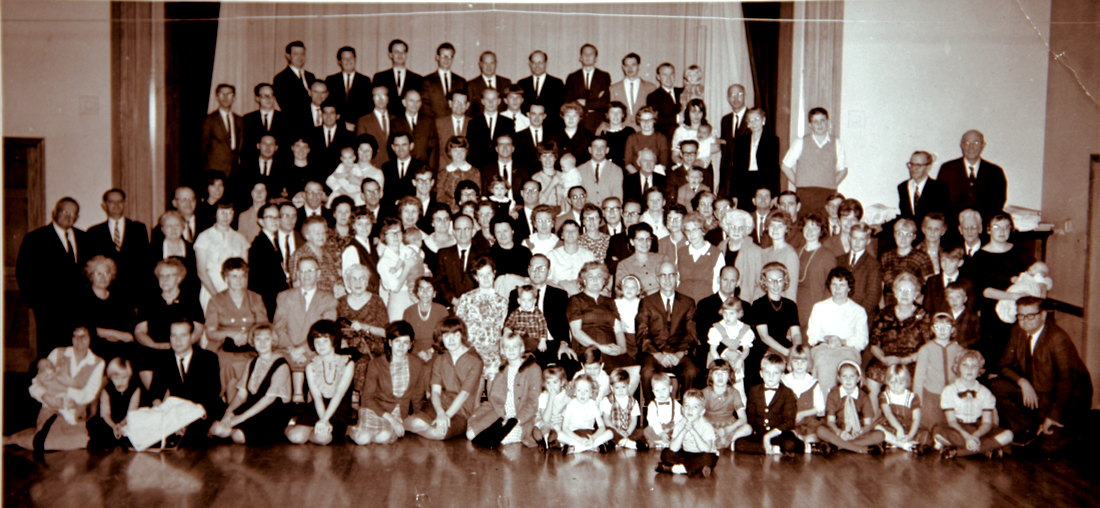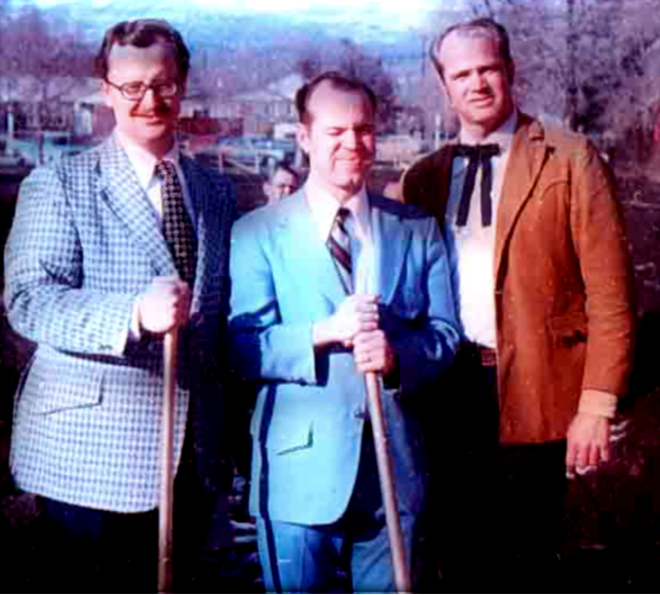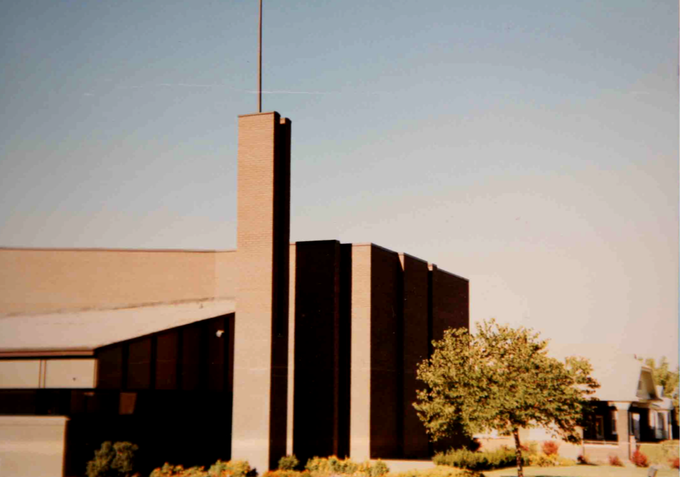History of the Deaf Latter-day
Saints community of
The Church of Jesus Christ
of Latter-day Saints
Saints community of
The Church of Jesus Christ
of Latter-day Saints
Delving into the history of the Deaf Latter-day Saints community reveals a history of unique aspects within The Church of Jesus Christ of Latter-day Saints. These include:
The narratives not only highlight the important role and contributions of the Deaf Latter-day Saints community within The Church of Jesus Christ of Latter-day Saints but also paint a vivid picture of their unique history, making them an integral part of the church's rich history.
- "The Parallel Difficulties in the Ogden Branch for the Deaf and Utah School for the Deaf: 1962–1980,"
- "The relocation of Ogden Branch for the Deaf, 1917–1999,"
- "A Pioneer Day Parade in Utah on July 24, 1961,"
- "The First Four Deaf Missionaries," and
- "A Unique Deaf-Friendly Salt Lake Valley Ward for the Deaf"
- "The History of Relief Society for the Deaf"
The narratives not only highlight the important role and contributions of the Deaf Latter-day Saints community within The Church of Jesus Christ of Latter-day Saints but also paint a vivid picture of their unique history, making them an integral part of the church's rich history.
Author's Note
The narrative 'The Parallel Difficulties in the Deaf Latter-day Saints Community and the Utah School for the Deaf: 1962–1980' is not a critique, but a compelling and educational account. Its aim is to spotlight the unwavering efforts of Deaf Latter-day Saint members at the Ogden Branch for the Deaf to preserve their sign language and sense of community. Moreover, this website serves as a platform to raise public awareness about this history and its profound impact on Deaf members of The Church of Jesus Christ of Latter-day Saints.
When writing about individuals for our history website, I choose to use their first name to acknowledge all individuals who contribute to and advocate for our community's causes. Our patriarchal culture often expects to recognize women's advocacy, contributions, and achievements using their husbands' last names instead of their own. However, in the spirit of inclusivity, equality, and recognizing each individual's unique identity, I have decided to use their first names throughout the website. This decision reaffirms our commitment to these values and highlights the significant role of women's advocacy in our community.
Our organization, previously known as the Utah Association for the Deaf, changed its name to the Utah Association of the Deaf in 2012. The association was known as the Utah Association of the Deaf from 1909 to 1962. The association changed its name to the Utah Association for the Deaf in 1963. Finally, in 2012, the association reverted to its previous name, the Utah Association of the Deaf. When writing the history website, I use both "of" and "for" to reflect the different eras of the association's history.
Last but not least, the opinions expressed may not necessarily reflect the views of the entire Deaf community of The Church of Jesus Christ of Latter-day Saints. The intention is not to disparage all members of the Church of Jesus Christ of Latter-day Saints or specific political parties but to present a clear picture of historical events from the perspective of many Deaf members.
Thank you for your interest in reading the "History of the Deaf Latter-day Saints community of The Church of Jesus Christ of Latter-day Saints" webpage.
Enjoy!
Jodi Becker Kinner
When writing about individuals for our history website, I choose to use their first name to acknowledge all individuals who contribute to and advocate for our community's causes. Our patriarchal culture often expects to recognize women's advocacy, contributions, and achievements using their husbands' last names instead of their own. However, in the spirit of inclusivity, equality, and recognizing each individual's unique identity, I have decided to use their first names throughout the website. This decision reaffirms our commitment to these values and highlights the significant role of women's advocacy in our community.
Our organization, previously known as the Utah Association for the Deaf, changed its name to the Utah Association of the Deaf in 2012. The association was known as the Utah Association of the Deaf from 1909 to 1962. The association changed its name to the Utah Association for the Deaf in 1963. Finally, in 2012, the association reverted to its previous name, the Utah Association of the Deaf. When writing the history website, I use both "of" and "for" to reflect the different eras of the association's history.
Last but not least, the opinions expressed may not necessarily reflect the views of the entire Deaf community of The Church of Jesus Christ of Latter-day Saints. The intention is not to disparage all members of the Church of Jesus Christ of Latter-day Saints or specific political parties but to present a clear picture of historical events from the perspective of many Deaf members.
Thank you for your interest in reading the "History of the Deaf Latter-day Saints community of The Church of Jesus Christ of Latter-day Saints" webpage.
Enjoy!
Jodi Becker Kinner
Acknowledgement
I'd like to express my appreciation to Kenneth Lee Kinner and Charles Roy Cochran, two long-time dedicated leaders of the Ogden Branch for the Deaf, for sharing the Ogden Branch for the Deaf's history and challenges.
Doug Stringham deserves praise for his brilliant title, "The Parallel Difficulties in the Ogden Branch for the Deaf and the Utah School for the Deaf: 1962–1980."
I'd like to thank Dan Mathis for thoroughly proofreading the document and sticking to my paper's mission.
Gratitude is extended to Richard Snow, Charles Roy Cochran, G. Leon Curtis, Cherie Carpenter Hodson, and Kenneth L. Kinner for their invaluable contributions, which have greatly enhanced the accuracy and depth of this document, reflecting the collaborative spirit of our community.
Finally, I'd like to thank Mark Erwin, the Ogden Branch's Branch President at the time and the second-longest serving president of thirteen years, for allowing Duane and me to scan the Branch's records for historical preservation before submitting them to the Church History Library.
I sincerely thank my husband, Duane Kinner, and my children, Joshua and Danielle, for their constant support and patience while we worked on this project.
Jodi Becker Kinner
Doug Stringham deserves praise for his brilliant title, "The Parallel Difficulties in the Ogden Branch for the Deaf and the Utah School for the Deaf: 1962–1980."
I'd like to thank Dan Mathis for thoroughly proofreading the document and sticking to my paper's mission.
Gratitude is extended to Richard Snow, Charles Roy Cochran, G. Leon Curtis, Cherie Carpenter Hodson, and Kenneth L. Kinner for their invaluable contributions, which have greatly enhanced the accuracy and depth of this document, reflecting the collaborative spirit of our community.
Finally, I'd like to thank Mark Erwin, the Ogden Branch's Branch President at the time and the second-longest serving president of thirteen years, for allowing Duane and me to scan the Branch's records for historical preservation before submitting them to the Church History Library.
I sincerely thank my husband, Duane Kinner, and my children, Joshua and Danielle, for their constant support and patience while we worked on this project.
Jodi Becker Kinner
The Parallel Difficulties in the
Ogden Branch for the Deaf and
Utah School for the Deaf: 1962-1980
Ogden Branch for the Deaf and
Utah School for the Deaf: 1962-1980
Compiled & Written by Jodi Becker Kinner
Edited by Dan V. Mathis
Published in 2012
Updated in 2024
Edited by Dan V. Mathis
Published in 2012
Updated in 2024
Prologue
As the author of this website, I aim to highlight the importance of learning from the past, particularly the challenges faced by the Deaf Latter-day Saints community. Dr. Grant B. Bitter, a staunch advocate for oral and mainstream education, has had an impact on the Ogden Branch. Kenneth L. Kinner and Charles Roy Cochran, long-time dedicated leaders of The Church of Jesus Christ of Latter-day Saints' Ogden Branch for the Deaf, have recounted essential historical events and personal experiences through oral history. They had displayed extraordinary resilience and perseverance in leading the Ogden Branch for the Deaf while dealing with the consequences of Dr. Bitter's oral effects on the branch. Regardless of our chosen path, we can learn from their challenges, appreciate their steadfastness in guarding the branch, and recognize the responsibility of passing down the invaluable gift of communication in American Sign Language to future generations.
Jodi Becker Kinner
Jodi Becker Kinner
The Church of Jesus Christ of Latter-day Saints Builds the Ogden Branch for the Deaf
for Students of the Utah School for the Deaf
for Students of the Utah School for the Deaf
Before delving into the challenges faced by the Ogden Branch for the Deaf with Dr. Grant B. Bitter, a prominent oral and mainstream advocate who was a member of The Church of Jesus Christ of Latter-day Saints and had a profound impact as a coordinator for the Deaf Seminary, let us first explore the origins of the Sunday School for the Deaf and the Ogden Branch's history. We will then delve into parallel challenges at the Ogden Branch for the Deaf and the Utah School for the Deaf, highlighting the effect of Dr. Bitter's efforts in promoting 'oralism, a method of education that emphasizes the use of listening and spoken language, in Deaf children.
The Ogden Branch for the Deaf of The Church of Jesus Christ of Latter-day Saints was established in 1917 under the leadership of Max W. Woodbury, who served as the branch president for 51 years, and his assistant, Elsie M. Christiansen, who served as the branch clerk for 28 years. Following his graduation from the University of Utah, Max, who was hard of hearing, found teaching position at the Utah School for the Deaf (USD) in 1902 before founding the Ogden Branch for the Deaf. On January 10, 1892, The Church of Jesus Christ of Latter-day Saints established the Sunday School for the Deaf, the first organized religious education for the deaf. It was a collaborative effort between the Utah School for the Deaf and the Church of Jesus Christ of Latter-day Saints, with membership primarily consisting of Deaf Latter-day Saints students from the Utah School for the Deaf. Leading this initiative were the first superintendent, Charles H. Barrell, and his Deaf assistant, Laron Pratt, the early leader of the Deaf Latter-day Saints community, whose dedication and vision laid the foundation for the Sunday School (The Daily Enquirer, February 11, 1892; Woodbury, History of the Branch; History of the Ogden Branch).
The Ogden Branch for the Deaf of The Church of Jesus Christ of Latter-day Saints was established in 1917 under the leadership of Max W. Woodbury, who served as the branch president for 51 years, and his assistant, Elsie M. Christiansen, who served as the branch clerk for 28 years. Following his graduation from the University of Utah, Max, who was hard of hearing, found teaching position at the Utah School for the Deaf (USD) in 1902 before founding the Ogden Branch for the Deaf. On January 10, 1892, The Church of Jesus Christ of Latter-day Saints established the Sunday School for the Deaf, the first organized religious education for the deaf. It was a collaborative effort between the Utah School for the Deaf and the Church of Jesus Christ of Latter-day Saints, with membership primarily consisting of Deaf Latter-day Saints students from the Utah School for the Deaf. Leading this initiative were the first superintendent, Charles H. Barrell, and his Deaf assistant, Laron Pratt, the early leader of the Deaf Latter-day Saints community, whose dedication and vision laid the foundation for the Sunday School (The Daily Enquirer, February 11, 1892; Woodbury, History of the Branch; History of the Ogden Branch).
The Sunday School for the Deaf, a testament to the church's unwavering commitment to the religious education of the Deaf Latter-day Saints community, continued its operations after the Utah School for the Deaf relocated to Ogden, Utah, in 1896. The class was held in the old Fourth Ward Amusement Hall on Madison Avenue, between 22nd and 23rd Street, within the 4th Ward boundaries. Fred Chambers was appointed Sunday School superintendent. Early in 1902, the Utah School for the Deaf asked Max, a teacher and supervisor of the boys in the dormitory, to assist with the Sunday School, leading to his eventual teaching calling (Woodbury, History of the Branch; History of the Ogden Branch).
During his tenure at the school, Max served as a Sunday School teacher for the Ogden 4th Ward, where he faced challenges while teaching Sunday School due to noise from other classrooms in a building with only one large room divided into rooms by black cotton curtains, which was challenging at the time. During a lesson, Max could hear teachers teaching non-Deaf children. "It was impossible to teach because of other teachers' classroom noises, children talking, people laughing, babies crying, and so on," he stated. They placed a massive heating furnace in the center of the large room because it was so cold in the winter (Ward Stake Historical Record Book #4, 1941–45; Woodbury, History of the Branch; History of the Ogden Branch for the Deaf, 1979; Historical Events and Persons Involved Branch for the Deaf, 1992). Despite the difficulties, Max continued to serve as a Sunday school teacher. He learned sign language through his interactions with Deaf students from the Utah School for the Deaf and members of the Sunday School class.
During his tenure at the school, Max served as a Sunday School teacher for the Ogden 4th Ward, where he faced challenges while teaching Sunday School due to noise from other classrooms in a building with only one large room divided into rooms by black cotton curtains, which was challenging at the time. During a lesson, Max could hear teachers teaching non-Deaf children. "It was impossible to teach because of other teachers' classroom noises, children talking, people laughing, babies crying, and so on," he stated. They placed a massive heating furnace in the center of the large room because it was so cold in the winter (Ward Stake Historical Record Book #4, 1941–45; Woodbury, History of the Branch; History of the Ogden Branch for the Deaf, 1979; Historical Events and Persons Involved Branch for the Deaf, 1992). Despite the difficulties, Max continued to serve as a Sunday school teacher. He learned sign language through his interactions with Deaf students from the Utah School for the Deaf and members of the Sunday School class.
Max and his assistant, Elsie, soon received several church calls before establishing the Ogden Branch for the Deaf, which motivated them to build their own chapel. Max assumed the role of assistant superintendent in 1907, while Elsie M. Christiansen, a 1907 graduate of the Utah School for the Deaf, assumed the role of secretary. Three years later in 1911, Max was promoted to superintendent, while Elsie was promoted to assistant superintendent (Woodbury, History of the Branch). By 1912, they had around eighty members. Max found it challenging to accommodate the increasing number of Deaf members visiting the Sunday School from the Utah School for the Deaf, as there were only five lessons in one room. Max believed that the Deaf members should have their own place of worship (Woodbury, History of the Branch).
The Ogden Deaf Sunday School group grew, leading Max and Elsie to write a letter to Joseph F. Smith, president of The Church of Jesus Christ of Latter-day Saints, in October 1912. In their letter, they highlighted the need for Deaf members to meet in a more appropriate setting that would foster their growth and learning. Their letter was more than just a plea; it was a well-advocated case for the construction of a deaf-exclusive worship space to provide Sunday School and sacrament services, as well as Mutual Improvement Associations (M.I.A.) for both Young Men's Mutual Improvement Association (Y.M.) and Young Women's Mutual Improvement Association (Y.W.) services, which would enable Deaf members to engage in church services in a manner that best meets their communication and fellowship needs. Their efforts bore fruit, as many Deaf members submitted a second letter to the church headquarters, expressing a strong desire for their own meetinghouse for worship services and social events (Ward Stake Historical Record Book #4, 1941–1945; Woodbury, History of the Branch; Historical Events and Persons Involved Branch for the Deaf, 1992).
According to Charles Roy Cochran, who documented that Max W. Woodbury and Elsie M. Christiansen submitted a letter to Joseph F. Smith, president of The Church of Jesus Christ of Latter-day Saints, President Smith read and returned the letter, explaining the proper channel through the bishop and stake president before the First Presidency. Max then rewrote the letter to the bishop and stake president (Charles Roy Cochran, History of the Ogden Branch for the Deaf, 1999). A week later, Stake President Thomas B. Evans had a conversation with Max and invited Max and Elsie to Salt Lake City, Utah, to discuss the accessibility situation in Ogden with President Smith. During the conversation, President Smith inquired about Max Woodbury's father, John Stillman Woodbury. Max confirmed this, and President Smith informed him that, as a young man, he had received a call to serve as a missionary in the Sandwich Islands, now referred to as the Hawaiian Islands. President Smith also mentioned encountering a remarkably kind man who guided him, taught him the island's language, and helped him settle into the mission. Following this, Max and Elsie scheduled another meeting with the Church's First Presidency to discuss the matter. President Smith granted permission to build the Ogden Branch for the Deaf (Ward Stake Historical Record Book #4, 1941–1945; Woodbury, History of Branch for the Deaf; Historical Events and Persons Involved Branch for the Deaf, 1992). President Smith's approval of the Ogden Branch for the Deaf was a testament to Max and Elsie's tireless efforts. This development marked a significant milestone, providing a deaf-friendly meetinghouse for the Deaf members in Ogden, Utah. More than just a building, it symbolized the recognition and respect for the Deaf Latter-day Saints community within the church, a direct result of Max and Elsie's advocacy.
According to Charles Roy Cochran, who documented that Max W. Woodbury and Elsie M. Christiansen submitted a letter to Joseph F. Smith, president of The Church of Jesus Christ of Latter-day Saints, President Smith read and returned the letter, explaining the proper channel through the bishop and stake president before the First Presidency. Max then rewrote the letter to the bishop and stake president (Charles Roy Cochran, History of the Ogden Branch for the Deaf, 1999). A week later, Stake President Thomas B. Evans had a conversation with Max and invited Max and Elsie to Salt Lake City, Utah, to discuss the accessibility situation in Ogden with President Smith. During the conversation, President Smith inquired about Max Woodbury's father, John Stillman Woodbury. Max confirmed this, and President Smith informed him that, as a young man, he had received a call to serve as a missionary in the Sandwich Islands, now referred to as the Hawaiian Islands. President Smith also mentioned encountering a remarkably kind man who guided him, taught him the island's language, and helped him settle into the mission. Following this, Max and Elsie scheduled another meeting with the Church's First Presidency to discuss the matter. President Smith granted permission to build the Ogden Branch for the Deaf (Ward Stake Historical Record Book #4, 1941–1945; Woodbury, History of Branch for the Deaf; Historical Events and Persons Involved Branch for the Deaf, 1992). President Smith's approval of the Ogden Branch for the Deaf was a testament to Max and Elsie's tireless efforts. This development marked a significant milestone, providing a deaf-friendly meetinghouse for the Deaf members in Ogden, Utah. More than just a building, it symbolized the recognition and respect for the Deaf Latter-day Saints community within the church, a direct result of Max and Elsie's advocacy.
The construction of the Ogden Branch chapel, which cost $15,000, was finished in October 1916. The Sunday School promptly relocated to the new structure, which featured a splendid chapel, eight classrooms, a small library, two restrooms, and a small drinking fountain, plus a furnace stoked by coal and a storage room for janitorial equipment (Woodbury, History of the Branch; Historical Events and Persons Involved Branch for the Deaf, 1992).
Max W. Woodbury, a man of humility and faith, continued to serve as the Sunday School's superintendent until February 4, 1917. During this period, Stake President Evans recognized Max's potential for leadership and inquired about his interest in becoming the branch president. Displaying his characteristic humility and faith, Max suggested several individuals he believed could effectively manage the responsibilities. However, Stake President Evans informed him that the Church Presidency wanted him to be the first branch president, a testament to Max's leadership and the Church's recognition of his capabilities (History of the Odgen Branch).
Max W. Woodbury, a man of humility and faith, continued to serve as the Sunday School's superintendent until February 4, 1917. During this period, Stake President Evans recognized Max's potential for leadership and inquired about his interest in becoming the branch president. Displaying his characteristic humility and faith, Max suggested several individuals he believed could effectively manage the responsibilities. However, Stake President Evans informed him that the Church Presidency wanted him to be the first branch president, a testament to Max's leadership and the Church's recognition of his capabilities (History of the Odgen Branch).
On January 14, 1917, a significant event occurred when President Joseph F. Smith dedicated the Ogden Branch for the Deaf. The Ogden Stake President, Thomas B. Evans, organized a meeting to dedicate the new chapel, the first of its kind in the world. A large crowd gathered, and the faith and devotion of the Deaf members moved President Joseph F. Smith to tears during the dedication. He delivered an uplifting sermon before offering the dedicatory prayer. Other speakers, including Stake President Thomas B. Evans, Dr. Joseph Morrell, Chairman of the Building Committee Leslie S. Hodgson, the building architect Apostle Hyrum Smith, Presiding Bishop David A. Smith, and First Presidency President Anthon H. Lund, shared their perspectives at the event. Superintendent of the Sunday School Max W. Woodbury provided a history of the Sunday School for the Deaf, while Superintendent Frank M. Briggs of the Utah School for the Deaf and the Blind served as an interpreter of the event (Ogden Standard-Examiner, February 5, 1917; Woodbury, History of the Branch; History of the Ogden Branch; Historical Events and Persons Involved Branch for the Deaf, 1992).
On February 4, 1917, the Ogden Stake organized and established the Ogden Branch for the Deaf at the corner of Liberty Avenue and 21st Street. This marked a significant achievement for the Deaf Latter-day Saints community, who were overjoyed at the prospect of having a dedicated place for their social and religious gatherings. Max W. Woodbury became the new Branch President, with David John Thurman as the 1st Counselor, and Elsie M. Christiansen as the Clerk. Otto P. Farley later became the 2nd Counselor (Woodbury, History of the Branch).
This milestone reflected the community's strength and resilience, as they had long been advocating for a place of their own. The chapel was located one and a half blocks from the Utah School for the Deaf campus (Ward Stake Historical Record Book #4, 1941–1945; Woodbury, History of the Branch; Historical Events and Persons Involved Branch for the Deaf, 1992). The presence of the Utah School for the Deaf in Ogden led to a large Deaf population. By 1920, nearly a quarter of the school's students were members of The Church of Jesus Christ of Latter-day Saints. This necessitated the creation of a dedicated place for their social and religious gatherings (White, The Silent Worker, October 1920).
In the 1946 Biennial Report to Utah Governor Herbert B. Maw, the Board of Trustees of the Utah School for the Deaf recognized the value of the Ogden Branch to the students and stated the following:
"The location of the school in Ogden has congregated a number of deaf and blind in that city, which together with the school population, make quite a colony. To provide for the religious training of those among them, who are Latter-day Saints, the authorities of that church have built a beautiful chapel, costing $13,500 [$15,000 is the correct amount], one and one-half blocks from the school. We have this is the first religious organization in the world to construct a place to worship for the exclusive use of the deaf and blind."
The Ogden Branch for the Deaf stood as a testament to the dedication and vision of its pioneers, Max and Elsie. Their significant role in the construction of the first chapel for Deaf members of The Church of Jesus Christ of Latter-day Saints, and their unwavering commitment and collaboration with church authorities, were instrumental in overseeing the construction process.
"The location of the school in Ogden has congregated a number of deaf and blind in that city, which together with the school population, make quite a colony. To provide for the religious training of those among them, who are Latter-day Saints, the authorities of that church have built a beautiful chapel, costing $13,500 [$15,000 is the correct amount], one and one-half blocks from the school. We have this is the first religious organization in the world to construct a place to worship for the exclusive use of the deaf and blind."
The Ogden Branch for the Deaf stood as a testament to the dedication and vision of its pioneers, Max and Elsie. Their significant role in the construction of the first chapel for Deaf members of The Church of Jesus Christ of Latter-day Saints, and their unwavering commitment and collaboration with church authorities, were instrumental in overseeing the construction process.
In a significant turn of events, on February 4, 1917, the Ogden Branch for the Deaf underwent a transformative reorganization. The branch elected new leadership, appointed key officers, and established the Young Men and Young Ladies Mutual Improvement Associations, all of which marked a pivotal moment in the branch's history and set the stage for its future development.
The Ogden Deaf Branch reorganized the Sunday School and appointed the following officers: Elizabeth DeLong as superintendent, Nephi Larson as first assistant, Grant Morgan as second assistant, and Loran Savage as secretary (Woodbury, History of the Branch).
The Ogden Deaf Branch reorganized the Sunday School and appointed the following officers: Elizabeth DeLong as superintendent, Nephi Larson as first assistant, Grant Morgan as second assistant, and Loran Savage as secretary (Woodbury, History of the Branch).
Max also established the Mutual Improvement Associations, a pivotal step in the branch's history. Elsie Christensen was named president of the Y.L.M.I.A., with Pearl Farley as the 1st counselor and Lucille M. Crowe as the 2nd counselor. Otto Farley served as president of the Y.M.M.I.A., with A.W. Postma as the 1st counselor, Carlos Y. Seegmiller as the 2nd counselor, and Thomas Auston appointed secretary (Ogden Standard-Examiner, February 5th, 1917). These associations, with their 59 members, actively participated in fostering social interaction and personal development among the branch members. Various events and activities, such as social gatherings, educational programs, and service projects, were vibrant and lively, helping build a strong sense of community and belonging among the members, a feeling that still resonates today (Woodbury, History of the Branch).
On November 18, 1917, the Aaronic Priesthood Quorums formed and initiated the Priesthood class, enrolling all 35 boys between the ages of 12 and 20. They also sent ward teachers to visit the homes of Ogden members who were not attending the Utah School for the Deaf (Jones, Deseret News, July 30, 1952; Woodbury, History of the Branch).
The Ogden Deaf Branch, guided by Branch President Max W. Woodbury's capable leadership, has made a profound impact by creating new opportunities for the Deaf Latter-day Saints community to learn about the gospel and share it with others. This has led to numerous individuals gaining proficiency in public speaking, teaching, and leading meetings. Their 'combined system' approach, as it was called at the time, incorporating sign language, writing, and fingerspelling, has made a significant difference. To some extent, their inclusion of speech was a clear demonstration of their commitment to inclusivity and adaptability, ensuring that every member of the community feels valued and understood (Woodbury, History of the Ogden Branch).
On November 18, 1917, the Aaronic Priesthood Quorums formed and initiated the Priesthood class, enrolling all 35 boys between the ages of 12 and 20. They also sent ward teachers to visit the homes of Ogden members who were not attending the Utah School for the Deaf (Jones, Deseret News, July 30, 1952; Woodbury, History of the Branch).
The Ogden Deaf Branch, guided by Branch President Max W. Woodbury's capable leadership, has made a profound impact by creating new opportunities for the Deaf Latter-day Saints community to learn about the gospel and share it with others. This has led to numerous individuals gaining proficiency in public speaking, teaching, and leading meetings. Their 'combined system' approach, as it was called at the time, incorporating sign language, writing, and fingerspelling, has made a significant difference. To some extent, their inclusion of speech was a clear demonstration of their commitment to inclusivity and adaptability, ensuring that every member of the community feels valued and understood (Woodbury, History of the Ogden Branch).
Though the Ogden Branch for the Deaf was not affiliated with the Utah School for the Deaf, it played an essential role in the children's lives for many years. The church encouraged all students to participate in its activities. The majority of the older Deaf students attended services on Sunday mornings and evenings. The Mutual Improvement Association, a young people's organization, had meetings on Tuesday evenings. Every school day began with a short prayer for the younger students. Every Sunday afternoon, a regular member of the main department's faculty delivered a Sunday School lesson on campus (Pace, 1946).
Since its founding in 1917, Ecclesiastical Leader Max W. Woodbury, a cheerful and pleasant individual, has led the Ogden Branch for the Deaf for 51 years, paving the way for future branches and valleys for the deaf. During his tenure, many Deaf members advanced to become teachers and community leaders. The Ogden Branch for the Deaf was also recognized as a model by future Deaf branches and wards, such as the Gooding Branch for the Deaf, Los Angeles Branch for the Deaf, Portland Heights Branch for the Deaf, and Fremont Branch for the Deaf (Walker, 2006). Additionally, the Deaf branches and wards of The Church of Jesus Christ of Latter-day Saints have become vital centers for worship and social events, fostering a sense of community and providing a space for Deaf-signing Latter-day Saint and non-Latter-day Saints members to interact through sign language, a testament to the inclusivity and diversity of our church.
For additional information about the Ogden Deaf Branch, visit the Deseret News feature on the Ogden's Branch 100th anniversary in May 2017.
For additional information about the Ogden Deaf Branch, visit the Deseret News feature on the Ogden's Branch 100th anniversary in May 2017.
Did You Know?
Elsie M. Christiansen, a 1907 graduate of the Utah School for the Deaf, served as a clerk for the Ogden Branch for the Deaf with unwavering dedication for 28 years, from 1917 to 1948. She was the first and only Deaf woman to hold this position. Branch President Max W. Woodbury of the Ogden Branch for the Deaf stated that her records were carefully and neatly kept, and she was always able and willing to provide information whenever desired. She lived and taught the gospel, as mentioned in the History of the Branch. Elisie's work was consistently neat and thorough, as evidenced in the following section.
The Y.I.M.I.A of the Branch for the Deaf
Written by Elsie Christensen, 1918
Written by Elsie Christensen, 1918
Historical Events and Persons
Involved Ogden Branch for the Deaf
Involved Ogden Branch for the Deaf
Did You Know?
Kenneth C. Burdett, a 1929 graduate of the Utah School for the Deaf, and Afton Curtis, a 1933 graduate of the Utah School for the Deaf, were childhood friends in Ogden, Utah. Kenneth started dating Afton during his senior year at Gallaudet College, while she was still in her first year. On July 29, 1936, they became the first couple to be married in the Ogden Branch for the Deaf of The Church of Jesus Christ of Latter-Day Saints. The couple was sealed in the Salt Lake Temple on September 5, 1941.
The Establishment of the
First Seminary Class for Deaf Latter-day Saints
of the Ogden Branch for the Deaf
First Seminary Class for Deaf Latter-day Saints
of the Ogden Branch for the Deaf
Since its establishment in 1917, the Ogden Branch for the Deaf in Ogden, Utah, has been operating independently, using sign language under the guidance of Branch President Max W. Woodbury. He also provided young Deaf church members with opportunities to advance in leadership roles.

Branch President Max W. Woodbury, of the Ogden Branch for the Deaf at the Utah School for the Deaf, is "in his element" with some of the young Deaf Latter-day Saints. From left to right, they are: Lynn G. Loosee, Delta, Aaronic Preisthood secretary; Virginia Brown, Ogden, YWMIA secretary; Helen Wilkin, Eklo, nevanda, Sunday School secretary; and Robert Gillespie, Provo, Teacher's Quorum president. Deseret News, February 27, 1960
On September 15, 1961, a 'full-fledged' seminary program was provided for the thirty-one Deaf Latter-day Saints who attended the Utah School for the Deaf. The seminary class, a significant step marking the beginning of a new era in religious education, was held in the Relief Society room of the Ogden Branch for the Deaf before the regular school classes (Deseret News, September 16, 1961). The class was conducted by the instructor, G. Leon Curtis, a younger brother of Afton Curtis Burnett, who was hard of hearing, and his assistant, Kenneth L. Kinner, known as Ken, who was deaf. This milestone not only provided a platform for religious education but also paved the way for Deaf missionaries to serve all over the world, significantly impacting the Deaf Latter-day Saint community. The section "The First Four Deaf Missionaries" on this webpage provides more information.

Students from the Deaf Seminary of the Ogden Branch for the Deaf assemble at the class opening. Max W. Woodbury, branch president, stands at left with Kenneth Sheffield, coordinator for Ogden District seminaries, kneeling. Kenneth L. Kinner is on the right, kneeling. G. Leon Curtis is standing behind him. Deseret News, September 16, 1961
The new seminary for the deaf was established under the direction of Kenneth Sheffield, coordinator of the Ogden District seminaries. Stake President Lawrence S. Burton of Ogden Stake and Branch President Max W. Woodbury played pivotal roles in encouraging the class to form. For the first time in history, their collaborative efforts with Kenneth Sheffield led to the inclusion of a seminary class for the Deaf Latter-day Saints (Curtis, The Utah Eagle, October 1961). This was a significant step, as it was the first sign language seminary class at the Ogden Branch for the Deaf and the first teaching specifically designed for Deaf students of the faith.
Every morning, the class, consisting of thirty-two students, met five days a week, from 7:30 to 8:30 a.m. Participation was entirely voluntary. G. Leon Curtis, a primary instructor, was assisted by Ken Kinner, a teacher. Leon and Ken, who also shared a night shift at the Newspaper Agency Corps and often didn't go to bed until the 'wee hours,' went above and beyond to help direct this endeavor. Richard Snow, another Deaf person, was the full-time principal of the seminary. Leon, the first hard of hearing who identified himself as deaf, was a seminary teacher at the Ogden Branch for the Deaf and taught a diverse group of students, each with their own unique learning needs and aspirations (Richard Snow, personal communication, December 21, 2014).
Branch President Curtis of the Ogden Branch, a trailblazer in his own right, became the first hard of hearing principal of the Deaf Seminary classes in 1968, with the assistance of J. Wayne Noble and Stephen Mecham. Branch President Curtis directed the teaching of the gospel in three distinct classes: oral, sign language, and Braille. Each class consisted of approximately fifteen students, and the classes continued at the branch (Scott, 1960s).
Branch President Curtis of the Ogden Branch, a trailblazer in his own right, became the first hard of hearing principal of the Deaf Seminary classes in 1968, with the assistance of J. Wayne Noble and Stephen Mecham. Branch President Curtis directed the teaching of the gospel in three distinct classes: oral, sign language, and Braille. Each class consisted of approximately fifteen students, and the classes continued at the branch (Scott, 1960s).
The First Seminary Class
for Deaf Members, 1961
for Deaf Members, 1961
The Ogden Branch for the Deaf
has Appointed New presidency Officials
has Appointed New presidency Officials
Max W. Woodbury, the longest-serving branch president, retired at the age of 91. He had served as Branch President of the Ogden Branch for the Deaf for fifty-one years until his release in 1968 (Cochran, Ogden Standard-Examiner, January 13, 1968, and December 30, 1977).
In 1968, G. Leon Curtis, a seminary instructor and principal, took over leadership at the Ogden Branch, ensuring its continuity and stability. He was supported by Kenneth L. Kinner and William Ronald Johnston as counselors, and Avrel H. Christensen as the clerk in his presidency group. The teamwork of this group was essential to the success of the Ogden Branch (The Ogden Standard Examiner, February 4, 1967; UAD Bulletin, Winter 1967; Kenneth L. Kinner, personal communication, June 19, 2011).
However, in 1962, the Utah School for the Deaf underwent a significant change with the introduction of the dual-track program, also commonly known as the "Y" system. This new "Y" policy required Deaf students to begin in the oral program and transition to the signing program around 6th or 7th grade. Despite this, Latter-day Saint members of the Ogden Branch continued to attend the church. Branch President Woodbury, a dedicated leader who had been peacefully leading the Ogden Branch for the Deaf since 1917 and a long-time teacher and principal who retired in 1947, had observed the effects of the dual-track program in the school, led the Ogden Branch, and continued to provide seminary classes in sign language. In a conversation filled with concern, Branch President Woodbury expressed his fears about the potential consequences of adopting the oral movement at the Utah School for the Deaf on the Ogden Branch to Branch President Curtis and his 1st Counselor Kinner (Kenneth L. Kinner, personal communication, June 19, 2011).
The Ogden Branch for the Deaf is Confronted
with Challenges and Obstacles
with Challenges and Obstacles
Eighteen months later, Branch President Curtis moved to Arizona to complete his master's degree, releasing him from his call. The Branch Presidency underwent a reorganization on April 27, 1969, a significant event that was shaped by the active involvement and collective decision-making of the Deaf Latter-day Saints community. In a powerful demonstration of its commitment to inclusivity, the Ogden Branch for the Deaf named Kenneth L. Kinner the first Deaf Branch President. Ken, a familiar face in Deaf Latter-day Saints community, stepped up to the role with his deep understanding of their needs and aspirations. The Ogden Branch for the Deaf chose Charles Roy Cochran, also known as Roy, as the new first counselor, bringing his wealth of experience and dedication to the role. Roy, a long-time member of the Deaf Latter-day Saints community, was a natural choice for this important position. The second counselor was William Ronald Johnston (The Ogden Standard Examiner, February 4, 1967; The UAD Bulletin, Winter 1967). This marked the beginning of Ken and Roy's long-term leadership of the Ogden Branch, a place they both called home. They grew up attending the branch as students at the Utah School for the Deaf, and they each held the title of branch president twice. They also played an integral role in establishing leadership positions for Deaf Latter-day Saints in the Ogden Branch for the Deaf, holding various leadership callings. Ken served as Branch President from 1969–1975 and 1994–1999, and Roy from 1975–1983 and 1989–1993. Adding a personal touch, Ken and Roy, who were Deaf parents to two Deaf children that also attended the Utah School for the Deaf, actively opposed the school's adoption of oral education. They were also employed as printers at the Ogden Standard-Examiner newspaper.
After a branch restructuring, Branch President Kenneth L. Kinner and 1st Counselor Charles Roy Cochran faced unexpected challenges. A year before the restructuring in 1969, Deaf members who had successfully taught the Deaf Seminary Program at the Utah School for the Deaf since 1961 experienced a significant change. In 1968, Dr. William E. Berrett, Administrator of Seminaries and Institutes of Religion, appointed Dr. Grant B. Bitter, a prominent advocate for oral and mainstream education, to coordinate the Deaf Seminary Program of The Church of Jesus Christ of Latter-day Saints (Bitter, A Summary Report for Tenure, March 15, 1985). This appointment later had a profound impact on the Ogden Branch for the Deaf. At the time, it wasn't fully understood that his appointment led to a decrease in the participation of Deaf youth in its services and activities.
Dr. Bitter has extensive experience teaching religious education and coordinating the seminary curriculum. He studied religious education in college and taught for eleven years in Utah, from 1951 to 1962. During this time, he taught at Sandy Junior High School, the Davis Seminary Program, the Granite Seminary Program, and the Sandy Seminary Program for The Church of Jesus Christ of Latter-day Saints. He also worked as a seminary teacher at the Riley Extension School, where his daughter, Colleen, attended. Due to Dr. Bitter's seminar teaching experience and being a father of a Deaf daughter, it is likely that the Church Educational Department hired him to coordinate the Deaf Seminary for the State of Utah. From 1961 through 1971, he was responsible for planning, implementing, and directing religious teaching for exceptional children and youth at The Church of Jesus Christ of Latter-day Saints, particularly focusing on Deaf students and students with disabilities (Bitter, A Summary Report for Tenure, March 15, 1985).
In 1961, Dr. Bitter initiated the testing of religious instruction for Deaf children and young people. He divided his time between teaching Extension Division classes under the direction of the Utah School for the Deaf and working for the Department of Institutes and Seminaries of The Church of Jesus Christ of Latter-day Saints for four years. After earning his Ph.D. in 1967, The Church of Jesus Christ of Latter-day Saints recognized his impactful efforts and appointed him to pioneer and direct religious instruction for Deaf students and students with disabilities, solidifying his pioneering role in this field. In 1968, the University of Utah hired Dr. Bitter to coordinate and teach the Oral Training Program, extending his influence beyond the classroom (Bitter, A Summary Report for Tenure, March 15, 1985). This also gave him authority over the deaf seminary class, which had an impact on the Ogden Branch for Deaf and deaf education, ultimately influencing the Utah School for the Deaf.
In the 1970s, Dr. Stephen C. Baldwin, a Deaf educator who served as the Total Communication Division Curriculum Coordinator at the Utah School for the Deaf, shared his observations of Dr. Bitter. Dr. Bitter, a firm advocate of oral and mainstream philosophy, was particularly vocal about his beliefs. His influence, as Dr. Baldwin noted, was profound. Dr. Bitter was a hard-core oralist and one of the top figures in oral education, and no one was more persistent than him in promoting an oral and mainstream approach. Dr. Baldwin also recalled how Dr. Bitter criticized the popular use of sign language, arguing that it hindered the development of oral skills and enrollment in residential settings, which he believed isolated Deaf individuals from mainstream society (Baldwin, 1990). The "Dr. Robert G. Sanderson's Dream" webpage provides further insights into the education reform at the Utah School for the Deaf. It was the beginning of a battle at the Ogden Branch for the Deaf, where they faced the challenges of Dr. Bitter's influence. Although his approach was well-intentioned, it had a profound and sometimes detrimental impact on the Ogden Branch for the Deaf, leading to the challenges they faced.
In 1961, Dr. Bitter initiated the testing of religious instruction for Deaf children and young people. He divided his time between teaching Extension Division classes under the direction of the Utah School for the Deaf and working for the Department of Institutes and Seminaries of The Church of Jesus Christ of Latter-day Saints for four years. After earning his Ph.D. in 1967, The Church of Jesus Christ of Latter-day Saints recognized his impactful efforts and appointed him to pioneer and direct religious instruction for Deaf students and students with disabilities, solidifying his pioneering role in this field. In 1968, the University of Utah hired Dr. Bitter to coordinate and teach the Oral Training Program, extending his influence beyond the classroom (Bitter, A Summary Report for Tenure, March 15, 1985). This also gave him authority over the deaf seminary class, which had an impact on the Ogden Branch for Deaf and deaf education, ultimately influencing the Utah School for the Deaf.
In the 1970s, Dr. Stephen C. Baldwin, a Deaf educator who served as the Total Communication Division Curriculum Coordinator at the Utah School for the Deaf, shared his observations of Dr. Bitter. Dr. Bitter, a firm advocate of oral and mainstream philosophy, was particularly vocal about his beliefs. His influence, as Dr. Baldwin noted, was profound. Dr. Bitter was a hard-core oralist and one of the top figures in oral education, and no one was more persistent than him in promoting an oral and mainstream approach. Dr. Baldwin also recalled how Dr. Bitter criticized the popular use of sign language, arguing that it hindered the development of oral skills and enrollment in residential settings, which he believed isolated Deaf individuals from mainstream society (Baldwin, 1990). The "Dr. Robert G. Sanderson's Dream" webpage provides further insights into the education reform at the Utah School for the Deaf. It was the beginning of a battle at the Ogden Branch for the Deaf, where they faced the challenges of Dr. Bitter's influence. Although his approach was well-intentioned, it had a profound and sometimes detrimental impact on the Ogden Branch for the Deaf, leading to the challenges they faced.
Max W. Woodbury's prediction was realized when Dr. Bitter, a key figure in the field of oral deaf education, developed a plan for the Ogden Branch for the Deaf. He enlisted oral teachers from the Utah School for the Deaf to run seven oral seminary classes. Additionally, he selected J. Boyd Neilson, a coordinator in the Oral Department at the Utah School for the Deaf, to be the principal of the deaf seminary classes. This transformative change was also seen and affected at the Utah School for the Deaf, where a new 'Y' policy in the dual-track program resulted in an increase in oral teachers. These teachers were trained through an oral training program at the University of Utah, coordinated and taught by Dr. Bitter (The Utah Eagle, February 1968).
Dr. Bitter also assigned Lola Elizabeth Harris Jensen, known as Beth, a Deaf member and wife of Donald Jensen, a Deaf teacher at the Utah School for the Deaf, to teach one sign language seminary class (Kenneth L. Kinner, personal communication, June 19, 2011).
Dr. Bitter, the deaf seminary supervisor, left an indelible mark on the Utah School for the Deaf and its seminary program. His vision of integrating Deaf people into the hearing community through the implementation of oral instruction at both the Utah School for the Deaf and the Ogden Branch for the Deaf was not without its challenges. A controversy erupted when Dr. Bitter, Boyd Neilson, and the oral department members of the Utah School for the Deaf disagreed with students from the oral program attending the Ogden Branch's services and activities. This disagreement escalated to the point where they attempted to take control of the Ogden Branch and prohibit the use of sign language in seminary classes, sparking a heated debate about the best approach to deaf education.
Dr. Grant B. Bitter Emphasizes
Oralism in the Seminary Program of
The Church of Jesus Christ of Latter-day Saints
Oralism in the Seminary Program of
The Church of Jesus Christ of Latter-day Saints
Here is some evidence that Dr. Grant B. Bitter, the new supervisor of the seminary program of The Church of Jesus Christ of Latter-day Saints for children who were deaf and hard of hearing, advocated for oral and mainstreamed education in 1967. He has reiterated the importance of providing spiritual education to individuals with hearing loss, emphasizing that spiritual development is not an afterthought but an integral part of their overall education. Dr. Bitter stressed the need for constant stimulus to improve speech for Deaf children and highlighted that spiritual and moral training should complement their regular academic education. Additionally, he noted educators' agreement that spiritual experiences helped children with hearing loss integrate into mainstream society (Larsen, The Salt Lake Tribune, October 7, 1967).

Deborah Hale "feels" the word spoken by teacher Paul Steinfeldt, one of the oral advocates, to learn how to say it. She is one of about 100 Deaf students attending special classes sponsored by The Church of Jesus Christ of Latter-day Saints in Ogden and Salt Lake City, Utah. The Salt Lake Tribune, October 7, 1967
In a discussion about the program's instructors, Dr. Bitter highlighted their professional training. Two of them were skilled in teaching sign language, which was particularly effective for Deaf students. The other seven instructors used the oral method, teaching through spoken language and lip-reading, as noted in Kenneth L. Kinner's oral interview in the previous section. The seminary classes at the BYU Salt Lake Center of Adult Education at 200 N. Main welcomed a diverse group of nineteen Deaf students aged 8 to 12, demonstrating the program's inclusivity (Larsen, The Salt Lake Tribune, October 7, 1967). Dr. Bitter was known in the Deaf Latter-day Saints community, which marked the beginning of the conflict between him and the leaders of the Deaf Latter-day Saints, such as Kenneth L. Kinner, Charles Roy Cochran, and Lloyd H. Perkins.
The Launch of the Annual Seminary
Conference for Exceptional Children and Youth
Conference for Exceptional Children and Youth
Dr. Bitter was passionate about promoting oralism among Deaf youth, and he demonstrated this by organizing the 'Annual Seminary Conferences for Exceptional Children and Youth' from 1968 to 1970 (Bitter, A Summary Report for Tenure, March 15, 1985). In 1968, as the supervisor of Seminaries for children and youth with disabilities, he started the first annual Seminary Conference for Exceptional Children and Youth in Salt Lake County, Utah. The conference, themed 'An Age of Dignity,' was a significant event that featured student presentations on dignity through prayer, work, reverence, obedience, and love. The conference had a wide impact, with over 150 students from Ogden, Salt Lake City, and American Fork seminaries participating in the program, as well as 11 seminary classes offered in those regions, including Gooding, Idaho, and Tucson, Arizona (Deseret News, May 4, 1968).
Dr. Bitter organized the second Annual Seminary Conference for Exceptional Children on May 3, 1969, at the University of Utah East Institute in Salt Lake City, Utah. The event was attended by 200 to 300 Deaf, Blind, and Disabled Latter-day Saint members. Dr. Bitter promised to create a space that would honor their dignity and worth. The conference activities included fun, fellowship, and interaction. Dr. Bitter also announced plans to expand the seminary programs for children and youth with disabilities. In 1969, eighteen teachers and 340 students participated in classes in Utah, Idaho, Arizona, and Washington, DC (Sueldo, Deseret News, April 28, 1969).
Dr. Bitter organized the second Annual Seminary Conference for Exceptional Children on May 3, 1969, at the University of Utah East Institute in Salt Lake City, Utah. The event was attended by 200 to 300 Deaf, Blind, and Disabled Latter-day Saint members. Dr. Bitter promised to create a space that would honor their dignity and worth. The conference activities included fun, fellowship, and interaction. Dr. Bitter also announced plans to expand the seminary programs for children and youth with disabilities. In 1969, eighteen teachers and 340 students participated in classes in Utah, Idaho, Arizona, and Washington, DC (Sueldo, Deseret News, April 28, 1969).
Dr. Bitter organized the Third Annual Seminary Conference for Exceptional Youth at the East Institute in Salt Lake City, Utah, in May 1970. Dr. Bitter invited around 300 Deaf, Blind, and Disabled individuals, ranging from age 10 to teen, from Utah, Idaho, and Arizona to attend the conference. Dr. Bitter's goal was to help participants see the value and importance of people with disabilities as productive people. The program included plays, skits, dancing, song, and speech activities (The Salt Lake Tribune, May 2, 1970).
One of the attendees, Cherie Carpenter Hodson, and her deaf seminary class from the Arizona State School for the Deaf and the Blind in Tucson, Arizona, traveled to the event. At the conference, Dr. Bitter asked 15-year-old Cherie to speak at the Economic Competence Conference using her voice. However, as she approached the stage, she debated whether to speak or sign. Cherie noticed numerous oral interpreters seated between every two rows to assist the oralists, as well as one sign interpreter on the right side of the audience. She decided to use sign language and requested that the interpreter accompany her and speak on her behalf. Though it seemed to displease Dr. Bitter, this decision had a profound impact (Cherie Carpenter Hodson, personal communication, October 18, 2010). The incident might have led to the discontinuation of the Annual Seminary Conferences for Exceptional Children and Youth. Cherie's use of sign language during the presentation was a courageous act.
One of the attendees, Cherie Carpenter Hodson, and her deaf seminary class from the Arizona State School for the Deaf and the Blind in Tucson, Arizona, traveled to the event. At the conference, Dr. Bitter asked 15-year-old Cherie to speak at the Economic Competence Conference using her voice. However, as she approached the stage, she debated whether to speak or sign. Cherie noticed numerous oral interpreters seated between every two rows to assist the oralists, as well as one sign interpreter on the right side of the audience. She decided to use sign language and requested that the interpreter accompany her and speak on her behalf. Though it seemed to displease Dr. Bitter, this decision had a profound impact (Cherie Carpenter Hodson, personal communication, October 18, 2010). The incident might have led to the discontinuation of the Annual Seminary Conferences for Exceptional Children and Youth. Cherie's use of sign language during the presentation was a courageous act.
Charles Roy Cochran, one of the Deaf leaders of the Ogden Branch for the Deaf, noticed that Dr. Bitter wanted to appear successful in the eyes of the church leaders (Charles Roy Cochran, personal communication, April 19, 2012). In his writing, Dr. Bitter mentioned receiving an invitation to a conference as a guest speaker, which included prominent civic and church figures such as Church of Jesus Christ of Latter-day Saints President Joseph Fielding Smith and his wife, Jessie Evans Smith, Alvin R. Dyer, N. Eldon Tanner, and Marion G. Romney of the First Presidency. Elders on the Council of Twelve include Marvin Ashton and Boyd K. Packer, among others (Bitter, A Summary Report for Tenure, March 15, 1985).

Six young Deaf men from the Utah School for the Deaf have received the "Duty to God Award." They pose with Branch President Max W. Woodbury of the Ogden Branch for the Deaf. The boys are Charles Roy Cochran and Karl N. Checketts, from left to right. At rear are Robert E. Potter, Lloyd T. DeGraw, Lynn G. Losee, and Wendell C. Farnsworth. Deseret News, January 18, 1958
Dr. Bitter's advocacy for the oral and mainstreaming movements sparked a dispute with the branch leaders, especially Ken and Roy. They defended the Ogden Branch for the Deaf and its use of sign language in classroom and seminary settings. Dr. Bitter's opposition also included a long-standing feud with the Utah Association for the Deaf, particularly with Dr. Robert G. Sanderson, a prominent figure in the Utah Deaf community, who defended Ogden's residential school and the use of sign language in the classroom environment. Dr. Bitter claimed that between 1968 and 1970, the Utah Deaf community was spreading negative rumors about him at church events and at the University of Utah. He said that they were pressuring the church to use total communication to teach religious subjects to all Deaf children. Over the years, Dr. Bitter has worked extensively with church curriculum committees and missionary programs to address and minimize these issues. He mentioned that Elder James E. Faust of the Quorum of the Twelve represented his efforts to educate and maintain liberty. Dr. Bitter stated that his research was on the "front line of human activity" (Bitter, A Summary Report for Tenure, March 15, 1985).
For many years, the Ogden Branch for the Deaf has served as a hub for social gatherings. However, there have been issues with the inclusion of oral Deaf members in certain activities. The Young Men's Mutual Improvement Association and the Young Ladies' Mutual Improvement Association have faced challenges in including oral Deaf members. The Ogden Branch invited oral seminary classes to participate in its regular activities, but the oral teachers politely declined, expressing concerns that the oral Deaf students might learn sign language. Under the leadership of Dr. Bitter, the Ogden Branch for the Deaf provided separate activities for oral and sign language, similar to the approach at the Utah School for the Deaf campus. Subsequently, President Kinner and 1st Counselor Cochran noticed a decline in the number of children attending the Ogden Branch and seminary classes offered in sign language (Kenneth L. Kinner, personal communication, June 19, 2011).
Two incidents occurred at the Ogden Branch for the Deaf, a renowned institution dedicated to the education and empowerment of Deaf individuals. Here, young Deaf members faced barriers and oppression in learning literacy and sign language. One example was when seminary members used to have a testimony meeting every Wednesday morning before school to discuss what they had learned. The sign language group members would deliver their testimonies on stage using sign language, and then the oral members also started testifying in sign language. This brought them a lot of joy, but it also upset the oral teachers. The following month, the oral teachers, to the disappointment of the oral members, instructed them not to sign when they approached the pulpit. Over time, the tradition of sharing testimonies faded away (Kenneth L. Kinner, personal communication, June 19, 2011).
Another incident occurred when Roy Cochran tried teaching a class to Deaf members, which he shared with Ken Kinner. Unfortunately, many of the students were unable to understand Roy's sign language or the notes and drawings he made on the board. This left Roy feeling discouraged and questioning whether it was worth his time and effort to continue teaching. The students' profound struggle to understand his teaching was not just a matter of comprehension, but it also deeply affected their self-esteem and sense of belonging, highlighting the emotional toll of 'language deprivation' (Kenneth L. Kinner, personal communication, June 19, 2011).
Another incident occurred when Roy Cochran tried teaching a class to Deaf members, which he shared with Ken Kinner. Unfortunately, many of the students were unable to understand Roy's sign language or the notes and drawings he made on the board. This left Roy feeling discouraged and questioning whether it was worth his time and effort to continue teaching. The students' profound struggle to understand his teaching was not just a matter of comprehension, but it also deeply affected their self-esteem and sense of belonging, highlighting the emotional toll of 'language deprivation' (Kenneth L. Kinner, personal communication, June 19, 2011).
Kenneth L. Kinner, one of the leaders of the Ogden Branch for the Deaf, mentioned that President Joseph F. Smith dedicated the branch in 1917 to honor present and future students of the Utah School for the Deaf. The branch even created a small water fountain specifically for children. The majority of Deaf students attending the Utah School for the Deaf were active in the branch (Ogden Branch for the Deaf: 90th Anniversary 1917–2007 Film). However, Dr. Bitter, Boyd Nielson, and their oral teachers all expressed a desire for them to become part of their local hearing family's church. One day, Boyd Nielson called all local bishops to the Ogden Branch on a Sunday evening for training in preparation to transfer oral deaf memberships to their home ward. Their goal was to have an oral interpreter at the services provided by the local church. Despite the training, there was little progress, and they continued to stay at the Ogden Branch longer (Kenneth L. Kinner, personal communication, June 19, 2011).
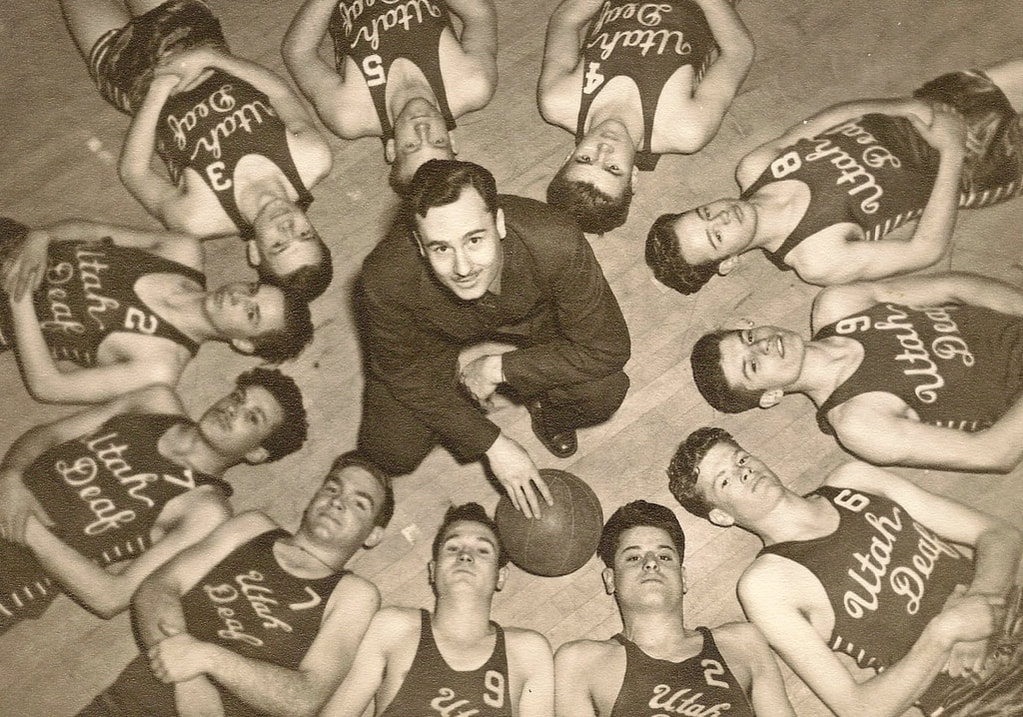
Kenneth C. Burdett and his M-Men basketball team of the Ogden Deaf Branch, 1943-44. Coach Kenneth C. Burdett (Center). Clockwise bottom: #2 Peter Koukoutsakis, #9 Lloyd Perkins, #7 Kirk Allred, #7 Mike Pallerakis, #2 Merrill Bauer, #3 Bruce Eyre, #5 Melvin Sorensen, #4 Paul Loveland, #8 Lyle G. Mortensen, #9 Tony Jealco, and #6 Sam Judd

In the M Men Tournament, the Ogden Branch for the Deaf is the runner-up in the championship. Back row from left to right: Kenneth Burdett, Joe Burnett, Paul Loveland, and Tony Jelace. Front row from left to right: "Pat" Parrerakis, "Konky" Konkanisskis, Lee Shepard, and Kirk Allred. Deseret News, March 17, 1945
Dr. Robert G. Sanderson, a prominent leader of the Utah Deaf community and non-LDS with atheist beliefs who deeply empathized with the Ogden Branch's struggles, was in a heated dispute with Dr. Bitter. His strong opposition to Dr. Bitter's involvement with the Ogden Branch for the Deaf and its seminary was evident in his letter to Stake President Gunn McKay. Dr. Sanderson wrote a letter using Branch President Ken Kinner's name and handed it to Ken, asking him to keep his name anonymous. Written on behalf of the Branch Presidency, this letter not only expressed concerns but also requested intervention, thereby marking a significant turning point in the feud and underlining the profound impact on the Ogden Branch for the Deaf and its deaf seminary program (Kenneth L. Kinner, personal communication, June 19, 2011; Charles Roy Cochran, personal communication, April 19, 2012).
In an effort to address the ongoing issues, Stake President McKay organized a meeting with Branch President Kinner, his interpreter Lucy McMills Greenwood, Dr. Bitter, and Boyd Neilsen. However, he had to end the meeting early due to a prior commitment to another meeting. Despite this, his leadership in the intervention process was crucial. His election to Congress and subsequent relocation to Washington, D.C., limited his further involvement. Stake President Keith Jensen took over from Gunn McKay, who was aware of the branch's issues but unsure about the course of action (Kenneth L. Kinner, personal communication, June 19, 2011).
After careful consideration, the Ogden Stake presidency reached a decision. The Ogden Stake presidency decided that oral children should attend the hearing wards, and Deaf children, who primarily communicate through sign language, should go to the Ogden Branch. This decision, communicated by Charles Roy Cochran, marked a significant shift in the Ogden Branch (Charles Roy Cochran, personal communication, April 19, 2012).
In an effort to address the ongoing issues, Stake President McKay organized a meeting with Branch President Kinner, his interpreter Lucy McMills Greenwood, Dr. Bitter, and Boyd Neilsen. However, he had to end the meeting early due to a prior commitment to another meeting. Despite this, his leadership in the intervention process was crucial. His election to Congress and subsequent relocation to Washington, D.C., limited his further involvement. Stake President Keith Jensen took over from Gunn McKay, who was aware of the branch's issues but unsure about the course of action (Kenneth L. Kinner, personal communication, June 19, 2011).
After careful consideration, the Ogden Stake presidency reached a decision. The Ogden Stake presidency decided that oral children should attend the hearing wards, and Deaf children, who primarily communicate through sign language, should go to the Ogden Branch. This decision, communicated by Charles Roy Cochran, marked a significant shift in the Ogden Branch (Charles Roy Cochran, personal communication, April 19, 2012).
The dispute persisted despite Dr. Sanderson's assistance to help resolve the internal issues. Branch President Kinner and his 1st Counselor Cochran reported ongoing and disruptive interference with religious services and activities by Dr. Bitter and his oral advocate team and requested intervention. While Ken and Roy were dealing with challenges, Bishop Lloyd H. Perkins of the Salt Lake Valley Ward for the Deaf discovered Dr. Bitter's attempt to take control of the branch and seminar. He acted quickly and decisively, bringing peace of mind to the former oral Deaf students from Dr. Bitter's seminary class who had joined his ward. Those former students informed Bishop Perkins that Dr. Bitter had warned them not to attend the deaf branch or ward because sign language was "awful." After learning this, Bishop Perkins, with the support of Branch President Kinner, took immediate action to resolve the contentious situation. This included clearly communicating to the former oral members that they were welcome in the ward and that the sign language wasn't bad, as Dr. Bitter claimed. This reaffirmed inclusivity and support for the Deaf Latter-day Saints community (Kenneth L. Kinner, personal communication, June 19, 2011).
A Seminary Building for
the Deaf Becomes a Reality
the Deaf Becomes a Reality
After years of conflict with Dr. Bitter and his team, the Ogden Branch leaders requested intervention, but to no avail. Finally, Neal Maxwell, the chairman of the Church Educational Department, along with his assistant, Mr. Bradshaw, stepped in to investigate the Ogden Branch for the Deaf. Mr. Bradshaw spent several months visiting and talking with local church leaders to resolve the issues. He reported back to the Church Department, which decided in 1974 to buy a plot of land on the Utah School for the Deaf campus and build a seminary building on the south end of 20th Street. As a result, the Ogden Seminary for the Deaf received its own building adjacent to the Utah School for the Deaf campus in 1976, fulfilling a dream. Richard Snow, a pivotal figure, served as the first Deaf principal and teacher of the seminary classes in Ogden and Salt Lake City for 34 years, leaving an indelible mark on the institution. Following Brother Snow’s retirement in 2008, Nathan Van De Graff, another Deaf individual, took on the role of principal and seminary teacher for the Salt Lake area, continuing the legacy of dedication and service (Kenneth L. Kinner, personal communication, June 19, 2011; Richard Snow, personal communication, February 9, 2012).
When the Church Educational Department revamped the deaf seminary program, Dr. Bitter had to make a difficult decision. The church asked him to choose between his coordinating position at the University of Utah and the deaf seminary program. After careful consideration, he decided to resign from his position as seminar coordinator. This decision, along with Boyd Nielson stepping down as the principal of the seminary classes after the completion of the new seminary building and the oral teachers from the Utah School for the Deaf ceasing to teach the seminary classes, has brought about significant changes in the seminary program (Kenneth L. Kinner, personal communication, June 19, 2011). We will never be able to confirm whether this is the case. We could always speculate.
During Charles Roy Cochran's tenure as branch president of the Ogden Branch for the Deaf, a significant event took place in October 1976. The Ogden Seminary for the Deaf, a long-held dream, became a reality with the purchase of its own building next to the Utah School for the Deaf campus. The Church Educational Department, recognizing the importance of this achievement, extended a warm invitation to all visitors to the new facility. This inclusive open house event was a testament to their commitment to community and learning. Edward Fisher, a fluent signer and principal, and Kyle Jaussi, a dedicated teacher, led the class, demonstrating the potential and promise of our new seminary (UAD Bulletin, October 1976).
In 1961, G. Leon Curtis was hired as a seminary instructor. He expressed his excitement about the construction of a seminary building on his beautiful property (Utah Eagle, October 1961, p. 12). His wish came true fifteen years later, in 1976.
During Charles Roy Cochran's tenure as branch president of the Ogden Branch for the Deaf, a significant event took place in October 1976. The Ogden Seminary for the Deaf, a long-held dream, became a reality with the purchase of its own building next to the Utah School for the Deaf campus. The Church Educational Department, recognizing the importance of this achievement, extended a warm invitation to all visitors to the new facility. This inclusive open house event was a testament to their commitment to community and learning. Edward Fisher, a fluent signer and principal, and Kyle Jaussi, a dedicated teacher, led the class, demonstrating the potential and promise of our new seminary (UAD Bulletin, October 1976).
In 1961, G. Leon Curtis was hired as a seminary instructor. He expressed his excitement about the construction of a seminary building on his beautiful property (Utah Eagle, October 1961, p. 12). His wish came true fifteen years later, in 1976.
The Deaf Seminary Program soon expanded in the Salt Lake area when Richard Snow became the full-time principal at the Salt Lake Seminary for the Deaf, while Edward Fisher served as the first full-time principal at the Ogden Seminary for the Deaf (Richard Snow, personal communication, December 21, 2014).
When Edward Fisher departed for Alaska, Richard Snow, a deaf seminary pioneer, took over as the second full-time principal of the deaf seminary in Ogden, Utah. Lucy McMills Greenwood frequently interpreted his meetings at the Ogden Seminary for him. In 1994, the Utah School for the Deaf relocated to 7th Street, integrating the majority of Deaf students and leaving no room for his teaching. He then relocated to Salt Lake City, Utah, where he served as a Deaf principal and taught seminary in sign language to students at Skyline High, Bonneville Junior High, and Churchill Junior High. He also taught Institute of Religion classes at Salt Lake Community College and the University of Utah, as well as a seminary class at the Jean Massieu School of the Deaf in Salt Lake City for both Deaf and hearing-signing students. Additionally, he utilized the videophone to teach deaf classes in New York, Indiana, and Arizona. The first videophone seminary graduate was Tahnee Brinks Woodbury, a Deaf student from the Indiana School for the Deaf. She married Max Woodbury III, a descendant of Max W. Woodbury, the 51-year branch president of the Ogden Branch for the Deaf, at the Nauvoo Temple (Richard Snow, personal communication, December 21, 2014).
With their unwavering dedication, the Ogden Branch presidency had high hopes for Edward Fisher's appointment as principal of the deaf seminary program. They believed it would help the Ogden Seminary Branch overcome challenges and obstacles. However, the number of Deaf children enrolled in the seminary program has reduced dramatically due to decisions made by oral advocate parents. This drop in attendance had an impact on the deaf seminary program, leading to the operation of a smaller class. A similar situation occurred in the early 1960s when parent oral advocates wrote a letter to the Utah State Office of Education advocating for the implementation of the dual-track program at the Utah School for the Deaf, resulting in a drop in Ogden's deaf residential enrollment due to mainstreaming in nearby public schools.
Similarly, after receiving letters from oral advocate parents, Stake President Jensen and Branch President Kinner convened a meeting. Stake President Jensen, who understood the parents' concerns, informed Ken that the parents of the oral Deaf children insisted on transferring them to a nearby hearing ward. The branch presidency's involvement in oral seminary classes upset the parents. Branch President Kinner, together with sign language interpreter Lucy McMills Greenwood, expressed disappointment and discouragement. Respecting the parents' wishes, Stake President Jensen granted the parents' request to have their orally Deaf children attend the 31st ward, resulting in a drop in the Ogden Deaf Branch's enrollment.
Despite the new seminary building on the school campus, the Ogden Branch for the Deaf has encountered new challenges. These included a shortage of leadership roles among young Deaf Latter-day Saints, decreased enrollment in the chapel and its seminary program, and limited membership (Kenneth L. Kinner, personal communication, June 19, 2011). Nevertheless, the Deaf Latter-Day Saints community, driven by their commitment, continued to provide a deaf seminary program. Richard Snow has been teaching this program for over 30 years, which is a testament to his dedication and the respect he commands within the community.
Similarly, after receiving letters from oral advocate parents, Stake President Jensen and Branch President Kinner convened a meeting. Stake President Jensen, who understood the parents' concerns, informed Ken that the parents of the oral Deaf children insisted on transferring them to a nearby hearing ward. The branch presidency's involvement in oral seminary classes upset the parents. Branch President Kinner, together with sign language interpreter Lucy McMills Greenwood, expressed disappointment and discouragement. Respecting the parents' wishes, Stake President Jensen granted the parents' request to have their orally Deaf children attend the 31st ward, resulting in a drop in the Ogden Deaf Branch's enrollment.
Despite the new seminary building on the school campus, the Ogden Branch for the Deaf has encountered new challenges. These included a shortage of leadership roles among young Deaf Latter-day Saints, decreased enrollment in the chapel and its seminary program, and limited membership (Kenneth L. Kinner, personal communication, June 19, 2011). Nevertheless, the Deaf Latter-Day Saints community, driven by their commitment, continued to provide a deaf seminary program. Richard Snow has been teaching this program for over 30 years, which is a testament to his dedication and the respect he commands within the community.
In the October 1988 issue of the Utah Association for the Deaf Bulletin, Mabel Bell, a pseudonym used by Ron Nelson, a former oral Deaf person raised in a hearing Latter-day Saint family, shared his experiences and views on the parents' decision to raise a Deaf child. He said, "Utah's strong Latter-day Saint population often presents a challenging situation for LDS families with a deaf child." The Mormons hold their families in high regard, valuing the concept of "togetherness." However, when they have a deaf child, they often find themselves grappling with the question of how to achieve and maintain this cherished "family togetherness." It becomes evident that the deaf child can't fully participate in all of the family's daily activities. Struggling parents sometimes opt to enroll their child in an oral program at school, hoping to normalize their child and foster "family togetherness." Another, perhaps more effective, solution would be for the parents and the siblings to learn American Sign Language (ASL, formerly known as total communication) and use that as the primary mode of communication when the deaf child is present. "I believe those parents who learn ASL will experience a deeper sense of family togetherness than those who choose the oral method," Ron concluded (Nelson, UAD Bulletin, October 1988, p. 4). Learning ASL can open up new avenues of communication and understanding within the family, fostering a stronger sense of togetherness and unity.
A year before the deaf seminary building was constructed in 1976, the stake presidency underwent reorganization in 1975. One day, Apostle Mark E. Petersen visited Branch President Kinner and inquired about a stake president candidate. Apostle Petersen then asked about the branch's inability to engage in mutual youth activities. As previously mentioned, Branch President Kinner recounted the challenges. The following day, Apostle Petersen spoke about the Stake Presidency's business at the Stake Conference. In his closing remarks, he exclaimed, "Attention, Attention! "Please help the Ogden Branch for the Deaf establish the Kingdom of God on Earth" (Kenneth L. Kinner, personal communication, June 19, 2011).
In 1975, Glenn F. Holley, the new stake president, released Branch President Kinner of his duties and appointed Charles Roy Cochran as the new branch president. Kenneth and Roy continued to collaborate to resolve the branch's internal issues. Stake President Holley met with Utah School for the Deaf officials and questioned the separation of oral and signing children from youth activities. They informed him of the school's two-track policy, which had evolved from a dual-track program adopted in 1962 to a two-track program established in 1970. "We are the children of God," Stake President Holley stated before urging them to leave the branch alone (Kenneth L. Kinner, personal communication, June 19, 2011).
In 1975, Glenn F. Holley, the new stake president, released Branch President Kinner of his duties and appointed Charles Roy Cochran as the new branch president. Kenneth and Roy continued to collaborate to resolve the branch's internal issues. Stake President Holley met with Utah School for the Deaf officials and questioned the separation of oral and signing children from youth activities. They informed him of the school's two-track policy, which had evolved from a dual-track program adopted in 1962 to a two-track program established in 1970. "We are the children of God," Stake President Holley stated before urging them to leave the branch alone (Kenneth L. Kinner, personal communication, June 19, 2011).
Kenneth L. Kinner, former branch president, reflected on an ongoing trend at the Ogden Branch for the Deaf. He stated that the branch is committed to preserving sign language, a vital part of Deaf Latter-day Saints community's identity, by incorporating it into the classroom. Graduates from the Utah School for the Deaf, including oral Deaf students, found a home at the Ogden Branch and proudly embraced sign language. The community's growth provided hope, as the number of members slowly increased. Although the challenges of running the branch with a small membership were significant, their deep connection to it was a testament to Branch President Max W. Woodbury's memories and his steadfast efforts to establish a church that Deaf members desperately needed (Kenneth L. Kinner, personal communication, June 19, 2011).
The View of the Deaf Community on
The Church of Jesus Christ of Latter-day Saints
and Its Impact on Deaf Education Policy
at the National Level
The Church of Jesus Christ of Latter-day Saints
and Its Impact on Deaf Education Policy
at the National Level
With this in mind, it's clear that despite the efforts of individuals like Dr. Grant B. Bitter, American Sign Language (ASL) continues to thrive within The Church of Jesus Christ of Latter-day Saints. This is a testament to the church's recognition of the importance of Deaf origins in the formation of Deaf units worldwide, particularly in the United States (Dan Mathis, personal communication, April 24, 2012). The Church of Jesus Christ of Latter-day Saints actively and wholeheartedly supports ASL and Deaf culture in various ways, demonstrating its deep respect and value for these aspects of the community. These efforts include providing ASL Seminary and Institute classes via videophone with Deaf instructors; expanding video production with ASL translations, including Minnie Mae Wilding-Diaz's ASL Book of Mormon translation videos; publishing important messages in church magazines in ASL; and having Deaf translators translate church teachings into ASL monthly. The Missionary Training Program (MTC) also incorporates ASL in classes. Rumors in the Deaf Latter-day Saints community suggest that Dr. Bitter sought to prevent the Church Presidency from allowing ASL classes at MTC, but the truth of this rumor remains unknown.
However, there are still members of The Church of Jesus Christ of Latter-day Saints who hold beliefs and ideologies that contradict the ASL/English bilingual community (replaced with Total Communication). The Utah Deaf community has been advocating for Deaf children and their parents who embrace ASL, per Dan Mathis's personal communication on April 24, 2012. According to the Utah Deaf community, two individuals who contradict these efforts are Dr. Karl R. White and Steven W. Noyce.
Dr. White, the founder and director of Utah State University's National Center for Hearing Assessment and Management (NCHAM), aimed to use Early Hearing Detection and Intervention (EHDI) programs in the United States and abroad to create an international database of hearing loss causes and increase genetic services by training medical professionals (Clark and Riker, 2010). Under his NCHAM direction in 2012, his advancement in listening and spoken language, as well as cochlear implants, could have a direct impact on sign language learning and state schools for the deaf both nationally and internationally. The Deaf community was outraged by his "Eugenic-Style" bills in California and Indiana. According to national Deaf activists who learned more about Dr. White, he was from Utah and was an active member of The Church of Jesus Christ of Latter-day Saints (he was a stake president of his local stake ward at the time). This affected the Deaf community's perception of the church, making them uneasy about its influence over national deaf education policy. Deaf activists questioned his religious beliefs as well as his role as an LDS member in his medical practice, which he utilized to discriminate against the humanity and choices of Deaf newborns.
Dr. White, the founder and director of Utah State University's National Center for Hearing Assessment and Management (NCHAM), aimed to use Early Hearing Detection and Intervention (EHDI) programs in the United States and abroad to create an international database of hearing loss causes and increase genetic services by training medical professionals (Clark and Riker, 2010). Under his NCHAM direction in 2012, his advancement in listening and spoken language, as well as cochlear implants, could have a direct impact on sign language learning and state schools for the deaf both nationally and internationally. The Deaf community was outraged by his "Eugenic-Style" bills in California and Indiana. According to national Deaf activists who learned more about Dr. White, he was from Utah and was an active member of The Church of Jesus Christ of Latter-day Saints (he was a stake president of his local stake ward at the time). This affected the Deaf community's perception of the church, making them uneasy about its influence over national deaf education policy. Deaf activists questioned his religious beliefs as well as his role as an LDS member in his medical practice, which he utilized to discriminate against the humanity and choices of Deaf newborns.
On the other hand, Steven W. Noyce, a former superintendent of the Utah Schools for the Deaf and the Blind, was no stranger to the Utah Deaf community. Several members of the Utah Deaf community were aware that he was a former student of Dr. Grant B. Bitter's Oral Training Program at the University of Utah, as mentioned in his letter dated December 2, 1971. When he was hired in 2009, the local Deaf community believed that he, as a new superintendent, would want to continue the profound legacy of Dr. Bitter's program.
Additionally, some Deaf members of The Church of Jesus Christ of Latter-day Saints were deeply concerned that Steven Noyce, who was also a member of the church, opposed the linguistic and cultural values of the Deaf community. The Utah Deaf Education Core Group, mainly consisting of Deaf members of the church, actively fought against perceived bias in favor of listening and spoken language over sign language. Dr. Bitter was responsible for both deaf education and deaf seminary from the 1960s to the 1980s, while Steven Noyce served as a teacher, director, and superintendent for over 30 years. For more information about education issues at the Utah School for the Deaf, you can visit the "Dr. Robert G. Sanderson's Dream" website.
Additionally, some Deaf members of The Church of Jesus Christ of Latter-day Saints were deeply concerned that Steven Noyce, who was also a member of the church, opposed the linguistic and cultural values of the Deaf community. The Utah Deaf Education Core Group, mainly consisting of Deaf members of the church, actively fought against perceived bias in favor of listening and spoken language over sign language. Dr. Bitter was responsible for both deaf education and deaf seminary from the 1960s to the 1980s, while Steven Noyce served as a teacher, director, and superintendent for over 30 years. For more information about education issues at the Utah School for the Deaf, you can visit the "Dr. Robert G. Sanderson's Dream" website.
During the "2012 Deaf Studies Today!" Conference at Utah Valley University, leaders from the Deafhood Foundation and Deaf Bilingual Coalition, including Ella Mae Lentz, Judy Gough, Ruthie Jordan, and Patti Durr, were in conflict with the Oral Only Option Schools Group, a new grassroots organization influenced by the Alexander Graham Bell Association. This conflict occurred in California, Indiana, Delaware, and other states. At the conference, these leaders requested a meeting with local Deaf leaders. Dan Mathis, who chaired the Education Committee under the Utah Association of the Deaf, along with some colleagues from The Church of Jesus Christ of Latter-day Saints, including Dr. J. King Freeman, Dr. Bryan Eldridge, Dr. Curtis Radford, and James Smith, had the opportunity to engage in a discussion with the Deaf activists about the role of The Church of Jesus Christ of Latter-day in deaf education, particularly in Utah. During the conversation, it became apparent that the Deaf activists were unfamiliar with the priesthood leadership hierarchy, its role in the LDS Church, and its structure. Some of them mistakenly believed that it was a paid position, and that individuals advanced through the ranks based on their professional performance and the number of "deeds" they had committed in their lives. The LDS colleagues, showing great respect for the Deaf activists' perspectives, clarified that the church is separate from individuals' work lives and that The Church of Jesus Christ of Latter-day Saints has no direct role in deaf education. They clarified that the church calls its leadership to a higher level of authority. Furthermore, Dan Mathis explained that the LDS religion encourages its members to do good deeds and engage in community service to improve their quality of life. However, he also acknowledged that well-intentioned members might inadvertently bring principles into their initiatives that they believe are good or right but, in reality, end up harming others, as exemplified by Dr. White and Mr. Noyce's intentions for the Deaf community. The Deaf activists appeared receptive to this discussion and appreciated the insights shared by their LDS colleagues about The Church of Jesus Christ of Latter-day Saints' volunteer orientation (Dan Mathis, personal communication, April 24, 2012).
Many advocates for the Deaf community within The Church of Jesus Christ of Latter-day Saints were concerned that Dr. Grant B. Bitter, Steven W. Noyce, and Dr. Karl R. White might have unintentionally overlooked the linguistic and cultural values of the diverse Deaf community, despite their good intentions. Dan Mathis emphasized the importance of communicating this concern to the global church membership. He stated that it is crucial for leaders and prominent members of The Church of Jesus Christ of Latter-day Saints to recognize and address the needs of this diverse deaf minority in terms of ethnicity, culture, and language. He expressed hope that the church would take urgent action to raise awareness of these issues (Dan Mathis, personal communication, April 24, 2012).
Minnie Mae Wilding-Diaz, a translator of the Book of Mormon and co-founder of the Jean Massieu School of the Deaf, emphasized the importance of recognizing that within any church, even one that is good and led by great leaders, there will always be individuals whose views may not align with the church's values. The fundamental belief in free agency, she emphasized, is the foundation of our faith.
Minnie Mae Wilding-Diaz, a translator of the Book of Mormon and co-founder of the Jean Massieu School of the Deaf, emphasized the importance of recognizing that within any church, even one that is good and led by great leaders, there will always be individuals whose views may not align with the church's values. The fundamental belief in free agency, she emphasized, is the foundation of our faith.
The ongoing challenges and obstacles that Ogden Branch leaders Kenneth L. Kinner and Charles Roy Cochran faced in dealing with Dr. Grant B. Bitter and his oral advocate team's interference have had a profound impact on the Utah Deaf community. Despite Dr. Bitter's influence, Ken and Roy had demonstrated remarkable resilience and perseverance, and they were a beacon of hope for the Deaf Latter-day Saints community. The ongoing and complex debate over the appropriate communication methodology is thought-provoking, inspiring a sense of optimism for a better future. Several obstacles have also marked the history of the Utah Deaf community, shaping their education and religious beliefs and serving as a sharp reminder of the challenges they have endured. Nonetheless, Deaf leaders such as Kenneth L. Kinner and Charles Roy Cochran of the Ogden Branch have developed tremendous resilience and perseverance, allowing them to overcome challenges, adapt to change, and persevere through difficult circumstances while moving forward to run the Ogden Branch for the Deaf. Their capacity for resilience and perseverance is admirable and recognized; it is a testament to the power of determination and a source of inspiration for the entire Deaf Latter-day Saints community.
Did You Know?
The Ogden Branch for the Deaf held an unveiling ceremony to honor Branch President Max W. Woodbury, the longest-serving branch president in 51 years. In 1976, Kenneth L. Kinner and C. Roy Cochran, long-time dedicated leaders of the Ogden Branch for the Deaf, held a portrait of Max at the Ogden Branch for the Deaf. Take a look at the picture below.
The following are excerpts from some Deaf people who wrote about their memories of Max for the January 1974 Utah Eagle magazine.
I REMEMBER MAX W. WOODBURY...
“I had known Brother Max W. Woodbury for over fifty years. I was with him as a student and later as a teacher in the Utah School for the Deaf as well as the Latter Day Saints Branch for the Deaf. All the deaf people in Utah looked up to Brother Woodbury as a great man who served not because a task had been assigned, but one of the desires of his heart. By the measure he achieved true greatness. He never flinched from what was right and just and his values were high." - Kenneth C. Burdett, Curriculum Coordinator of the Total Communication Division, Utah School for the Deaf
The life of Max W. Woodbury has been much more than just a great inspiration to me. During my many years of pleasant association with him, I have found him to be a very dedicated man to the cause of the deaf, be it education, religion, or welfare. He gave an overflowing measure of devotion to the causes. The privileges of having him as a teacher and counselor has been a great rewarded. The influence he has left on the lives of the people who have known him will long be felt. - Donald Jensen, Instructor, Utah School for the Deaf
“On behalf of the members of the Branch for the Deaf, we pay our last tribute to resident Max W. Woodbury. We feel deeply the loss of a fine dedicated teacher and spiritual leader who taught us a philosophy of life that helps us meet the challenges of this world. The gospel of Jesus Christ, which he taught us, will make us better men and women and help us to receive joy and happiness in our lives.
No man that we have known has ever lived a more useful life of service to deaf people than President Max W. Woodbury. His untiring service in furthering our education and religion was greatly appreciated. It is our desire and responsibility to so live that we will ever reflect credit to his sincere efforts. We will never forget his kindness, fatherly advice and love shown to us. He leaves with us the memory of his fine leadership and sweet personality. He was a man of superior courage, one we have loved and respected during the years we have spent together.”
Ogden LDS Branch for the Deaf.
Kenneth L. Kinner, Branch President
C. Roy Cochran, First Counselor
W. Ronald Johnson, Second Counselor
Source: R.W.T., The Utah Eagle, January 1974, p. 1-2)
The following are excerpts from some Deaf people who wrote about their memories of Max for the January 1974 Utah Eagle magazine.
I REMEMBER MAX W. WOODBURY...
“I had known Brother Max W. Woodbury for over fifty years. I was with him as a student and later as a teacher in the Utah School for the Deaf as well as the Latter Day Saints Branch for the Deaf. All the deaf people in Utah looked up to Brother Woodbury as a great man who served not because a task had been assigned, but one of the desires of his heart. By the measure he achieved true greatness. He never flinched from what was right and just and his values were high." - Kenneth C. Burdett, Curriculum Coordinator of the Total Communication Division, Utah School for the Deaf
The life of Max W. Woodbury has been much more than just a great inspiration to me. During my many years of pleasant association with him, I have found him to be a very dedicated man to the cause of the deaf, be it education, religion, or welfare. He gave an overflowing measure of devotion to the causes. The privileges of having him as a teacher and counselor has been a great rewarded. The influence he has left on the lives of the people who have known him will long be felt. - Donald Jensen, Instructor, Utah School for the Deaf
“On behalf of the members of the Branch for the Deaf, we pay our last tribute to resident Max W. Woodbury. We feel deeply the loss of a fine dedicated teacher and spiritual leader who taught us a philosophy of life that helps us meet the challenges of this world. The gospel of Jesus Christ, which he taught us, will make us better men and women and help us to receive joy and happiness in our lives.
No man that we have known has ever lived a more useful life of service to deaf people than President Max W. Woodbury. His untiring service in furthering our education and religion was greatly appreciated. It is our desire and responsibility to so live that we will ever reflect credit to his sincere efforts. We will never forget his kindness, fatherly advice and love shown to us. He leaves with us the memory of his fine leadership and sweet personality. He was a man of superior courage, one we have loved and respected during the years we have spent together.”
Ogden LDS Branch for the Deaf.
Kenneth L. Kinner, Branch President
C. Roy Cochran, First Counselor
W. Ronald Johnson, Second Counselor
Source: R.W.T., The Utah Eagle, January 1974, p. 1-2)
Notes
Cherie Carpenter Hodson, personal communication, October 18, 2010.
Dan Mathis, personal communication, April 24, 2012.
Kenneth L. Kinner, personal communication, June 19, 2011.
Minnie Mae Wilding-Diaz, personal communication, April 15, 2012.
Richard Snow, personal communication, February 9, 2012.
Richard Snow, personal communication, December 21, 2014.
Roy Cochran, personal communication, April 19, 2012.
Steven Noyce, personal communication, December 2, 1971.
Dan Mathis, personal communication, April 24, 2012.
Kenneth L. Kinner, personal communication, June 19, 2011.
Minnie Mae Wilding-Diaz, personal communication, April 15, 2012.
Richard Snow, personal communication, February 9, 2012.
Richard Snow, personal communication, December 21, 2014.
Roy Cochran, personal communication, April 19, 2012.
Steven Noyce, personal communication, December 2, 1971.
References
The Utah Eagle, February 1968 - Add needed
“A Sunday School Organized for the Deaf Mutes.” The Daily Enquirer, February 11, 1892.
"An Age of Dignity, Honor." Deseret News, May 4, 1968.
Baldwin, Stephen C. “Mainstreaming in retrospect: A Deaf Perception.” National Association of the Deaf (1990): 14-16.
Bell, Mabel. “The Deaf Eye.” UAD Bulletin, vol. 12, no. 6 (October 1988): 4.
Bitter, Grant. “A Summary Report for Tenure.” Grant B. Dr. Bitter Papers, Accn #1072. Manuscripts Division, J. Willard Marriott Library, University of Utah, Salt Lake City, Utah, March 15, 1985.
Clark, K. & Riker, T. (2010, June 7). “Mendoza Against the Deaf: Tony Mendoza California Eugenics-Style Bill Creates Uproar Among the Deaf Community.” http://www.thecuttingedgenews.com/index.php?article=12260&pageid=&pagename=
Christiansen, E. (1918). “The YLMIA of the Branch for the Deaf.” Copied from the Young Women’s Journal, Vol. 29.
Cochran, Charles Roy. Max W. Woodbury. Ogden Standard-Examiner, January 13, 1968, and December 30, 1977).
Cochran, Charles Roy. History of the Ogden Branch for the Deaf, 1999.
Curtis, G. Leon. “With Our Alumni.” The Utah Eagle (October 1961): 12.
'Dream, O Youth,' Session's Theme." The Salt Lake Tribune, May 5, 1970.
"First Organization of the Kind in the World." Ogden Standard-Examiner, February 5, 1917.
Grant B. Bitter. The Utah Eagle, vol. 74, no. 1 (October 1962): 11.
Historical Events and Persons Involved Branch for the Deaf - Compiled February 11, 1992.
History of the Ogden Branch for the Deaf, 1979.
History of the Ogden Branch. Unknown date.
Jones, Harry. "Ogden Deaf Branch Takes Leading Part in Teaching Gospel." Deseret News, July 30, 1952.
Larsen, Cary. "Deaf Youngsters Learns of God." The Salt Lake Tribune, October 7, 1967.
“New seminary at USD.” UAD Bulletin, Vol. 11, No. 3 (October 1976): 3.
Pace, Irma Acord. “A History of the Utah School for the Deaf.” The Utah Eagle, vol. 58, no. 1 (May18, 1946): 1-33.
"Program Arranged for Deaf Seminary Pupils." Deseret News, September 16, 1961.
Scott, George, L. (-).
“Seminary Class Stared At School for Deaf.” The UAD Bulletin, vo1. 2, no. 4 (Fall 1961): 3.
"SWinging 'round the nation." The Silent Worker, vol. 16, no. 5 (January 1964): 15.
Sueldo, Manuel A. 'Stay Firm In The Gospel.' Deseret News, April 26, 1969.
The Church of Jesus Christ of Latter-day Saints: Branch for the Deaf, Ogden. Ward Stake Historical Record Book #4. 1941 – 1945.
“Two Events Will Honor Deaf Branch President.” Ogden Standard-Examiner, February 4, 1967.
“Unveiling Ceremony at Ogden Branch.” UAD Bulletin, vol. 11, no. 3 (October 1976): 2.
White, Bob. (1920, October). Ogden’s social and religious Center. The Silent Worker vol. 33 no. 1, p. 32. http://dspace.wrlc.org/view/ImgViewer?url=http://dspace.wrlc.org/doc/manifest/2041/38209
Woodbury, Max. W. History of the Branch. “A Sunday School Organized for the Deaf Mutes.” The Daily Enquirer, February 11, 1892.
“A Sunday School Organized for the Deaf Mutes.” The Daily Enquirer, February 11, 1892.
"An Age of Dignity, Honor." Deseret News, May 4, 1968.
Baldwin, Stephen C. “Mainstreaming in retrospect: A Deaf Perception.” National Association of the Deaf (1990): 14-16.
Bell, Mabel. “The Deaf Eye.” UAD Bulletin, vol. 12, no. 6 (October 1988): 4.
Bitter, Grant. “A Summary Report for Tenure.” Grant B. Dr. Bitter Papers, Accn #1072. Manuscripts Division, J. Willard Marriott Library, University of Utah, Salt Lake City, Utah, March 15, 1985.
Clark, K. & Riker, T. (2010, June 7). “Mendoza Against the Deaf: Tony Mendoza California Eugenics-Style Bill Creates Uproar Among the Deaf Community.” http://www.thecuttingedgenews.com/index.php?article=12260&pageid=&pagename=
Christiansen, E. (1918). “The YLMIA of the Branch for the Deaf.” Copied from the Young Women’s Journal, Vol. 29.
Cochran, Charles Roy. Max W. Woodbury. Ogden Standard-Examiner, January 13, 1968, and December 30, 1977).
Cochran, Charles Roy. History of the Ogden Branch for the Deaf, 1999.
Curtis, G. Leon. “With Our Alumni.” The Utah Eagle (October 1961): 12.
'Dream, O Youth,' Session's Theme." The Salt Lake Tribune, May 5, 1970.
"First Organization of the Kind in the World." Ogden Standard-Examiner, February 5, 1917.
Grant B. Bitter. The Utah Eagle, vol. 74, no. 1 (October 1962): 11.
Historical Events and Persons Involved Branch for the Deaf - Compiled February 11, 1992.
History of the Ogden Branch for the Deaf, 1979.
History of the Ogden Branch. Unknown date.
Jones, Harry. "Ogden Deaf Branch Takes Leading Part in Teaching Gospel." Deseret News, July 30, 1952.
Larsen, Cary. "Deaf Youngsters Learns of God." The Salt Lake Tribune, October 7, 1967.
“New seminary at USD.” UAD Bulletin, Vol. 11, No. 3 (October 1976): 3.
Pace, Irma Acord. “A History of the Utah School for the Deaf.” The Utah Eagle, vol. 58, no. 1 (May18, 1946): 1-33.
"Program Arranged for Deaf Seminary Pupils." Deseret News, September 16, 1961.
Scott, George, L. (-).
“Seminary Class Stared At School for Deaf.” The UAD Bulletin, vo1. 2, no. 4 (Fall 1961): 3.
"SWinging 'round the nation." The Silent Worker, vol. 16, no. 5 (January 1964): 15.
Sueldo, Manuel A. 'Stay Firm In The Gospel.' Deseret News, April 26, 1969.
The Church of Jesus Christ of Latter-day Saints: Branch for the Deaf, Ogden. Ward Stake Historical Record Book #4. 1941 – 1945.
“Two Events Will Honor Deaf Branch President.” Ogden Standard-Examiner, February 4, 1967.
“Unveiling Ceremony at Ogden Branch.” UAD Bulletin, vol. 11, no. 3 (October 1976): 2.
White, Bob. (1920, October). Ogden’s social and religious Center. The Silent Worker vol. 33 no. 1, p. 32. http://dspace.wrlc.org/view/ImgViewer?url=http://dspace.wrlc.org/doc/manifest/2041/38209
Woodbury, Max. W. History of the Branch. “A Sunday School Organized for the Deaf Mutes.” The Daily Enquirer, February 11, 1892.
The Relocation of Ogden
Branch for the Deaf, 1917-1999
Branch for the Deaf, 1917-1999
Compiled & Written by Jodi Becker Kinner
Published in 2012
Updated in 2024
Published in 2012
Updated in 2024
Before discussing the relocation of the Ogden Branch for the Deaf in 1999, let's take a moment to understand the significant role of the Utah School for the Deaf in our history, which led to the branch's formation. On July 24, 1847, the first pioneers of The Church of Jesus Christ of Latter-day Saints arrived in Salt Lake Valley. These Utah pioneers faced a significant challenge: Deaf children needed education, but sending them to deaf schools outside of the area was very expensive. The Colorado School for the Deaf was the nearest school, but the long period of separation from family and religion was a major concern (Pace, 1946). In response, two church members, John Beck and William Wood, who were parents of Deaf children, recognized the need for specialized education for the deaf and took a proactive role in establishing the Utah School for the Deaf, a shining example of their commitment to providing education for all.
Students initially attended the Protestant church after the Utah School for the Deaf was established in Salt Lake City, Utah, in 1884. This was because the teachers came from Protestant backgrounds (Roberts, 1994). However, several Latter-day Saint parents were concerned about their children's Protestant influences. In response to their request, The Church of Jesus Christ of Latter-day Saints established a Sunday School for their children. This historic event took place on January 10, 1892, in Salt Lake City, with a membership of eleven boys and sixteen girls. Elder H.C. Barrell was named the first superintendent of Sunday School, with Deaf Elder Laron Pratt as his assistant (The Daily Enquirer, February 11, 1892).
On November 16, 1896, the Utah School for the Deaf relocated to Ogden, Utah, offering a Sunday School to Deaf and Blind children as well as adults at Ogden's 4th Ward Amusement Hall (Deseret News, November 21, 1896). The Ogden Branch for the Deaf, a Deaf-friendly meetinghouse for Deaf members in Ogden, was established on February 14, 1917, for the students who attended the Utah School for the Deaf and those who lived in the Ogden area. This signing branch was more than just a local initiative; it was a beacon of inspiration for future Deaf branches and wards worldwide, a testament to the strength and resilience of the Deaf Latter-day Saints community. The branch served as a model for future Deaf units, including the Salt Lake Valley Deaf Ward, Los Angeles Deaf Branch, Portland Heights Deaf Branch, Fremont Deaf Branch, Gooding Deaf Branch, and others worldwide (Walker, 2006).
Since 1917, members have been attending the Ogden Branch for the Deaf, a place that holds deep sentimental value for them. However, on June 21, 1998, a significant change was announced. Stake President Mark Johnson called Kenneth L. Kinner, who had served as Branch President of the Ogden Branch for the Deaf twice, and other bishops to a special meeting. The meeting discussed the relocation of the stake presidency, the redrawing of ward boundaries, and the relocation of the Ogden Branch for the Deaf to another stake ward. This news was a heavy blow to Branch President Kinner, who grew up in the Ogden Deaf Branch. After eighty-two years in the first chapel building of the Ogden Branch for the Deaf, Gordon B. Hinckley, the 15th president of The Church of Jesus Christ of Latter-day Saints, decided that the branch would move to a new stake building in South Ogden on January 3, 1999. This decision left the branch members with a mix of emotions, a testament to the deep connection they had with their original meeting place.
Since 1917, members have been attending the Ogden Branch for the Deaf, a place that holds deep sentimental value for them. However, on June 21, 1998, a significant change was announced. Stake President Mark Johnson called Kenneth L. Kinner, who had served as Branch President of the Ogden Branch for the Deaf twice, and other bishops to a special meeting. The meeting discussed the relocation of the stake presidency, the redrawing of ward boundaries, and the relocation of the Ogden Branch for the Deaf to another stake ward. This news was a heavy blow to Branch President Kinner, who grew up in the Ogden Deaf Branch. After eighty-two years in the first chapel building of the Ogden Branch for the Deaf, Gordon B. Hinckley, the 15th president of The Church of Jesus Christ of Latter-day Saints, decided that the branch would move to a new stake building in South Ogden on January 3, 1999. This decision left the branch members with a mix of emotions, a testament to the deep connection they had with their original meeting place.
During the stake meeting, around sixty members gathered to hear the latest news about the stake presidency's reorganization. The room was filled with anticipation and anxiety as Branch President Kinner observed the branch members' reactions when Elder Pinnock delivered the shocking news of the branch's move from the Quorums of the Seventy. They were startled and saddened by the news, their hearts heavy with the weight of change. Everyone was overcome with sorrow as they grieved the loss of their treasured branch. Lucy McMills Greenwood, a long-time interpreter and older branch member, was the hardest hit, as it had been her home.
The decision to relocate the branch was made because the chapel building became inconvenient over time. During the annual Christmas party, the cultural hall was overcrowded, making it difficult for older people to use the stairwells. The primary reason for the branch's relocation was to provide a stronger priesthood support system in the new ward and better parking facilities. After moving to the stake building, the Ogden Branch changed its name to the Ogden Valley Deaf Branch (Kenneth L. Kinner, personal communication, June 19, 2011).
Lucy McMills Greenwood,
a long-serving Interpreter, Receives a
Gift of Art from Benjamin Davis, a Deaf Artist
a long-serving Interpreter, Receives a
Gift of Art from Benjamin Davis, a Deaf Artist
Note
Kenneth L. Kinner, interview by Jodi Becker Kinner, “Relocation of the Ogden Branch for the Deaf,” June 19, 2011.
References
“A Sunday School Organized for the Deaf Mutes.” The Daily Enquirer, February 11, 1892.
Giles, Bobby. "Ogden Branch for the Deaf: 90th Anniversary 1917 – 2007." Eye-Sign Media, LLC. 2007. DVD.
“For Blind, Deaf, and Dumb.” Deseret News, November 21, 1896.
Pace, Irma Acord. “A History of the Utah School for the Deaf.” The Utah Eagle, vol. 58, no. 1 (October 1946): 1-33.
Roberts, Elaine M. “The Early History of the Utah School for the Deaf and Its influence in the Development of a Cohesive Deaf Society in Utah, circa. 1884 – 1905.” A thesis presented to the Department of History: Brigham Young University. August 1994.
Walker, Rodney W. My Life Story, 2006.
Giles, Bobby. "Ogden Branch for the Deaf: 90th Anniversary 1917 – 2007." Eye-Sign Media, LLC. 2007. DVD.
“For Blind, Deaf, and Dumb.” Deseret News, November 21, 1896.
Pace, Irma Acord. “A History of the Utah School for the Deaf.” The Utah Eagle, vol. 58, no. 1 (October 1946): 1-33.
Roberts, Elaine M. “The Early History of the Utah School for the Deaf and Its influence in the Development of a Cohesive Deaf Society in Utah, circa. 1884 – 1905.” A thesis presented to the Department of History: Brigham Young University. August 1994.
Walker, Rodney W. My Life Story, 2006.
A Pioneer Day Parade in Utah
on July 24, 1961
on July 24, 1961
Compiled & Written by Jodi Becker Kinner
Published in 2021
Updated in 2024
Published in 2021
Updated in 2024
In 1961, Branch President Spencer C. Hind of the Salt Lake Valley Branch, along with a group of members including Kenneth Kinner, Evelyn Hardy, Bruce Harvey, Sharon Olson, and Robert Kerr, decided to take part in the prestigious 24th of July parade. This event is significant to the Deaf Latter-day Saints community because it commemorates the arrival of the Utah Pioneers in Salt Lake Valley in 1847. Despite facing a shortage of time and funds, they managed to come up with a simple design. Rodney W. Walker's friend, Theodore Collier, generously agreed to lend them his two-wheel trailer, symbolizing the community's support.
Their unwavering commitment to the theme "And on that day, the deaf shall hear the book's words" was evident. Drawing from Isaiah 29:18, the prophet Isaiah's prophecy, they inscribed these words on two poster boards, one for each side of the float. They also printed the words "Salt Lake Valley Branch for the Deaf" on two large sheets of paper, placing a strip on each side of the trailer. A large piece of cardboard, shaped like a book and bearing the words "Book of Mormon" on its cover, served as the centerpiece of the float. Two missionaries and four investigators, a testament to the Deaf Latter-day Saints community's dedication, occupied six floating chairs. The visually striking float, a beacon of their shared values, captivated the attention of thousands of spectators, filling them with pride during the parade.
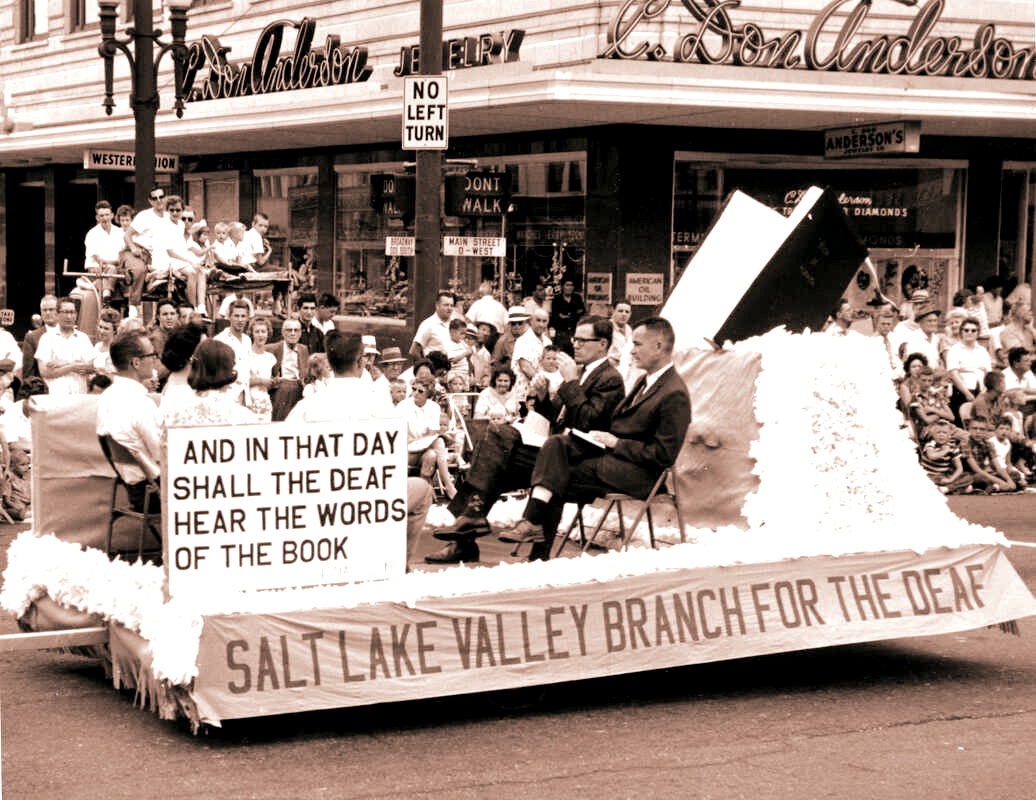
The Salt Lake Valley Branch sponsored the float for the Deaf of The Church of Jesus Christ of Latter-day Saints, which drew the attention of thousands of spectators during the Days of '47 to celebrate the arrival of the Utah Pioneers on July 24, 1960, in Salt Lake City, Utah. While Branch President Spencer C. Hind looks on, Kenneth Kinner gives the lesson in sign language from left to right: Evelyn Hardy, Bruce Hardy, Sharon Olson, and Robert Kerr. Rodney Walker is driving the float (The Silent Worker, November 1961; Rodney, 2006)
Since its founding, the Salt Lake Valley branch's membership has been constantly growing. Over the last twenty-eight years, more Deaf people have moved, converted to church, or added to their families, bringing the total number of Deaf people to 310. The Salt Lake Valley building was quickly filling up. They combined the chapel and the cultural hall to form a single meeting location for the sacrament services (The UAD Bulletin, Fall 1961). The 'A Unique Deaf-Friendly Salt Lake Valley Ward for the Deaf' section below provides more information about the Salt Lake Valley.
References
"Sunday School on Wheel." The UAD Bulletin, vol. 2, no. 4. (Fall 1961): p. 1.
Walker, Rodney. My Life Story. 2006.
"United Utah Organization of the Deaf." The Silent Worker, vol. 14, no. 3. (1961, November). p. 9.
Walker, Rodney. My Life Story. 2006.
"United Utah Organization of the Deaf." The Silent Worker, vol. 14, no. 3. (1961, November). p. 9.
The First Four
Deaf Missionaries
Compiled & Written by Jodi Becker Kinner
Published in 2020
Updated in 2024
Published in 2020
Updated in 2024
Since the formation of the Church of Jesus Christ of Latter-day Saints in 1830, Deaf members were not able to serve on a mission until 1968, when G. Leon Curtis, the branch president of the Ogden Branch for the Deaf, led the way. This was a significant turning point in the church's history. On November 20, 1968, the Church appointed Elder Abel Martinez (Utah) and Elder Wayne Kitchen (Utah) as the first two Deaf missionaries to serve in Los Angeles, California. They received mission training at the Language Training Mission (LTM), which was located at Lafayette Elementary School in downtown Salt Lake City, Utah. The school, which was a former oral school of the Utah School for the Deaf, was eventually owned by the Church of Jesus Christ of Latter-day Saints. It was later demolished, and the site was turned into a parking lot across from the Church Office Building. Abel and Wayne learned how to teach the gospel without a sign language interpreter, as the instructors didn't use sign language. They memorized the scriptures and participated in mission discussions. Several church authorities, including Joseph Fielding Smith and Spencer W. Kimball, spoke at LTM, but no interpreter was available (Abel Martinez, personal communication, April 8, 2020).
Elder Dale Cook of Utah joined the other Deaf missionaries at the California Mission on December 3, 1969. A few days later, on December 9, 1969, Elder Wayne Bennett from Louisiana transferred into the deaf program. Deaf missionaries pioneered as official missionaries for the deaf alongside hearing missionaries Elder Jack Rose, Elder Thayne Grossenbach, and Elder Clark Kemp.
In 1978, at a pivotal moment in the church's history, the Language Training Mission underwent a profound transformation. The church, recognizing the rapid growth and increasing number of missionaries, relocated and reshaped it into the Missionary Training Center. This move symbolized the evolving needs and scope of the church's missionary work, marking a significant chapter in the history of missionary work for the deaf. This period also witnessed the establishment of the American Sign Language Program, a testament to the church's commitment to inclusivity and diversity, bringing together a diverse group of Deaf and hearing missionaries to support the deaf mission.
In 1978, at a pivotal moment in the church's history, the Language Training Mission underwent a profound transformation. The church, recognizing the rapid growth and increasing number of missionaries, relocated and reshaped it into the Missionary Training Center. This move symbolized the evolving needs and scope of the church's missionary work, marking a significant chapter in the history of missionary work for the deaf. This period also witnessed the establishment of the American Sign Language Program, a testament to the church's commitment to inclusivity and diversity, bringing together a diverse group of Deaf and hearing missionaries to support the deaf mission.
Did You Know?
Rodney W. Walker, an 84-year-old man who graduated from the 1933 Utah School for the Deaf and the 1939 Gallaudet College, made history as the first Deaf sealer at the Salt Lake Temple on August 8, 1998. Rodney dedicated nine years of his life to this role. In a poignant testament to his commitment, just four days before his passing on August 2, 2007, he conducted a temple wedding, sealing approximately 80 couples. My spouse, Duane, and I were among them when Rodney sealed us on August 7, 1999. You can see his signature on our temple marriage certificate along with Kenneth L. Kinner, who served as the branch president of the Ogden Branch for the Deaf at the time, as our witness.
Notes
Abel Martinez, personal communication, April 8, 2020.
Doug Stringham, persona communication, April 8, 2020.
Lisa Richard Roush, personal communication, April 8, 2020.
W. David Samuelsen, personal communication, April 15, 2020.
Doug Stringham, persona communication, April 8, 2020.
Lisa Richard Roush, personal communication, April 8, 2020.
W. David Samuelsen, personal communication, April 15, 2020.
A Unique Deaf-Friendly
Salt Lake Valley Ward for the Deaf
Salt Lake Valley Ward for the Deaf
Compiled & Written by Jodi Becker Kinner
Edited by Jennifer Young Leeds
Published in 2020
Updated in 2024
Edited by Jennifer Young Leeds
Published in 2020
Updated in 2024
Prologue
Lloyd H. Perkins, a Deaf carpenter, branch president, and bishop of the Salt Lake City Valley, was a visionary. He proposed the concept of a deaf-friendly church building, which had not yet received official recognition. As the bishop of the Salt Lake Valley Ward for the Deaf, he envisioned unique 'deaf space' elements that would not only meet the visual needs of Deaf members but also foster a sense of inclusivity. It was in 1977 that his idea of a church design that truly embraced the Deaf community began to take shape. I wrote this section with the support of sources and oral history because I felt Lloyd's work deserved recognition.
Jodi Becker Kinner
Jodi Becker Kinner
Bountiful and Salt Lake City
Sunday School Classes for the Deaf
Sunday School Classes for the Deaf
Before delving into the unique deaf-friendly Salt Lake Valley Ward for the Deaf, it's important to recognize the challenges faced by Deaf members in the Salt Lake area. The establishment of the Sunday School for the deaf in Bountiful and later the Salt Lake Valley Branch for the Deaf were significant steps toward addressing these challenges. However, it was the creation of the ward in 1977 that truly catered to the specific needs of Deaf Latter-day Saint members. The establishment of the Salt Lake Valley Ward for the Deaf in 1977 was a beacon of hope, alleviating the significant challenge of attending church services for Deaf members in the Salt Lake area.
At the time, most Deaf individuals lived in Ogden or attended the Utah School for the Deaf, where they went to the Ogden Branch for the Deaf. Unfortunately, the Salt Lake City group did not have Sunday School sessions in their area. The financial burden of traveling to the Ogden Branch for the Deaf, a permanent church chapel in Ogden, for sacrament and priesthood services was a challenge that only a few members could afford. In March 1920, the Wright family, with their ten children, five of whom were deaf, started a mission. Their efforts and determination to ensure their Deaf children learned about the gospel led to a significant increase in Deaf members, with a couple, both deaf, joining the organization. This small group in Bountiful was deeply concerned about the lack of Deaf LDS activity in the Salt Lake area (Thurston, The Improvement Era, January 1946).
At the time, most Deaf individuals lived in Ogden or attended the Utah School for the Deaf, where they went to the Ogden Branch for the Deaf. Unfortunately, the Salt Lake City group did not have Sunday School sessions in their area. The financial burden of traveling to the Ogden Branch for the Deaf, a permanent church chapel in Ogden, for sacrament and priesthood services was a challenge that only a few members could afford. In March 1920, the Wright family, with their ten children, five of whom were deaf, started a mission. Their efforts and determination to ensure their Deaf children learned about the gospel led to a significant increase in Deaf members, with a couple, both deaf, joining the organization. This small group in Bountiful was deeply concerned about the lack of Deaf LDS activity in the Salt Lake area (Thurston, The Improvement Era, January 1946).
The White family's hearing brother-in-law, the visionary Willard E. Barlow, proposed a deaf class and was assigned as their Sunday School instructor. He founded a Sunday School class in the Bountiful First Ward in Bountiful, Utah, with ten members (The Beginning of an Organized Group of Deaf Members; Salt Lake Valley Ward for the Deaf). This marked the beginning of a significant journey, as many Deaf people from nearby towns, particularly Salt Lake City, started to gravitate towards Bountiful.
As a testament to the community's resilience and unity, Salt Lake City residents formed the majority of those who attended the Bountiful Sunday School regularly. Over time, the number swelled to fifty, a remarkable achievement. Most would embark on a journey, taking streetcars to Bamberger and boarding a train to Bountiful (The Beginning of an Organized Group of Deaf Members; Salt Lake Valley Ward for the Deaf; Thurston, The Improvement Era, January 1946).
As a testament to the community's resilience and unity, Salt Lake City residents formed the majority of those who attended the Bountiful Sunday School regularly. Over time, the number swelled to fifty, a remarkable achievement. Most would embark on a journey, taking streetcars to Bamberger and boarding a train to Bountiful (The Beginning of an Organized Group of Deaf Members; Salt Lake Valley Ward for the Deaf; Thurston, The Improvement Era, January 1946).
Elder Willard Barlow and his wife, Jessie, noticed a surge in attendance at the Bountiful Sunday School. To accommodate the growing numbers, they made the decision to move the Sunday School to Salt Lake City. In August 1920, they successfully established and led the Sunday School class in this new location. In 1923, they assigned Gladys Burnham Wenger as their interpreter for the church meeting. Despite residing in Ogden, Gladys selflessly commuted to Bountiful every Sunday on the Bamberger train, with the church covering her expenses (Salt Lake Valley Ward for the Deaf). Her dedication and sacrifice were truly commendable.
For a remarkable span of twenty-eight years, from 1920 to 1948, the Salt Lake City Sunday School group held its classes in nine different locations across the Salt Lake area. These venues, including the Bureau of Information, LDS Business College, Assembly Hall, Missionary Home, Baptistry room, 6th and 7th Ward buildings, LDS University Building, East High Seminary Building, and Lion House (Thurston, The Improvement Era, January 1946; Salt Lake Valley Ward for the Deaf; The Beginning of Organized Group of Deaf Members; Flygare, The Salt Lake Valley Wards PowerPoint, 2008), bear witness to the group's commitment and dedication to their cause.
The Sunday School became increasingly organized in the mid-1940s. The Sunday School designated several members as "missionaries," tasked with reactivating members and teaching the gospel to non-members. At the time, there were three classes. The group believed enough members would show up to legitimize the establishment of a deaf branch in Salt Lake City. However, societal attitudes and misconceptions about their abilities led to the Deaf members' denial of the right to hold priesthood and sacrament meetings for many years.
They met occasionally to stay in touch and keep each other up-to-date on gospel teaching. These meetings often involved lively discussions about various aspects of the gospel, such as its interpretation and application in their lives (The Beginning of Organized Group of Deaf Members; Salt Lake Valley Ward for the Deaf; Thurston, The Improvement Era, January 1946; Flygare, The Salt Lake Valley Wards PowerPoint, 2008). They offered the Sunday School class from 1920 to 1948.
They met occasionally to stay in touch and keep each other up-to-date on gospel teaching. These meetings often involved lively discussions about various aspects of the gospel, such as its interpretation and application in their lives (The Beginning of Organized Group of Deaf Members; Salt Lake Valley Ward for the Deaf; Thurston, The Improvement Era, January 1946; Flygare, The Salt Lake Valley Wards PowerPoint, 2008). They offered the Sunday School class from 1920 to 1948.
Driven by the surge in attendance, Dr. John A. Widtsoe, the esteemed chair of the LDS Church Headquarters' foreign language committee, and Willard E. Barlow, the diligent superintendent of the Salt Lake City Sunday School, embarked on a mission in 1947. Their goal was to explore the potential of establishing a branch for the Deaf members residing in Salt Lake City (Thurston, The Improvement Era, April 1949).
Meanwhile, Deseret Sunday School Union General Superintendent George R. Hill, Rodney W. Walker's boss, sought to gain a better understanding of the Deaf population in the Salt Lake area and their status within The Church of Jesus Christ of Latter-day Saints. To this end, he requested statistics. Rodney, a Deaf member of Salt Lake City, volunteered to compile a comprehensive survey of all Deaf individuals in the Salt Lake area, regardless of their religious affiliation. His statistics, which provided valuable insights, were received by Willard E. Barlow and John A. Widtsoe (Salt Lake Valley Ward for the Deaf; Flygare, The Salt Lake Valley Wards PowerPoint, 2008).
Meanwhile, Deseret Sunday School Union General Superintendent George R. Hill, Rodney W. Walker's boss, sought to gain a better understanding of the Deaf population in the Salt Lake area and their status within The Church of Jesus Christ of Latter-day Saints. To this end, he requested statistics. Rodney, a Deaf member of Salt Lake City, volunteered to compile a comprehensive survey of all Deaf individuals in the Salt Lake area, regardless of their religious affiliation. His statistics, which provided valuable insights, were received by Willard E. Barlow and John A. Widtsoe (Salt Lake Valley Ward for the Deaf; Flygare, The Salt Lake Valley Wards PowerPoint, 2008).
After twenty-eight years without a permanent 'home' in the Salt Lake area, the Foreign Language Committee approved the plan to establish a branch for the deaf. (Thurston, The Improvement Era, April 1949; Flygare, The Salt Lake Valley Wards PowerPoint, 2008).
Bishop Thorpe B. Isaacson, a representative of the presiding authorities, conducted the ground-breaking on August 20, 1947. There was a large and enthusiastic gathering of Deaf people and their friends. Many members volunteered their time to help with gardening and repairs to the church. Joseph Cameron, Jr., and Kate Orr Keeley, both Deaf individuals, played pivotal roles in this selfless volunteer work, and their contributions were widely recognized (Thurston, The Improvement Era, April 1949).
Home of the Salt Lake
City Valley Branch
City Valley Branch
On November 14, 1948, its leaders officially organized the Salt Lake City Valley Branch for the Deaf. Under the direction of Elder John A. Widtsoe, Branch President Willard E. Barlow, along with Deaf counselors L. Elgin Jacobson and E. Ross Thurston, guided the branch toward its mission.
The Chapel, a physical manifestation of the Salt Lake Valley Ward for the Deaf, was a place of gathering and community. Located at 500 South 800 East in Salt Lake City, Utah, it served as a beacon of unity for the deaf community (The Beginning of Organized Group of Deaf Members; Salt Lake Valley Ward for the Deaf; Thurston, The Improvement Era, April 1949; UAD Bulletin, October 1975).
The Chapel, a physical manifestation of the Salt Lake Valley Ward for the Deaf, was a place of gathering and community. Located at 500 South 800 East in Salt Lake City, Utah, it served as a beacon of unity for the deaf community (The Beginning of Organized Group of Deaf Members; Salt Lake Valley Ward for the Deaf; Thurston, The Improvement Era, April 1949; UAD Bulletin, October 1975).
On November 13, 1949, President George A. Smith of The Church Of Jesus Christ of Latter-day Saints, dedicated the Salt Lake Valley Branch for the Deaf. The Salt Lake Valley Branch was later transferred to the Park Stake shortly after its dedication during President J. Percy Goddard's final term. Kenneth Olson was the first president of the Elder Quorum, which began as the 9th Quorum in the Park Stake. This marked the beginning of an organized group of Deaf members in the Salt Lake Valley Ward for the Deaf.
On October 28, 1956, Park Stake President George B. Glade reorganized the branch presidency and appointed Spencer C. Hind as branch president, with Paul D. Wood and Ferdinand T. Billeter as counselors. Willard E. Barlow concluded his work among the Deaf, marking the establishment of the Salt Lake Valley Ward for the Deaf. Spencer C. Hind became the first Deaf branch president of the Salt Lake Valley Branch for the Deaf, serving 240 Deaf Latter-day Saints members (Deseret News, February 18, 1961).
Eight years later, on October 18, 1964, Lloyd H. Perkins was confirmed as the third branch president of the branch under the authority of Park Stake President Gifford U. Gee. His counselors were Varion West and Keith Stewart (Walker, 2006).
The Salt Lake Valley Ward for the Deaf
Becomes Overcrowded
Becomes Overcrowded
Under the guidance of President Clifford U. Gee of the Salt Lake Park Stake, with authority from the First Presidency of The Church of Jesus Christ of Latter-day Saints, a new chapter was written on September 26, 1971. The Salt Lake Valley Branch was transformed into the Salt Lake Valley Ward for the Deaf, with Lloyd H. Perkins assuming the esteemed position of the first Deaf bishop. Bishop Perkins' counselors, Edward L. Bell and G. Lynn Losee, were instrumental in this historic transition (The Beginning of Organized Group of Deaf Members; Salt Lake Valley Ward for the Deaf).
In the twenty-seven years since 1948, more Deaf members have moved in and converted to the church. This, coupled with the addition of more families, has led to a population increase of 310 members (UAD Bulletin, October 1975). The original branch structure, once a comfortable space for our community, quickly became too small for the expanding new ward. The meetinghouse, with its 80 seats, was simply not enough to accommodate the growing crowd (Lynn Losee, personal communication, October 11, 2018). As the October 1975 issue of UAD Bulletin vividly described, 'with so many people in such a small structure, it was rather like a sardine can.'
Bishop Perkins and his counselors, Edward L. Bell and G. Lynn Losee, were advised by two key contributors to the decision-making process. Elder Simpson, an Assistant Apostle, and Elder Browning, chair of the Church Building Committee, played pivotal roles in the discussions. They brought to light a significant issue-several older churches had stairwells, which posed severe accessibility issues for elderly members (Lynn Losee, personal communication, October 11, 2018). This pressing concern led to the realization that purchasing an older church would be impractical and that a new, larger meetinghouse was the best way forward.
Did You Know?
Lloyd H. Perkins, a Deaf carpenter, received the title of branch president on October 18, 1964. Varian West and Keith Stewart served as his counselors (Salt Lake Valley Ward for the Deaf). This was the humble beginning of what would later become a thriving community. The small branch grew in size and spirit over time, eventually transforming into a ward on September 26, 1971. This was a moment of great joy and pride, as it marked the establishment of the church's first deaf ward. Branch President Lloyd H. Perkins, a beacon of faith and resilience, became the first Deaf bishop in The Church of Jesus Christ of Latter-day Saints history (Flygare, The Salt Lake Valley Wards PowerPoint, 2008; Wikipedia, March 29, 2018). Bishop Perkins was the first Deaf bishop and branch president in church history and the first Deaf bishop of the first Deaf ward, a testament to the power of faith and community.

The left-bottom picture depicts the Relief Society, with Helen Wilkins Potter, Kleda Quigley, Ethel Kirk, Diane Quinn Stewart, and Carol Weenig arranged in the L-R rows. On the right side, at the forefront of the picture, are Arvel Christensen, his wife Berdean, Wayne Stewart, his wife Georgie Mae, _________, Earl Smith, and other individuals in the distant portrait. Publication Unknown
Proposal for a Deaf-Friendly
Design of the Chapel
Design of the Chapel
Bishop Perkins and his supporters, Edward L. Bell, G. Lynn Losee, Rodney W. Walker, Stan O'Neal, Alden Broomhead, and Varian West, collaborated on a design for a new deaf church. Bishop Perkins, a carpenter, came up with the idea for a semi-circular auditorium seating arrangement in the chapel. Deaf members could view the speaker on the podium without having to adjust their heads constantly (Madelaine Perkins, personal communication, March 7, 2012; Lynn Losee, personal communication, October 11, 2018; Edward Bell, personal communication, December 4, 2018).
They presented specific plans for a new church structure that would provide a deaf-friendly setting for Deaf members to Elder Simpson and Elder Browning. These drawings featured a proposal for a unique chapel layout. However, Elder Browning rejected Bishop Perkins' project because it did not adhere to the standard architectural plan (Flygare, The Salt Lake Valley Wards PowerPoint, 2008; Kleda Baker Quigley, personal communication, February 28, 2012; Lynn Losee, personal communication, October 11, 2018).
Bishop Perkins, driven by a strong sense of inclusivity, was determined not to give up. As a bishop, he believed it was his duty to cater to the visual and deaf-friendly needs of his congregation. He chose to take a different route, writing a letter to Spencer W. Kimball, President of The Church of Jesus Christ of Latter-day Saints, seeking his support in constructing a new church for Deaf members. He also reached out to Mary Eyring, a 1922 graduate of the Utah School for the Deaf and President Kimball's Deaf sister-in-law, asking her to deliver the letter to him (Lynn Losee, personal communication, October 11, 2018; Edward Bell, personal communication, December 4, 2018).
One day, Bishop Perkins and his team, along with Ed Bell, visited Mary Eyring, a Deaf member of the ward. Mary lived with her sister Camilla and brother-in-law, Spencer W. Kimball, whom Bishop Perkins and Ed Bell had the chance to meet. President Kimball, with his knowledge of sign language, was able to communicate with Lloyd and Ed. It was through their collective understanding and shared vision that President Kimball recognized the need for more space and the idea of a new church. He requested a meeting with Bishop Perkins, and Madelaine Peterson Burton served as an interpreter.
During a single, significant meeting, President Kimball not only approved the design for a deaf-friendly church building but also made a phone call authorizing the Church Headquarters to proceed with the building construction (Flygare, The Salt Lake Valley Wards PowerPoint, 2008; Lynn Losee, personal communication, October 11, 2018; Edward Bell, personal communication, December 4, 2018). This was a monumental step forward! Bishop Perkins' goal of addressing the members' needs took time, dedication, and effort, and President Kimball's decisive action ensured they could benefit from their accessible visual needs.
During a single, significant meeting, President Kimball not only approved the design for a deaf-friendly church building but also made a phone call authorizing the Church Headquarters to proceed with the building construction (Flygare, The Salt Lake Valley Wards PowerPoint, 2008; Lynn Losee, personal communication, October 11, 2018; Edward Bell, personal communication, December 4, 2018). This was a monumental step forward! Bishop Perkins' goal of addressing the members' needs took time, dedication, and effort, and President Kimball's decisive action ensured they could benefit from their accessible visual needs.
The Church Headquarters Department of Architecture, in a collaborative effort with Bishop Perkins and his counselors, Edward L. Bell and G. Lynn Losee, created an architectural model. Their input was not only sought but also greatly valued, as it was instrumental in shaping the design aspects and discussing design ideas. This was possibly the first time our department designed a model building with no stairs on the first floor, a design choice that has now become the standard for church designs (Lynn Losee, personal communication, October 11, 2018; Jonathon Hudson, personal communication, October 17, 2018; Edward Bell, personal communication, December 4, 2018). Bishop Perkins and his support team's brilliance in devising the layout ideas is a testament to their integral role in this process.
In July 1975, the Salt Lake Valley Ward was sold to the Seventh-Day Adventist Church. The decision was made due to the ward's overcrowding and the need for a larger meetinghouse, a testament to the growing strength and size of our community (UAD Bulletin, October 1975).
The members, united in their faith, temporarily moved to the old Emigration Ward building at 700 South and 1010 East. They remained there for two years, supporting each other as their church underwent construction at 800 East and 700 South, a specifically designed building (UAD Bulletin, October 1975; Walker, 2006). In 1976, a groundbreaking ceremony took place, marking a significant step in our shared journey.
The First Emigration and Salt Lake Valley wards, filled with anticipation and joy, moved into a new facility after the church's construction was complete. On October 6, 1977, Elder Mark E. Peterson presided over the dedication of the church building, a momentous occasion that filled their hearts with optimism and hope (Walker, 2006).
The members, united in their faith, temporarily moved to the old Emigration Ward building at 700 South and 1010 East. They remained there for two years, supporting each other as their church underwent construction at 800 East and 700 South, a specifically designed building (UAD Bulletin, October 1975; Walker, 2006). In 1976, a groundbreaking ceremony took place, marking a significant step in our shared journey.
The First Emigration and Salt Lake Valley wards, filled with anticipation and joy, moved into a new facility after the church's construction was complete. On October 6, 1977, Elder Mark E. Peterson presided over the dedication of the church building, a momentous occasion that filled their hearts with optimism and hope (Walker, 2006).
Madelaine Peterson Burton
Shares Her Memories of the Deaf-Friendly
Design of the Chapel
Shares Her Memories of the Deaf-Friendly
Design of the Chapel
Bishop Perkins' wife, Madelaine Peterson Burton, responded to an email interview, and she recalled the following about Bishop Lloyd H. Perkins' ideas for the new deaf chapel:
- Lloyd designed it with Deaf people's needs in mind.
- The classrooms were designed with small, wide windows at the top of the room to provide light but not interfere with the light coming in, making it challenging to see videos or overhead projector items.
- They gradually raised the chapel's floor toward the back, arranging the rows in a semi-circle to prevent Deaf members from constantly moving their heads to see the speaker at the pulpit. Subsequent improvements included projecting speakers onto a TV screen for enhanced viewing comfort. He had visited an older chapel, which was being considered a "new home" for the deaf branch and ward. However, the older chapel had many windows on the left and right, making it difficult for people to see the speaker if the sun shone through.
- He also would have preferred the sacrament table to be directly in front of the pulpit for the same reason as above. However, the church architects placed the sacrament table on the left side of the chapel, raising it sufficiently for easy viewing.
- He also designed a seating area on the right side to accommodate the bishopric and other attendees, preventing them from sitting behind the pulpit. Later improvements added a TV screen behind the pulpit so those sitting on the stand could view those on the platform (Madelaine Perkins, personal communication, March 7, 2012).
As Madelaine Perkins observed, the collaboration between Bishop Perkins and President Spencer W. Kimball paved the way for the creation of the new ward. President Kimball's personal connection to the Deaf Latter-day Saint community, through his Deaf sister-in-law, Mary, was instrumental in this endeavor (Madelaine Perkins, personal communication, March 7, 2012).
The Salt Lake Valley Ward for the Deaf stands as a testament to the active participation of the Deaf Latter-day Saints community in its development. Their collective efforts achieved a milestone by dedicating the first church entirely to their needs (UAD Bulletin, December 1974).
The Salt Lake Valley Ward for the Deaf stands as a testament to the active participation of the Deaf Latter-day Saints community in its development. Their collective efforts achieved a milestone by dedicating the first church entirely to their needs (UAD Bulletin, December 1974).
Two New Divisions of
Salt Lake Valley Ward for the Deaf
Salt Lake Valley Ward for the Deaf
For many years, our Deaf members have cherished our wonderful, deaf-friendly chapel, which has always been attentive to their visual needs. As the membership continued to grow, the ward's size expanded, necessitating a split. This decision, like any ward boundary change, was not taken lightly and was made with careful consideration. On September 13, 1998, stake presidents from the Park Stake and the Bennion Stake announced the division of the Salt Lake Valley Ward for the Deaf into two wards, Salt Lake Valley 1st Deaf Ward and Salt Lake Valley 2nd Deaf Ward. New bishoprics were also established, reflecting our commitment to serving their community's needs.
The division process involved 452 people, with new members joining every month. At the time, Keith Lauritzen, a six-year bishop, was hesitant about the decision to divide. He tried to maintain the unity of all the ward members as "one big family" in their own ward. However, due to the large number of members, it was decided to divide the ward into two sections (Keith Lauritzen, personal communication, 2008).
The boundary between the two wards was a straight line that ran east-west at 5200 South. People living north of 5200 South attended the 1st Ward, which was located in the same ward building. Those living south of 5200 South attended the 2nd Ward, located at 6250 South 2200 West. According to Young's UAD Bulletin from October 1998 and Flygare's The Salt Lake Valley Wards PowerPoint from 2008, both wards shared a building with the two hearing wards.
F. Craig Sudbury of the Park Stake released Bishop Keith Lauritzen, First Counselor Fay R. Young, Second Counselor Greg Hansen, and Executive Secretary Bruce Harvey from their positions. President Sudbury appointed Bishop Bruce Harvey, First Counselor Fay R. Young, Second Counselor Richard Snow, and Executive Secretary Lynn Losee to the Salt Lake Valley Deaf First Ward Bishopric. President Tibbets of the Bennion Utah Stake named Robert Bonnell as Bishop, Mont Palmer as First Counselor, and Edward Bell as Second Counselor of the Salt Lake Valley Deaf Second Ward (Young, UAD Bulletin, October 1998).
After the split, the members were likely thankful for the chance to continue meeting at the 1st Ward building, where they could address their vision needs. Bishop Perkins, a beacon of inspiration, stated, "Having their own ward meant that deaf people were able to be recognized as having their own language" (Wikipedia, March 29, 2018). This monumental achievement, a testament to the vision and dedication of Bishop Lloyd H. Perkins and the unwavering support of President Spencer W. Kimball, has paved the way for the creation of a deaf-friendly building. The members of the existing 1st Ward are fortunate to have these advocates working to realize their goal, instilling in them a sense of hope and anticipation for the future.
For further information about the 1st and 2nd Wards of the Salt Lake Valley, Chris Flygare has compiled additional details at this link.
For further information about the 1st and 2nd Wards of the Salt Lake Valley, Chris Flygare has compiled additional details at this link.
Notes
Edward Bell, personal communication, December 4, 2018.
Jonathon Hudson, personal communication, October 17, 2018
Keith Lauritzen, personal communication, 2008.
Kleda Baker Quigley, personal communication, February 28, 2012.
Lynn Losee, personal communication, October 11, 2018.
Madelaine Perkins, personal communication, March 7, 2012.
Jonathon Hudson, personal communication, October 17, 2018
Keith Lauritzen, personal communication, 2008.
Kleda Baker Quigley, personal communication, February 28, 2012.
Lynn Losee, personal communication, October 11, 2018.
Madelaine Perkins, personal communication, March 7, 2012.
References
Flygare, Christopher. “Salt Lake Valley 1st and 2nd Deaf Wards.” PowerPoint, 2008.
Lloyd Howard Perkins. Wikipedia, March 29, 2018.
"New Chapel In Future For Salt Lake Valley Ward." UAD Bulletin, December 1974, 1.
Salt Lake Valley Ward for the Deaf.
"S.L. Deaf Branch President Gains Citizenship Award." Deseret News, February 18, 1961.
The Beginning of Organized Group of Deaf Members.
Thurston, Edwin Ross. Teaching the Deaf. The Improvement Era. January 1946, 24 & 56.
Thurston, Edwin Ross. Salt Lake Valley Branch for the Deaf. The Improvement Era. April 1949, p. 215 & 244-245.
"Valley Ward." UAD Bulletin, October 1975, p. 7.
Walker, Rodney. My Life Story. 2006.
Young, Fay. “Two New Divisions of Salt Lake Valley Ward for the Deaf and Two New Bishoprics.” UAD Bulletin, vol, 22.5, October 1998.
Lloyd Howard Perkins. Wikipedia, March 29, 2018.
"New Chapel In Future For Salt Lake Valley Ward." UAD Bulletin, December 1974, 1.
Salt Lake Valley Ward for the Deaf.
"S.L. Deaf Branch President Gains Citizenship Award." Deseret News, February 18, 1961.
The Beginning of Organized Group of Deaf Members.
Thurston, Edwin Ross. Teaching the Deaf. The Improvement Era. January 1946, 24 & 56.
Thurston, Edwin Ross. Salt Lake Valley Branch for the Deaf. The Improvement Era. April 1949, p. 215 & 244-245.
"Valley Ward." UAD Bulletin, October 1975, p. 7.
Walker, Rodney. My Life Story. 2006.
Young, Fay. “Two New Divisions of Salt Lake Valley Ward for the Deaf and Two New Bishoprics.” UAD Bulletin, vol, 22.5, October 1998.
The History of Relief
Society for the Deaf
Society for the Deaf
The history of the Relief Society of the Deaf is a unique journey that began at the Salt Lake Valley Ward for the Deaf and the Ogden Branch for the Deaf. On March 17, 1842, The Church of Jesus Christ of Latter-day Saints established the Relief Society, the oldest organization in the church. With millions of members worldwide, this organization continues to provide service and support. However, the Deaf Latter-day Saint women had their own unique path, establishing their own Relief Society organization in the late 1940s and mid-1950s, as detailed in the sections below. Today, all branches and wards for the deaf provide a Relief Society organization, a testament to the inclusivity and support it offers, engaging in Sunday lessons, and participating in activities.
The Formation of the Relief Society of the
Salt Lake Valley Branch for the Deaf
Salt Lake Valley Branch for the Deaf
The Relief Society organization of the Salt Lake Valley Branch for the Deaf has flourished since its establishment in November 1948. Gladys A. Hind, the wife of Spencer C. Hind, the first Deaf branch president of the Salt Lake Valley Branch for the Deaf, was appointed as its first president. From 1948 to 1974, the sisters initially met in the chapel, which later became a branch and then a ward in 1971. The Relief Society in the Salt Lake Valley Branch for the Deaf began with approximately fifteen members and had grown to 120 women (Hansen and Eyre, UAD Bulletin, June 1974).
The sisters, united by a strong sense of community, attended meetings where they received spiritual guidance, childcare advice, and learned homemaking skills. They also provided unwavering support to sick and homebound members, assisted with funeral services, and stood by those who had lost loved ones. The Relief Society organized various activities, such as fundraising for the ward, preparing for an annual bazaar to sell homemade and household items in November, organizing ward dinners, singing songs, making soaps at the soap factory owned by the Church of Jesus Christ of Latter-day Saints, and sewing for the stake welfare (Hansen and Eyre, UAD Bulletin, June 1974).
The Church of Jesus Christ of Latter-day Saints used the slogan "Charity never faileth," which was also embraced by the Salt Lake Valley Ward for the Deaf Relief Society during their meetings. Those interested were invited to attend their meetings and activities (Hansen and Eyre, UAD Bulletin, June 1974).
The Church of Jesus Christ of Latter-day Saints used the slogan "Charity never faileth," which was also embraced by the Salt Lake Valley Ward for the Deaf Relief Society during their meetings. Those interested were invited to attend their meetings and activities (Hansen and Eyre, UAD Bulletin, June 1974).
Attempted to Form a Relief Society
at the Ogden Branch for the Deaf
at the Ogden Branch for the Deaf
Back in the 1940s, the Ogden Branch for the Deaf offered sacrament, Sunday School, priesthood services, and Mutual Improvement Association activities, but something was missing—a Relief Society. A year after the Salt Lake Valley Branch successfully formed its Relief Society organization, the sisters of the Ogden Branch took it upon themselves to start a Relief Society in 1949. They faced numerous challenges, including balancing their responsibilities in the community with their families and other commitments, all for the sake of establishing a vital community organization. Lucy McMills Greenwood, a Child of Deaf Adults, known as CODA, and Orba Sanders Seeley, who was Deaf, presented their proposal to Branch President Max W. Woodbury. His recognition of their efforts and encouragement to gather the branch's sisters emphasized the value of leadership and support. Their dream of a Relief Society could become a reality if they could gather enough members, which was a testament to his leadership and support.
With a shared cause, the sisters approached each other. Some were eager to join, while others needed more persuasion. The young mothers with babies in their arms and one sister attending college all played their part. Despite the challenge of not having enough sisters to fill all the roles, they pressed on. They began in January 1949, receiving lessons from Sister Edith Wheeler, Lillian Cole, Violet Zabel, Orba Seeley, and Lucy Greenwood. Their collective effort, a testament to their unity, continued until the summer, when Deseret Industries presented a project. Once again, the branch sisters came together and made several quilts.
The project reached a pause in the transition from summer to fall. After completing six tied woolen quilts, the branch sisters faced a critical decision. Some sisters left to pursue work opportunities, while others decided to take a break from the weekly meetings. This marked the end of their initial attempt to establish a relief society in the branch. However, far from being a setback, it was a valuable learning experience. The sisters learned the importance of adaptability and growth, paving the way for their successful endeavors in 1955, as detailed in the "The Official Relief Society of the Ogden Branch for the Deaf has been Organized" section below.
The attending sisters included Lillian Cole, Violet Zabel, Orba Seeley, Berdean Christensen, Edith Wheeler, Della Bowen, Nellie Coles, Jennie Olive Stanley, Beverly Jane Parker, Lucy Greenwood, and Theo Logan (History of the Relief Society at the Ogden Branch for the Deaf in 1949).
The attending sisters included Lillian Cole, Violet Zabel, Orba Seeley, Berdean Christensen, Edith Wheeler, Della Bowen, Nellie Coles, Jennie Olive Stanley, Beverly Jane Parker, Lucy Greenwood, and Theo Logan (History of the Relief Society at the Ogden Branch for the Deaf in 1949).
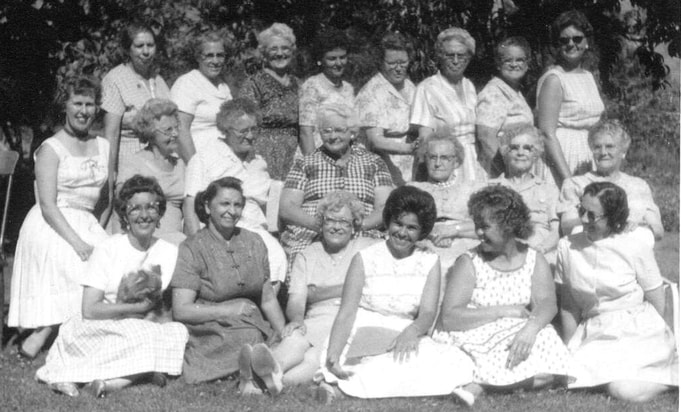
At Elizabeth Buck's 75th birthday party in 1963. Seated, left to right: Berdean Christensen. Ruth Smith. Lilian Freston, Mary Anderson, Cleo Peterson, Georgia Maen Stewart. Second Row: Rosa Lee Parkins, Theor Logan, Kate Kelly, Lillian Cole, Ivy Low, Elizabeth Buck, Elsie Christensen. Third Row: Jeannie Holton, Phyllis Penman, Jessie Keeley, Beth Jensen, Irba Sealey, Violet Zabel, Winnie Kerschaum, LaVern Burnett (The Silent Worker, January 1964)
The Ogden Branch Relief Society for
the Deaf has been Organized
the Deaf has been Organized
Lola Elizabeth Harris Jensen, known as Beth, a Deaf Latter-day Saints member of the Ogden Branch, wrote a brief history of how the Relief Society was formed at the Ogden Branch for the Deaf on November 6, 1955. During the summer of 1955, the sisters of the branch seemed to need some means of getting together to share ideas and skills, plus how to cope with children and homemaking problems, and this was evident to Branch President Max W. Woodbury and Beth. A remark from one of the sisters about the need for a Relief Society organization in the branch prompted her to ask Branch President Woodbury why this was not the case. He stated that multiple attempts to establish a Relief Society organization had yet to be successful due to the inadequate response to this endeavor. He then detailed the requirements for forming a Relief Society organization and assured its success.
Following Branch President Woodbury's advice, Beth convened with the sisters in the branch to share her vision of the Relief Society program. The sisters embraced the idea with enthusiasm. With Branch President Woodbury's permission, they began meeting at the branch twice a month to sew, chat, exchange ideas and patterns, and enjoy a meal together. The sisters' response was overwhelming, and they soon expressed a desire to meet every week, a wish that was granted. Encouraged by their camaraderie, they decided to host a bazaar and embarked on the task of quilt-making.
After a series of meetings since August 24, 1955, the Ogden Branch experienced a significant turnout, indicating the strong desire of the sisters to have a Relief Society organization. With her leadership and dedication, Beth took the initiative to meet with Branch President Woodbury, where she conveyed their collective wishes and provided a detailed report on their activities, assuring him they could meet the requirement of having eight faithful members as officers. In response, Branch President Woodbury agreed to present their goals to the Ogden Stake Presidency.
After a series of meetings since August 24, 1955, the Ogden Branch experienced a significant turnout, indicating the strong desire of the sisters to have a Relief Society organization. With her leadership and dedication, Beth took the initiative to meet with Branch President Woodbury, where she conveyed their collective wishes and provided a detailed report on their activities, assuring him they could meet the requirement of having eight faithful members as officers. In response, Branch President Woodbury agreed to present their goals to the Ogden Stake Presidency.
On the historic day of November 6, 1955, Branch President Max W. Woodbury organized the Relief Society of the Ogden Branch for the Deaf. Lola Elizabeth (Beth) Harris Jensen became the first Relief Society president, with Violet Zabel and Berdean Christensen serving as her counselors. Beth appointed additional sisters based on their dedication to the Ogden Branch for the Deaf and their willingness to serve. These sisters participated in the Relief Society meetings, where they learned homemaking skills, taught lessons, planned bazaars, prepared branch dinners, fundraised for the Ogden Branch, and participated in signed songs in various wards. (Lola Elizabeth Jensen, History of the Relief Society of the Ogden Branch for the Deaf; UAD Bulletin, June 1974).
Lola Elizabeth Jensen, President
Violet Zabel, 1st Counselor
Berdean Christensen, 2nd Counselor
Fawn Woodward, Secretary
Lucy Greenwood, Theology Teacher
Marie Allen, Homemaking Teacher
Afton Burdett, Literature Teacher
Orba Seeley, Social Relations Teacher (Lola Elizabeth Jensen, History of the Relief Society of the Ogden Branch for the Deaf).
Since 1955, the membership has grown from eleven members to forty-four members in 1974. The meetings were held on Tuesdays at 10:30 a.m., and there was an average attendance of 15-20 women. In 1974, the second section of Relief Society was held on Sunday mornings, providing an opportunity for "career" women to attend the meeting while their husbands attended the Priesthood meeting (Jensen, UAD Bulletin, June 1974).
Beth wrote in the June 1974 UAD Bulletin that the organization's meetings are intended to be enjoyable and beneficial. The goal is to inspire attendees to return and learn more about various topics such as other countries, family nutrition, mothers' education, and spiritual upliftment in the Relief Society. The activities, which include quilting, bread-making, embroidery, knitting, crocheting, bargello, and macrame, are not only for fun but also for the practical skills they impart, making homemaking day a truly empowering experience (Jensen, UAD Bulletin, June 1974). Today, deaf branches and wards nationwide have established a Relief Society, providing a support group for everyone involved.
Lola Elizabeth Jensen, President
Violet Zabel, 1st Counselor
Berdean Christensen, 2nd Counselor
Fawn Woodward, Secretary
Lucy Greenwood, Theology Teacher
Marie Allen, Homemaking Teacher
Afton Burdett, Literature Teacher
Orba Seeley, Social Relations Teacher (Lola Elizabeth Jensen, History of the Relief Society of the Ogden Branch for the Deaf).
Since 1955, the membership has grown from eleven members to forty-four members in 1974. The meetings were held on Tuesdays at 10:30 a.m., and there was an average attendance of 15-20 women. In 1974, the second section of Relief Society was held on Sunday mornings, providing an opportunity for "career" women to attend the meeting while their husbands attended the Priesthood meeting (Jensen, UAD Bulletin, June 1974).
Beth wrote in the June 1974 UAD Bulletin that the organization's meetings are intended to be enjoyable and beneficial. The goal is to inspire attendees to return and learn more about various topics such as other countries, family nutrition, mothers' education, and spiritual upliftment in the Relief Society. The activities, which include quilting, bread-making, embroidery, knitting, crocheting, bargello, and macrame, are not only for fun but also for the practical skills they impart, making homemaking day a truly empowering experience (Jensen, UAD Bulletin, June 1974). Today, deaf branches and wards nationwide have established a Relief Society, providing a support group for everyone involved.
References
Jensen, Lola Elizabeth. History of the Relief Society of the Ogden Branch for the Deaf.
Jensen, Lola Elizabeth. "Past and Present of Relief Societies Given: Ogden Branch." UAD Bulletin, June 1974, vol. 9., no. 3, p. 6-7.
Hansen, Virginia and Eyre, Vera. "Past and Present of Relief Societies Given: S.L. Valley Ward." UAD Bulletin, June 1974, vol. 9., no. 3, p. 7.
History of the Relief Society at the Ogden Branch for the Deaf in 1949.
Jensen, Lola Elizabeth. "Past and Present of Relief Societies Given: Ogden Branch." UAD Bulletin, June 1974, vol. 9., no. 3, p. 6-7.
Hansen, Virginia and Eyre, Vera. "Past and Present of Relief Societies Given: S.L. Valley Ward." UAD Bulletin, June 1974, vol. 9., no. 3, p. 7.
History of the Relief Society at the Ogden Branch for the Deaf in 1949.
WEBSITES
The websites below provide
a list of Anne Leahy and Doug Stringham's presentations and current research
a list of Anne Leahy and Doug Stringham's presentations and current research
I want to thank Dr. Anne Leahy and Doug Stringham, our dedicated researchers in Deaf Latter-day Saints Community History. Their extensive research on the history of the Deaf Latter-day Saints community of The Church of Jesus Christ of Latter-day Saints, as well as the early history of the Utah School for the Deaf, is a valuable source of information. I encourage you to visit the following websites, which feature their presentations and current findings on the Deaf Latter-day Saints community.
Enjoy!
Jodi Becker Kinner
Enjoy!
Jodi Becker Kinner
- Rediscovering the History of Deaf Latter-day Saints: http://history.deaflds.org/
- How Firm a Foundation: The Latter-day Saint Deaf-Mute Sunday School: https://www.academia.edu/1835979/How_Firm_a_Foundation_The_Latter-day_Saint_Deaf- Mute_Sunday_School
- 'God Made Me Deaf': Accounts from Deaf Latter-day Saints, 1836-1916: www.academia.edu/1835974/God_Made_Me_Deaf_Accounts_from_Deaf_Latter-day_Saints_1836-1916
- Recovering From Failed Healings: https://www.academia.edu/7302314/Recovering_Mormonism_from_Failed_Healings
HISTORICAL DOCUMENT
- Horn-Marsh, Petra M (1992). "Silent Saints: Deaf Mormons in Utah." All Graduate Theses and Dissertations. Paper 1688. http://digitalcommons.usu.edu/etd/1688/
ARCHIVES
- Ogden Branch for the Deaf Minutes - 1941 - 1945. (PDF)
- Flygare, Christopher. "Powerpoint of the Salt Lake Valley 1st and 2nd Deaf Wards: A History in Pictures." (PDF)
VIDEO
Giles, Bobby. "Ogden Branch for the Deaf: 90th Anniversary 1917 – 2007." Eye-Sign Media, LLC. 2007. DVD.
A Slideshow of the
Ogden Branch for the Deaf
A Slideshow of the
Salt Lake Valley Branch and Ward
Salt Lake Valley Branch and Ward

